List of opera houses / Europe
This list is a subpage of the list of opera houses . Well-known opera houses in Europe are listed .
Opera houses in Europe
Albania
| place | Opera house | Details | Official website | image |
|---|---|---|---|---|
| Tirana | Teatri i Operas dhe Baletit | The Teatri i Operas dhe Baletit opened in 1953 with a performance of the opera Rusalka by Antonín Dvořák . | Website |

|
Armenia
| place | Opera house | Details | Official website | image |
|---|---|---|---|---|
| Yerevan | Spendiarjan operas and ballet theater | The Spendiarjan Opera and Ballet Theater (Armenian: Ալեքսանդր Սպենդիարյանի անվան օպերայի և բալետի ազգային ակադեմիական թատրոն) in Yerevan was officially opened on January 20, 1933 with the opera Almast by Aleksandr Spendiarjan . The opera building was designed by the Armenian architect Alexander Tamanjan . It consists of two concert halls: the Aram Khatchaturian Concert Hall with 1,400 seats and the Spendiarjan Opera and Ballet Theater with 1,200 seats. | Website |

|
Azerbaijan
| place | Opera house | Details | Official website | image |
|---|---|---|---|---|
| Baku | Azerbaijan State Academic Opera and Ballet House | The Azerbaijan State Academic Opera and Ballet House (actually Azerbaijan State Academic Axundov Opera and Ballet House ; Azerbaijani : Axundov adına Azərbaycan Dövlət Akademik Opera və Balet Teatrı ) is an opera house in the Azerbaijani capital of Baku.
The Opera and Ballet House was founded in 1920, and as the National Opera and Ballet, it is a cultural institution of Azerbaijan. Institutionally, it is part of the Ministry of Culture and Tourism of Azerbaijan. |
Website |

|
Belgium
| place | Opera house | Details | Official website | image |
|---|---|---|---|---|
| Antwerp | Ministry of Operatic Affairs | The Ministry of Operatic Affairs is an opera company based in Antwerp. | Website |
|
| Antwerp | Muziektheater Transparant | The Muziektheater Transparant is a Flemish theater company from Antwerp that was founded in 1994. | Website |
|
| Antwerp | Flemish Opera | The Vlaamse Opera ( Flemish Opera ) is an opera institution in Belgium based in the cities of Antwerp and Ghent. She is from the
The merger of the Flemish opera houses Antwerp and Ghent in 1988, which has since shared the orchestra, choir and ensemble. The name of the merged stage was initially Opera voor Vlaanderen ( Opera for Flanders ) until 1995 . The current building of the Koninklijke Vlaamse Opera Antwerp was commissioned in 1899 and opened in 1907. The architectural design is by Alexis Van Mechelen and Emiel Van Averbeke and is in neo-baroque style XVI Louis- established. It can accommodate a good thousand visitors. |
Website |

|
| Bilzen | Zomeropera Alden Biesen | The Zomeropera Alden Biesen organizes an opera festival every year in May - June with the aim of introducing the genre of opera to the general public in the province of Limburg and beyond the borders of the province of Limburg. | Website |
|
| Brussels | Brussels Opera House La Monnaie / De Munt | The Théâtre Royal de la Monnaie or La Monnaie for short (in French ) or De Koninklijke Muntschouwburg , or De Munt for short (in Dutch ; German for example: Königliches Theater an der Münze), is the royal Brussels Opera House.
Today, the Monnaie Theater is one of the most renowned opera houses in Europe, especially since Maurice Béjart created a sensation in 1960 with the Ballet du XX e siècle , the Ballet of Monnaie, which he founded, and Gerard Mortier was director general from 1982 to 1992. |
Website |
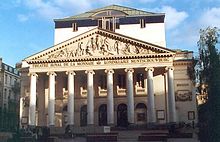
|
| Ghent | LOD muziektheater | The LOD muziektheater is a theater house for opera and music theater in Ghent. | Website |
|
| Ghent | Flemish Opera | The Vlaamse Opera ( Flemish Opera ) is an opera institution in Belgium based in the cities of Antwerp and Ghent. She is from the
The merger of the Flemish opera houses Antwerp and Ghent in 1988, which has since shared the orchestra, choir and ensemble. The name of the merged stage was initially Opera voor Vlaanderen ( Opera for Flanders ) until 1995 . The Koninklijke Opera van Gent was built in 1840 according to plans by Louis Roelandt. In addition to the Great Hall, the house has three other rooms that can be used for conferences and banquets: the foyer, the redoubt and the hall named after Jean-Baptiste Lully . Its monumental French architecture leads to the great hall where operas and ballets are staged and concerts and congresses take place. |
Website |

|
| Heist-op-den-Berg | Vlaams Muziek Theater | The Vlaams Muziek Theater (German: Flemish Music Theater) is an operetta and musical theater in Heist-op-den-Berg . | Website |
|
| Liege | Opéra Royal de Wallonie | The Opéra Royal de Wallonie (formerly Théâtre royal de Liège ) is the theater of the city of Liège in Belgium and one of the four opera houses in the country alongside La Monnaie and the two buildings of the Vlaamse Opera .
The foundation stone for the opera house was laid in July 1818. It was built according to a design by the architect Auguste Duckers. The theater has a classical architecture. The main facade is shaped by a marble colonnade and bordered by a balustrade that adorns a towering gable . The Théâtre Royal de Liège opened on November 4, 1820 and became the property of the city in 1852. |
Website |

|
Bosnia and Herzegovina
| place | Opera house | Details | Official website | image |
|---|---|---|---|---|
| Sarajevo | Sarajevo National Theater | The National Theater Sarajevo (Bosnian and Serbian: Narodno pozorište Sarajevo , Народно позориште Сарајево, Croatian: Narodno kazalište Sarajevo ) opened in November 1921.
The building was designed by the architect Karel Pařík, who designed over 160 other buildings in Sarajevo. |
Website |

|
Bulgaria
| place | Opera house | Details | Official website | image |
|---|---|---|---|---|
| Burgas | Burgas State Opera | The State Opera Burgas is an opera house in Burgas. | Website |
|
| Plovdiv | Plovdiv State Opera | The Plovdiv State Opera is an opera house in Plovdiv. | Website |
|
| Russian | Russian State Opera | The Ruse State Opera is an opera house in Ruse. | Website |
|
| Sofia | National Opera and Ballet Theater Sofia | The National Opera and Ballet Theater Sofia (Bulgarian: Национална опера и балет) is an institution for opera and ballet performances in the Bulgarian capital Sofia.
Bulgaria's first opera house was founded in 1890, but quickly closed again due to limited financial resources. The Bulgarian Opera Society was founded in 1908, and in 1922 it was nationalized. In 1922 its name was changed to National Opera, and its first performances took place in 1928. It was closed during the Second World War, but soon after the war it was reopened, including restoration work, thanks to government subsidies. The Sofia National Opera and Ballet Theater received its architectural design in 1921 and was renovated in 1953. |
Website |

|
| Stara Sagora | State Opera Stara Sagora | The State Opera Stara Sagora is an opera house in Stara Sagora. | Website |
|
| Varna | Varna State Opera | The Varna State Opera is an opera house in Varna. | Website |
|
Denmark
| place | Opera house | Details | Official website | image |
|---|---|---|---|---|
| Aarhus | Aarhus Chamber Opera | The Aarhus KammerOpera is an opera house in Aarhus. |
|
|
| Aarhus | The Jyske Opera | Den Jyske Opera was founded in 1947 and is based in Aarhus. It is one of the largest opera companies in Denmark. The ensemble staged two operas a year until 1977. It then worked with five provincial orchestras and staged around 100 performances per season. Den Jyske Opera has been based in Musikhuset Aarhus since 1982 and tours - sponsored by the Danish Ministry of Culture - throughout Denmark to stage both traditional and innovative operas. | Website |
|
| Esbjerg | The Ny Opera | Den Ny Opera is an opera house in Esbjerg. | Website |
|
| Hedehusene | Opera Hedeland | The Opera Hedeland is an amphitheater and Denmark's largest permanent outdoor theater. It is located in the Hedeland Nature Park between Hedehusene and Roskilde . | Website |

|
| Copenhagen | Det Kongelige Teater |
Det Kongelige Teater (German Royal Danish Theater ) is the Danish state theater in Copenhagen. Since 1748 it has been owned by the town's parlor, Kongens Nytorv . The Kongelige Teater consists of the four sections drama, opera, ballet and concert.
Opera, ballet and concert form a separate unit as the Royal Danish National Opera . The orchestra of this institution, the Royal Chapel of Copenhagen , was first mentioned in documents in 1448 on the occasion of Christian I's coronation and is therefore considered the oldest orchestra in Europe. |
Website |
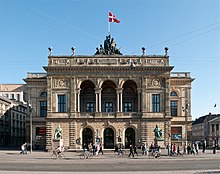
|
| Copenhagen | Operas | The Royal Opera ( Danish Operaen ) on the island of Holmen in Copenhagen is the Danish national opera and one of the most modern stages in the world. Institutionally, it is part of the Royal Theater .
The house is a donation from Mærsk Mc-Kinney Møller and the “AP Møller and Chastine Mc-Kinney Møller Foundation” to the Danish state. The building was designed by Henning Larsen . Construction began in June 2001 and was completed on October 1, 2004. The opera house opened on January 15, 2005 with a special concert. The first opera performance, Verdi's Aida , took place on January 26, 2005. |
Website |

|
| Odense | The Fynske Opera | The the Funen Opera is an opera company from Odense. It started in 1948 with a successful presentation of La Bohème and 16 years later had to stop its work due to insufficient support. It was re-founded in 1996 by Lars Waage, who worked as Creative Director until 2007 . The main sponsor of Den Fynske Opera is the city of Odense. | Website |
|
| Odense | Odense Concert Hall | The Odense Concert Hall is a concert hall in Odense. | Website |

|
| Skørping | Det Nordjyske Operakompagni | Det Nordjyske Operakompagni is an opera company based in North Jutland. The ensemble was founded in 1990 on the initiative of a number of singers and teachers at the Nordjysk Conservatory. | Website |
|
Germany
| place | Opera house | Details | Official website | image |
|---|---|---|---|---|
| Aachen | Theater Aachen | The Theater Aachen is a cultural institution for drama and music theater opened in 1825 in the city of Aachen. It follows on from the no longer representative old comedy house at Katschhof , the first public theater in Aachen built in 1751 by Johann Joseph Couven . In 1920 the previously independent Aachen Symphony Orchestra was affiliated with the theater .
The current two-part house is located in a classical building complex designed by Karl Friedrich Schinkel and Johann Peter Cremer on Aachen's Kapuzinergraben. |
Website |

|
| Altenburg | Altenburg State Theater | The Landestheater Altenburg is a multi-branch theater in Altenburg as part of the Theater & Philharmonie Thuringia . The big house with almost 500 seats as well as the boiler house and the theater under the roof are used as venues . | Website |

|
| Annaberg-Buchholz | Eduard-von-Winterstein-Theater | The Eduard-von-Winterstein-Theater (also: Annaberger Stadttheater ) is a theater in Annaberg-Buchholz in the Ore Mountains.
The house was opened on April 2, 1893 as Neues Stadt-Theater-Annaberg , was initially owned by a theater community and in 1919 became the property of the Annaberg city administration and was renamed the Städtebundtheater . Since then the name of the house has changed several times. The theater is run as a two-part house and offers music theater and drama. The orchestra is the Erzgebirgische Philharmonie Aue , which, like the Eduard-von-Winterstein-Theater, operates under the umbrella of the "Erzgebirgische Theater und Orchester GmbH". |
Website |
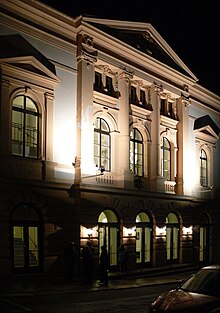
|
| augsburg | Theater Augsburg | The Augsburg Theater is owned by the city of Augsburg, which emerged in 1999 from the four-division house Städtische Bühnen Augsburg . It is the largest of the theaters in Augsburg and operates four venues. | Website |

|
| Bad Aibling | Bad Aibling opera stage | The Bad Aibling opera stage is an opera stage in Bad Aibling . | Website |
|
| Baden-Baden | Baden-Baden Festival Hall | The Festspielhaus Baden-Baden is an opera and concert hall in the Baden-Württemberg city of Baden-Baden. With 2500 seats, it is Germany's largest such house. The Festspielhaus, which opened in 1998, does not have its own ensemble. The operation of operas, concerts and ballet performances by internationally renowned artists and ensembles is financed by a private foundation. In addition to four annual festival phases and additional individual events from classical music, upscale entertainment and jazz, concerts of the New Pop Festival are also held here. | Website |

|
| Bautzen | German-Sorbian People's Theater | The German-Sorbian People's Theater ( Sorbian : Němsko-serbske ludowe dźiwadło ) in Bautzen is the only professional bicultural theater in Germany. It is an important institution of Sorbian , German and German-Sorbian culture. | Website |

|
| Bayreuth | Richard Wagner Festival Theater | The Richard-Wagner-Festspielhaus , also called Festspielhaus Bayreuth , is a festival hall on the Green Hill in Bayreuth. It was built in the years 1872–75 by Otto Brückwald based on designs by Richard Wagner in the style of Hellenistic Romanticism . Unlike many opera houses, it does not have a permanent ensemble and is performed every year from July 25th to August 28th as part of the Bayreuth Festival with operas and musical dramas by Wagner in 30 performances. It is considered to be one of the opera houses with the world's best acoustics. | Website |

|
| Bayreuth | Margravial Opera House | The Margravial Opera House in the Upper Franconian city of Bayreuth is an 18th century theater building . On June 30, 2012, UNESCO declared the baroque building a World Heritage Site . | Website |

|
| Berlin | German Opera Berlin | The Deutsche Oper Berlin is the largest of the three opera houses in Berlin. The building at Bismarckstrasse 34–37 in Charlottenburg was opened in 1961 and was a replacement for the Deutsche Oper, which was destroyed in 1943 at the same location in World War II . The Charlottenburger Haus is one of the largest theaters in Germany with 1859 seats.
Together with the Staatsoper Unter den Linden , the Komische Oper , the Staatsballett and the Bühnenservice Berlin, the Deutsche Oper forms the Opera Foundation in Berlin . |
Website |

|
| Berlin | Komische Oper Berlin | The Komische Oper Berlin is an opera house on Behrenstrasse in the Mitte district ( Mitte district ) of Berlin. It is the smallest of the three Berlin operas and, together with the Deutsche Oper , the Staatsoper Unter den Linden , the Staatsballett Berlin and the Bühnenservice Berlin, is part of the Berlin Opera Foundation.
A special feature of the building is the simply designed outer facade, the modern foyer and the likewise modern foyer from the years of the reconstruction of the 1960s, which stand in stark contrast to the neo-baroque interior, which was largely undamaged during the Second World War . |
Website |

|
| Berlin | Kroll Opera | The Kroll Opera (also temporarily Kroll'scher conservatory or Kroll's establishment was) a complex of buildings near the Brandenburg Gate , on today's Berlin Republic Square . In the course of an eventful history, the complex served between 1844 and 1951 as an entertainment establishment, comedy stage , textile warehouse, opera house and, during the National Socialist era, as a substitute parliament for the Reichstag building that fell victim to an arson attack in 1933 . |

|
|
| Berlin | State Opera Unter den Linden | The State Opera Unter den Linden (also: German State Opera Berlin ) is the first opera house and the most important theater building in Berlin from a cultural and historical point of view. It is in the historic center on Unter den Linden boulevard . That is why in the vernacular also Lindenoper called building was part of the Forum Fridericianum and was the Royal Court Opera from 1741 to 1743 according to plans by Georg Wenceslaus von Knobelsdorff in the style of Palladian built. It was the first free-standing opera house in Germany and at that time the largest opera building in Europe. | Website |
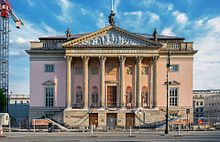
|
| Bielefeld | Bielefeld Theater | The Bielefeld Theater and the Bielefelder Philharmonic together form the stages and orchestras of the city of Bielefeld . The theater is a three-branch house with music theater, dance theater and drama. | Website |

|
| Bonn | Theater Bonn | The Bonn Theater , also known as the Theater of the Federal City of Bonn, is the umbrella organization for the theater and opera establishments in the City of Bonn. It consists of the areas of opera, drama and dance. | Website |

|
| Brandenburg / Havel | Brandenburger Theater | The Brandenburger Theater ( BT for short ) is a theater in the city of Brandenburg an der Havel. The BT celebrated its 200th anniversary in the 2017/18 season , but has not had its own acting ensemble since the late 1990s. However, the Brandenburg Theater, among other things, is home to the Brandenburg Symphony Orchestra . The home venue is the CulturCongressCentrum of the city of Brandenburg. | Website |

|
| Brandenburg / Havel | CulturCongressCentrum | The CulturCongressCentrum is a culture and congress center in the city of Brandenburg an der Havel. It is the home of the Brandenburger Theater and with it the Brandenburger Symphoniker at the address Grabenstraße 14. | ||
| Braunschweig | State Theater Braunschweig | The Braunschweig State Theater is a five-division house in Braunschweig. Every year it shows around 30 premieres in the fields of drama, music theater (opera, operetta, musical), dance and in the field of children's and youth theater as a young state theater . The fifth division is the Braunschweig State Orchestra . There is no break in play, since every summer (since 2003) an open-air stage with around 1,200 seats is set up and played on Braunschweig's Burgplatz . In the big and small house there are also special performances in the block in summer. | Website |

|
| Bremen | Theater Bremen | The Theater Bremen is a public four-genre theater with the Bremen Opera , the spectacle of Bremen , the Tanztheater Bremen and the MOKS Bremen (pilot artists and students) in the city of Bremen. The four architecturally connected venues that belong to a street block form the different stages of the institution. They offer a total of up to 1426 spectators. In the field of music theater, the theater has been working with the Bremen Philharmonic Orchestra , which was founded in 1820 and in which it has a 22% stake, since 1917 . | Website |

|
| Bremerhaven | Bremerhaven City Theater | The Stadttheater Bremerhaven is a three-part house founded in 1867 in the center of Bremerhaven with performances of operas, operettas, musicals, plays and dance theater. The venue, built in 1911, was completely destroyed in the heavy bomb attack on the night of September 18, 1944 . Remnants of the Art Nouveau facade were integrated into the theater building, which was newly built in 1952. | Website |

|
| Chemnitz | Chemnitz Opera House | The Chemnitz Opera House is the main venue for the musical theater divisions of the Theater Chemnitz . It was built in Chemnitz from 1906 to 1909, the architect was Richard Möbius . It is located on the Theaterplatz , between the adjacent buildings of the King Albert Museum and the Petrikirche .
The opera house was badly damaged during the Second World War , but was rebuilt from 1947 to 1951. |
Website |
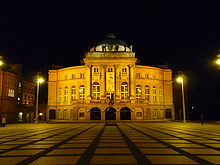
|
| Chemnitz | Chemnitz Theater | The Chemnitz Theater is a five-part theater in Chemnitz, Saxony. The five branches are opera, philharmonic orchestra, ballet, drama and puppet theater. | Website |

|
| Coburg | Coburg State Theater | The Landestheater Coburg is a medium-sized three-part theater (opera / operetta, drama, ballet) that is jointly supported by the city of Coburg and the Free State of Bavaria . The classicist building on Coburg Castle Square has 550 seats. | Website |
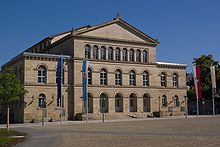
|
| cottbus | State Theater Cottbus | The Cottbus State Theater is the only state theater in Brandenburg . The four-part theater in Cottbus offers performances by its own ensembles for drama, music theater (opera, operetta, musical), orchestra and ballet. | Website |

|
| Darmstadt | Darmstadt State Theater | The Darmstadt State Theater is a four-division house with opera, dance, drama and concerts . The State of Hesse is responsible for the Darmstadt State Theater. The city of Darmstadt is involved in accordance with the theater contract dated November 24, 1971 in its current version with an operating subsidy of 48%. | Website |

|
| Dessau | Anhalt theater | The Anhaltisches Theater Dessau is a multi-part theater with drama, music theater (opera, operetta, musical), ballet, concert ( Anhalt Philharmonic ) and the Dessau puppet theater .
Today the theater has a capacity of around 1100 spectators and is equipped with one of the largest revolving stages in Germany. |
Website |

|
| Dessau | Puppet theater Dessau | The Dessau Puppet Theater is a puppet theater in Dessau-Roßlau and a division of the Anhaltisches Theater .
As a direct reaction to Obraszow's guest performance in the GDR , the city council of Dessau decided in 1954 to found a puppet theater under municipal management and took over the dolls and stage equipment of Rudolf Zilling's hand puppet theater. In 1981, the puppet theater was assigned as the fifth branch of the then state theater . |
Website |
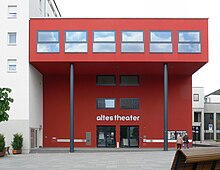
|
| Detmold | State Theater Detmold | The Landestheater Detmold is a three-part theater with five venues in Detmold. With its guest performances in more than a hundred locations in Germany and neighboring countries, the theater is considered the largest travel stage in Europe. | Website |

|
| Dortmund | Theater Dortmund | The Theater Dortmund with over 500 employees one of the largest theaters in Germany. It is divided into the five sections concert, music theater, drama, ballet and children's and youth theater , each of which is under its own artistic direction. | Website |

|
| Dresden | Royal Court Theater Dresden | The Royal Court Theater Dresden (also known as the Altes Hoftheater ) was the predecessor of today's Semperoper , which served between 1841 and 1869 as a house for opera and drama in the royal Saxon residence city of Dresden . |
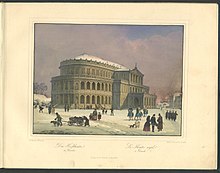
|
|
| Dresden | Opera house on Taschenberg | The opera house Taschenberg (also Klengel MOORISH Opera House or comedy house Taschenberg ) was a theater building in Dresden. The first Dresden opera house, built by Wolf Caspar von Klengel from 1664 to 1667 , held up to 2000 visitors and was one of the largest European theaters of its time. The diverse rededication of the building is remarkable. Already about 40 years after its opening, it was converted into a Catholic court chapel. Further usage phases as a ballroom and as an archive followed before it was demolished in 1888. |

|
|
| Dresden | Opera house at the Zwinger | The Opera House at the Zwinger was a theater building in Dresden. The three-tier theater, which opened in 1719, held up to 2000 visitors and was one of the largest European theaters of its time. The house experienced its heyday during the reign of the opera-loving Elector Friedrich August II under the direction of Johann Adolph Hasse . The last opera performance took place 50 years after the opening of the house, which was later used as a redoubt and concert hall. It burned down during the Dresden May uprising in 1849 and was then removed. |
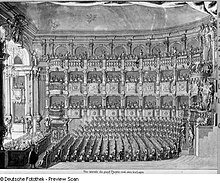
|
|
| Dresden | Semper Opera | The Semperoper in Dresden is the opera house of the Saxon State Opera Dresden , which has a long historical tradition as the court and state opera of Saxony . The orchestra of the State Opera is the traditional Saxon State Orchestra Dresden . The Semperoper is located on Theaterplatz in the historic city center of Dresden near the Elbe . It is named after its architect Gottfried Semper . | Website |

|
| Dresden | Dresden State Operetta | The Dresden State Operetta is the only independent operetta theater in Germany. Contrary to its historical name, it is owned by the city of Dresden and was founded in 1947 with a first forerunner, the “Apollo Theater” in Dresden- Leuben . The theater has been located on the site of the former Mitte power station in the Wilsdruffer Vorstadt district since December 2016 . In addition to operettas, game operas and musicals are on the program in the 700-seat auditorium. | Website |
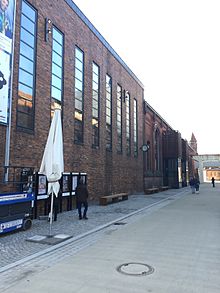
|
| Duisburg | Theater Duisburg | The Duisburg Theater in downtown Duisburg was built between 1911 and 1912 in neoclassical style based on a design by the architect Martin Dülfer and has 1,117 seats. It is a venue of the Deutsche Oper am Rhein , a theater association founded in 1956 by the cities of Duisburg and Düsseldorf.
The theater does not have its own theater ensemble, but works closely with regional theaters such as the Schauspielhaus Bochum or the “Theater an der Ruhr” in Mülheim an der Ruhr , which is only a few kilometers away . The theater's Philharmonic Orchestra, the Duisburg Philharmonic , has existed since 1877. |
Website |

|
| Dusseldorf | German Opera on the Rhine | The Deutsche Oper am Rhein Düsseldorf Duisburg gGmbH is a theater community of the cities of Düsseldorf and Duisburg, which has a long tradition of cooperation between the two major cities and, in addition to opera and operetta / musical, also performs ballet. It has the largest opera ensemble in Germany and, uniquely in Germany, two main stages (Düsseldorf Opera / Duisburg Theater) and two symphony orchestras (Duisburg Philharmonic / Düsseldorf Symphony). The company is a horizontally mixed public company .
In 1955, the neighboring cities signed a contract for the formation of the opera. The theater community began on September 28, 1956 with the 1956/1957 season. |
Website |

|
| Dusseldorf | Düsseldorfer Schauspielhaus | The Düsseldorfer Schauspielhaus , or D'haus for short , is an ensemble theater in the North Rhine-Westphalian capital of Düsseldorf. The theater building on Gustaf-Gründgens-Platz was built according to plans by the Düsseldorf architect Bernhard Pfau as a speaking theater commissioned by the city of Düsseldorf between 1965 and 1969. The large sculptural form stands in exciting contrast to the neighboring Dreischeibenhaus and is therefore characterized by a special urban quality. The construction, which in the post-war Modern the organic architecture can be allocated to hosts with the big house and the small house two venues of high acoustic and technical level. The Schauspielhaus Düsseldorf is the only state theater in the state of North Rhine-Westphalia . | Website |

|
| Dusseldorf | Opera House Düsseldorf | The building of the Düsseldorf Opera House is located at Heinrich-Heine-Allee 16a in Düsseldorf. With a 22.5 × 14.75 meter stage, the opera house now offers space for 1342 people. The Deutsche Oper am Rhein plays in the building . | Website |

|
| Eggenfelden | Theater an der Rott | The Theater an der Rott is located in the Lower Bavarian town of Eggenfelden and is the only district-owned theater in Germany. The responsible body is the Rottal-Inn district . | Website |
|
| Eisenach | State Theater Eisenach | The Landestheater Eisenach is a theater in the Thuringian city of Eisenach. It has the divisions ballet and young drama. Transferred to the Meiningen-Eisenach Cultural Foundation with effect from January 1, 2009 and since then partially played by the Meiningen State Theater , it offers operas, operettas, musicals, ballet / dance theater, drama, youth and children's theater, puppet theater and concerts in its repertoire. | Website |
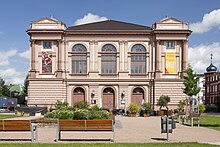
|
| Erfurt | Theater Erfurt | The Theater Erfurt is a publicly sponsored theater of the Thuringian capital Erfurt. The main venue is the new building completed in September 2003 in the Brühlervorstadt district , located between the Domberg and the baroque fortress of the Petersberg .
The theater's program focuses on a wide range of musical theater and concerts on the large stage with 800 seats and the studio stage with 200 seats. It is played by the Erfurt Philharmonic Orchestra , which belongs to the theater . Dance and drama guest performances are also offered. The Erfurt Theater is also the organizer of the annual DomStufen Festival . |
Website |
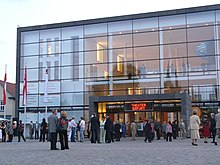
|
| gain | Margrave Theater | The Markgrafentheater in the Middle Franconian city of Erlangen is the oldest baroque theater in southern Germany. The listed building is now one of three venues for Das Theater Erlangen . | Website |
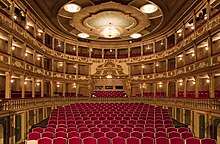
|
| eat | Aalto Theater | The Aalto-Theater has been the opera house of the city of Essen since 1988 and is located in the north-eastern part of the Essen city garden in the southern district .
In addition to the performance of operas and operettas, the Aalto Theater also hosts musicals, concerts and ballet and is the venue for the Aalto Music Theater , the Aalto Ballet Theater Essen and the Essen Philharmonic . |
Website |

|
| Flensburg | Schleswig-Holstein State Theater and Symphony Orchestra | The Schleswig-Holstein State Theater and Symphony Orchestra GmbH is the largest state theater in Germany and is based in Rendsburg with venues in Flensburg, Schleswig , Rendsburg, Itzehoe , Neumünster , Heide , Husum , Meldorf , Niebüll and St. Peter-Ording . The stage's program includes music theater, ballet and drama, as well as children's and youth theater (including mobile classroom productions) and puppet theater. | Website |
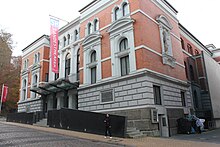
|
| Frankfurt | Old opera | The Alte Oper on Opernplatz in Frankfurt am Main is a former opera house and is now used as a concert and event venue.
The building was designed by the Berlin architect Richard Lucae in the neo-renaissance style and completed by Albrecht Becker and Edgar Giesenberg after his early death in 1877 . In 1880 the building, financed by the city of Frankfurt, was opened with Mozart's opera Don Giovanni . |
Website |

|
| Frankfurt | Frankfurt Opera | The Frankfurt Opera , the Music Theater of the Municipal Theater in Frankfurt. It is one of the most important musical theaters in Europe and was named Opera House of the Year in 1995, 1996, 2003 and 2015 by Opernwelt magazine .
The Frankfurt Opera has had its venue on Willy-Brandt-Platz , the former Theaterplatz , since 1951 . The Frankfurt Opera and Museum Orchestra is the permanent orchestra of the house. |
Website |

|
| Freiberg | Central Saxon theater | The Central Saxon Theater emerged in 1993 as the Central Saxon Theater and Philharmonic gGmbH from the merger of the Stadttheater Freiberg and Döbeln . It comprises the areas of drama, musical theater and philharmonic orchestra. | Website |
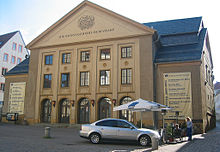
|
| Freiburg | Freiburg Theater | The Freiburg Theater (partly also Stadttheater Freiburg , formerly the Städtische Bühnen Freiburg ) is the oldest and largest theater in the city of Freiburg im Breisgau. It is located on the edge of Freiburg's old town on the corner of Bertoldstraße and Platz der Alten Synagoge . The building combines four venues under one roof: the big house, the small house, the chamber stage and the workshop. In the winter foyer there are also readings by authors such as the Litera Tour , current lecture evenings such as the School Dreams series and chamber concerts . The theater is called since September 2005 Eigenbetrieb out. | Website |

|
| Fuerth | City Theater Fürth | The Stadttheater Fürth stands in the middle of Fürth, between the Frauenkirche and the town hall. It was built in the years 1901 and 1902 according to plans by the Viennese architects Fellner & Helmer in neo-baroque style. The interior decoration follows the style of the neo-coco . | Website |

|
| Gelsenkirchen | Music theater in the district | The Musiktheater im Revier (MiR) on Kennedyplatz in Gelsenkirchen is one of the most important theater buildings of the post-war period . The complex with two venues, the large and the small house, built under the leadership of the architect and urban planner Werner Ruhnau , was opened on December 15, 1959, after a construction period of 41 months, and has since been performing operas, musicals, symphony concerts and ballet performances by the ballet im District.
A total of around 250 performances take place annually in the big house with 1004 seats and a stage area of 450 m², in the small house with 336 seats and a stage space of 180 m². |
Website |

|
| Gera | Stages in the city of Gera | The stages of the city of Gera (also Theater Gera ) are a multi-branch theater in the city of Gera, which belongs to Theater & Philharmonie Thuringia . The main venue and one of three theater buildings in this city is the Great House . It has a theater hall with 550 seats and a concert hall with 812 seats. | Website |
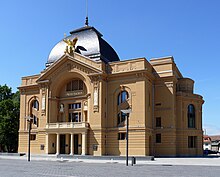
|
| to water | City Theater Giessen | The Stadttheater Gießen on Berliner Platz in Gießen is a three-part house with a national presence, one of the cultural centers and one of six large subsidized theaters in Hesse . The free-standing classicist, but partly Art Nouveau- influenced building was built in 1907 by the architects Fellner & Helmer . On two stages and a total of 652 (Large House) and 99 (taT) seats, it offers a diverse repertoire of operas, musicals and operettas, classical and contemporary drama and modern dance theater. | Website |

|
| Goerlitz | Görlitz Theater | The Görlitz Theater is a theater building for opera and drama in the East Saxon city of Görlitz. The building is popularly known as the Kleine Semperoper because of the opulent interior . | Website |

|
| Greifswald | Theater Western Pomerania | The Theater Vorpommern is a theater operated in the legal form of a GmbH . The partners are the cities of Stralsund, Greifswald and Putbus. The Vorpommern theater offers musical theater, drama, ballet and concerts. In addition to the performances in the main houses, there are also open-air performances every year. | Website |
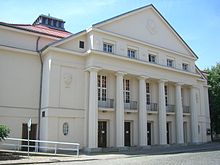
|
| Hagen | Theater Hagen | The Hagen theater was inaugurated as a municipal theater on October 5, 1911 and is located in the historic building in downtown Hagen. With around 180,000 visitors a year and a focus on music theater, the theater is one of the landmarks and cultural attractions known beyond the city. | Website |
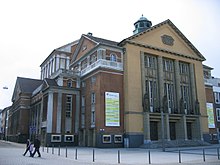
|
| Halberstadt | North Harz City Theater | The Nordharzer Städtebundtheater is a three-part house in the Harz region in Saxony-Anhalt . The stage business emerged in 1992 from the merger of the Stadttheater in Quedlinburg and the Volkstheater in Halberstadt and has since been run under joint business management and artistic management.
A total of four stages will be used in both cities. In summer there are also performances in the famous Thale mountain theater , on the Waldbühne in Altenbrak , in the moated castle Westerburg and on numerous other stages in the Harz region. All branches of the Nordharzer Städtebundtheater also give guest performances throughout the whole of Germany and in some cases beyond. |
Website |
|
| Halle (Saale) | Opera House Hall | The Halle an der Saale City Theater, which opened in 1886 (built according to a design by the architect Heinrich Seeling and the engineer Stumpf), is now the Halle Opera House . At the time of its opening, the city theater was next to the Budapest Opera the technically most modern theater in Europe. | Website |

|
| Hamburg | Elbphilharmonie | The Elbphilharmonie (also called " Elphi " or " Elbphi " for short ) is a concert hall in Hamburg that was completed in November 2016 . It was planned with the aim of creating a new landmark for the city and a “cultural monument for everyone”. The 110 meter high building on the right bank of the Norderelbe stands near the confluence of the Alster and the Elbe in the west of Hamburg's HafenCity district and was built on the western tip of the Elbe island Grasbrook , incorporating the shell of the former Kaispeicher A (built in 1963). A modern structure with a glass facade was placed on this base, reminiscent of a sail , water waves or a quartz crystal . The location at Kaiserhöft is characterized by the former industrial port use between the former port basin and the classic warehouse district made of bricks. | Website |

|
| Hamburg | Hamburg Chamber Opera | The Allee Theater in Hamburg-Altona is home to the Theater für Kinder , a privately run children's theater founded in 1968 . Since 1996 the Hamburg Chamber Opera has been playing there under the same direction in the Stagionesystem and with two new productions per season chamber operas for adults. | Website |

|
| Hamburg | Hamburg State Opera | The Hamburg State Opera on Gänsemarkt in Hamburg's Neustadt district is one of the world's leading opera houses and looks back on over 300 years of history. The Hamburg State Opera, the Hamburg Philharmonic State Orchestra and the Hamburg Ballet are housed under its roof . | Website |
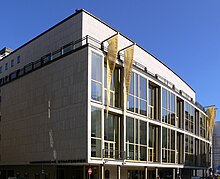
|
| Hamburg | Operettenhaus | The Operettenhaus is a theater on Spielbudenplatz in Hamburg.
The theater was opened in 1841 based on the model in Vienna under the name Circus Gymnasticus with 3000 seats. In 1864 the name was changed to Central-Halle . The building burned down in 1876, but was reopened a year later. Today's Musical Theater was given the name Operettenhaus Hamburg in 1920. In 2007 the Operettenhaus Hamburg was renamed TUI-Operettenhaus , and in December 2014 it was renamed Stage Operettenhaus . |
Website |

|
| Hamburg | Opera Loft | The Opernloft is a stage in Hamburg whose aim is to make it easier for children, young people and opera newbies to get started in the opera genre . The name Opernloft results from the program (opera) and the original location in a converted factory floor, i.e. a loft . | Website |
|
| Hamburg | Opera at the Gänsemarkt | Hamburg's Oper am Gänsemarkt was the first and most important bourgeois-city theater in the German-speaking area from 1678 to 1738. The inauguration of the house took place on January 2, 1678 . With two thousand seats, it surpassed any contemporary theater space. Afterwards it served as a stage for mobile opera troupes like that of Pietro Mingotti. It was not until 1765 that the now vacant and dilapidated house was torn down and the German National Theater was built in its place , where Gotthold Ephraim Lessing worked as a dramaturge for three years in 1767 . |

|
|
| Hanover | Hanover Opera House | The Hanover Opera House is the venue for the opera, ballet and concert divisions of the Lower Saxony State Theater in Hanover.
The opera house was built as the "Royal Court Theater" in the years 1845–52 in the late Classicist style on the eastern edge of the old town on the former Wealden sandstone hill . The architect of the opera house was the court architect Georg Ludwig Friedrich Laves . The construction manager was his employee and later court architect Christian Heinrich Tramm . The first opera performance ( Mozart's Marriage of Figaro ) took place on September 5, 1852. During the Second World War the opera house was hit by incendiary bombs on July 26, 1943 during one of the Allied air raids on Hanover and burned to the ground. After the reconstruction in the historical style (according to the plans of the Hamburg architect Werner Kallmorgen ) it was put back into operation on November 30, 1950 with the performance of Richard Strauss ' Der Rosenkavalier . In 1970 the name was changed to " Lower Saxony State Theater Hanover ", which has been the sole sponsor of the State of Lower Saxony since 1992. The orchestra of the house is the Lower Saxony State Orchestra Hanover . |
Website |

|
| Hanover | Lower Saxony State Theater Hanover | The Lower Saxony State Theater Hanover is a multi-branch theater in Hanover sponsored by the State of Lower Saxony . | Website |

|
| Heidelberg | Heidelberg Theater and Orchestra | The Heidelberg Theater and Orchestra is a five-branch theater with opera, concerts, drama and dance as well as its own ensemble for children and youth theater. From the 2012/13 season onwards, the dance company Nanine Linning / Theater Heidelberg was again established at the Heidelberg Theater and Orchestra. The Philharmonic Orchestra of the City of Heidelberg has also been part of the theater since 2005 . | Website |
|
| Heilbronn | Stock theater | The Aktientheater was a theater building in Heilbronn. The building erected in 1817 and expanded in 1844 to include a stage was the forerunner of the Harmonie concert and congress center . The Heilbronn theater , which was given a new venue a little further north in 1913 , also goes back to the Aktientheater as a cultural institution . |
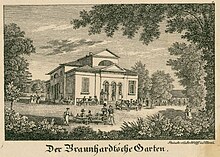
|
|
| Heilbronn | Old Theater (Heilbronn) | The old theater in Heilbronn (also known as the Fischer Theater ) is the predecessor of what is now the nearby “ Stadttheater Heilbronn ”. The building was constructed between 1911 and 1913 and damaged during World War II . As one of the first buildings in the city, the first reconstruction work began in 1947 under the architect Rudolf Gabel . Sculptor Robert Grässle renewed two mask heads on the parapet. After years of controversial discussion, the old building was blown up on July 18, 1970. |

|
|
| Heilbronn | Heilbronn Theater | The history of the Heilbronn Theater begins with the mention of the Aktientheater in the city garden in 1844. In 1912/1913 the old theater was built at the north end of the avenue / Berliner Platz , which was blown up in 1970. The current building of the Heilbronn City Theater was inaugurated in 1982 and expanded in 2001 to include the box theater in the neighboring "Theaterforum K3". | Website |
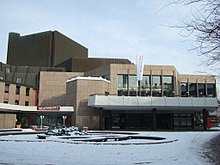
|
| Hildesheim | Theater for Lower Saxony | The Theater for Lower Saxony (TfN) is a theater that was created in September 2007 through the merger of the Hildesheim City Theater and the Hanover State Theater. | Website |

|
| court | Theater yard | The Theater Hof is a multi-discipline theater in the Bavarian town of Hof (Saale). As a four-branch house, it covers the areas of music theater, drama, ballet and young theater and is the main venue for the Hof Symphony Orchestra . | Website |

|
| Kaiserslautern | Pfalztheater | The Pfalztheater is maintained by the District Association Pfalz located only three-genre theater of Pfalz , based in the city of Kaiserslautern. | Website |

|
| Karlsruhe | Baden State Theater | The Badisches Staatstheater Karlsruhe is a multi-branch theater in Karlsruhe. It includes opera, ballet, concert, drama as well as the young state theater and popular theater divisions founded in 2011. The Badische Staatskapelle Karlsruhe and the Badische Staatsopernchor are connected to the theater . The house is the main venue for the annual Handel Festival in Karlsruhe . The Opera Ball takes place every year in May, and every two years the State Theater is one of the organizers of the European Culture Days and the Premières Festival . | Website |

|
| kassel | Kassel State Theater | The Staatstheater Kassel is a state-run three-part theater with music theater, drama, dance, children's and youth theater and concerts. The building from 1955 to 1959, executed according to the plans of the architects Paul Bode and Ernst Brundig, replaced the previous building, the court theater , also known as the Prussian State Theater , which was destroyed in 1943 . The theater complex encompasses an enclosed space of 92,000 m³, which is made up of the "big" and the "small house". The State Theater is located on the southeastern part of Friedrichsplatz , on the Karlsaue side . | Website |
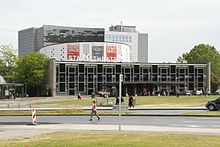
|
| Kiel | Kiel Opera House | The Kiel Opera House is a listed building in the state capital of Schleswig-Holstein and the venue of the Kiel Theater . | Website |

|
| Koblenz | Theater Koblenz | The Koblenz Theater is a multi-branch theater from the 18th century in Koblenz not far from the Electoral Palace with its own ensembles for drama, music theater, puppet shows and ballet. In addition to the theater on Deinhardplatz, the venues are rehearsal stages 2 and 4 and the Ehrenbreitstein fortress for the summer performances. | Website |

|
| Cologne | Chamber Opera Cologne | The Chamber Opera Cologne was founded in 1996 by Esther Hilsberg and Inga Hilsberg as a registered non-profit association (with the name Junge Kammeroper Köln - Musiktheater eV) and has been working as a touring theater in Germany, Austria and Switzerland since then. The ensemble has performed at the Deutsche Oper Berlin and the Festspielhaus Baden-Baden , among others . In August 2007, the Cologne Chamber Opera also opened its own stage in Cologne-Rodenkirchen . She has been at home at the Pulheim rolling mill since 2014 . | Website |
|
| Cologne | Cologne Opera | The Cologne Opera is the opera house of the stages of the city of Cologne . It is located in downtown Cologne on Offenbachplatz . Since 2012, due to the extensive renovation of the Riphahnbau, various interim quarters have been used. So far, these have included the “Opera at the Dom” in the Musical Dome , the Palladium in Cologne-Mülheim , the Trinitatiskirche near Heumarkt and the Staathaus am Rheinpark in Cologne-Deutz. | Website |

|
| Constancy | Chamber opera in the town hall courtyard of Konstanz | The chamber opera in the town hall courtyard in Konstanz is a summer theater that takes place every year in August. | Website |
|
| Krefeld | Theater Krefeld and Mönchengladbach | The theater Krefeld and Mönchengladbach gGmbH is an amalgamation of the former municipal theater of Krefeld and Mönchengladbach. The theater is a three-part house: drama, musical theater and ballet are part of the program. In addition, the Niederrhein Symphony Orchestra is part of the house, and they also take on the tasks of a theater and symphony orchestra . | Website |
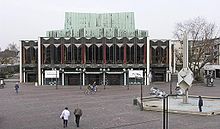
|
| Leipzig | Musical comedy | The Musical Comedy (colloquially MuKo ) is an operetta theater in Leipzig. The venue is located in the Lindenau district in the Dreilinden house , which is often referred to as a musical comedy itself . The "Musical Comedy" is part of the Leipzig Opera (as a multi-branch theater), but not only has its own ensemble with choir, ballet group and orchestra and a repertoire from the opera to the main area of operetta to musicals, as is usual in these In addition, it has its own venue, which the public should also see independently. |

|
|
| Leipzig | Opera house on the Brühl | The Oper am Brühl (also Baroque Opera Leipzig ) was the first opera house in Leipzig. It existed from 1693 to 1720 and was the second bourgeois music theater in Germany after the Hamburg Opera on Gänsemarkt .
The Opernhaus am Brühl was almost at the eastern end of the street and bordered to the north by the city wall. After the construction of the Georgenhaus in 1701, it was its neighboring building. |
|
|
| Leipzig | Leipzig Opera House | The Leipzig Opera House is the venue for the opera and ballet divisions of the Leipzig Opera (which also runs the musical and operetta house Musikalische Komödie in the Dreilinden House in Lindenau). The opera house is located in the center of Leipzig on Augustusplatz , opposite the Gewandhaus .
The Leipzig Opera stands in the tradition of almost 330 years of musical theater maintenance in Leipzig. In 1693, the first Leipzig Opera House was opened on the Brühl as the third bourgeois music theater in Europe after the Teatro San Cassiano in Venice and the Opera on Gänsemarkt in Hamburg. |
Website |

|
| Lübeck | Lübeck Theater | The Theater Lübeck (formerly: Bühnen der Hansestadt Lübeck or in the vernacular for short city theater ) is operated today by the Lübecker Theater gGmbH, a company of the Hanseatic City of Lübeck, and is one of the large theaters in Schleswig-Holstein . | Website |

|
| Luneburg | Lueneburg Theater | The Lüneburg Theater is a three-part theater in Lüneburg with its own ensembles for drama, music theater and ballet. The big house with 542 seats, the studio T.NT with 99 seats and the young theater T.3 serve as venues . | Website |

|
| Magdeburg | Magdeburg Theater | The Magdeburg Theater is a four-branch theater with its own ensembles for music theater, ballet, concerts and drama in Magdeburg. It was created in 2004 from the merger of the state capital's theater and the Freie Kammerspiele . | Website |

|
| Mainz | State Theater Mainz | The Mainz State Theater was called the Mainz City Theater until 1989 and was built by Georg Moller between 1829 and 1833 .
The development of the Mainz State Theater from the former Roman stage theater, the largest north of the Alps, to the renovated Mollerbau extends over more than 2000 years. The Mainz State Theater is a multi-branch house. It combines music theater, drama and dance under one roof. In addition to the three main sections, the Mainz State Theater also shows concerts and plays for children and young people. The three venues - Large House, Small House and the U17 studio stage are located in the center of the city. |
Website |
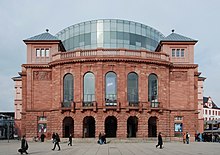
|
| Mannheim | National Theater Mannheim | The Nationaltheater Mannheim (NTM) is a four-part theater in Mannheim with its own ensembles for music theater (opera), drama and dance as well as the Young National Theater (Schnawwl, Young Dance, Young Opera). The cooperative young opera division was founded in 2006 especially for children and young people; In 2012 the Nationaltheater again expanded its offering with the Mannheim Citizens' Stage. With the biennial International Schiller Days and the Mannheim Mozart Summer, as well as around 1,300 performances annually for around 370,000 visitors, the National Theater is ubiquitous as the flagship of the Rhine Neckar metropolitan region and reaches a broad regional and national audience. | Website |

|
| Meiningen | Meininger State Theater | The Meininger State Theater , which operated under the name Das Meininger Theater until April 2017 , is a four-branch theater in the southern Thuringian district town of Meiningen.
The ensemble of the theater offers musical theater (opera, operetta, musical), drama, concert and puppet theater. In addition, the range of ballet and drama performances by the Eisenach State Theater is supplemented. The Meiningen Court Orchestra and the Meiningen Citizens' Stage are also connected to the theater . The traditional stage is supported by the State of Thuringia, the City of Meiningen and the District of Schmalkalden-Meiningen under the umbrella of the Meiningen-Eisenach Cultural Foundation . Until April 2017 the theater was called "Das Meininger Theater - Südthüringisches Staatstheater", since then the name "Staatstheater" has been integrated into the title. |
Website |
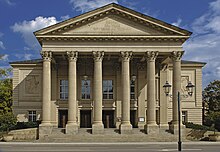
|
| Minden | Minden City Theater | The Minden City Theater is a rank theater in the East Westphalian city of Minden in the Minden-Lübbecke district .
The theater was built in the neo-baroque style between 1906 and 1908 , the design comes from the architects August Kersten (city building officer in Minden) and Paul Kanold (government master builder in Berlin). |
Website |
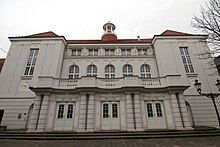
|
| Munich | Bavarian State Opera | The Bavarian State Opera in Munich is one of the most renowned opera houses in the world and can look back on a remarkable history and tradition. World premieres, which were noted throughout Europe, took place around 1700.
The performances take place in the National Theater on Max-Joseph-Platz, in the Prinzregententheater , in the Alten Residenztheater (Cuvilliés-Theater) or in the Reithalle Munich . The opera house is played by the Bavarian State Orchestra . The Munich Opera Festival , one of the world's most important music festivals , has also been held here since 1875 . |
Website |

|
| Munich | So facciamo | Così facciamo is a theater company based in Munich. It has several venues. | Website |
|
| Munich | Cuvilliés Theater | The Cuvilliés-Theater (formerly Residenztheater ) in Munich is known as the most important Rococo theater in Germany. Today it is located in the so-called pharmacy floor of the Munich residence . In addition to the rich rooms in the residence and the Amalienburg in Nymphenburg Park , it is one of the most important buildings by François de Cuvilliés . | Website |
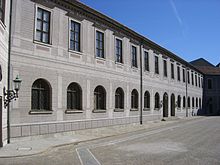
|
| Munich | Chamber Opera Munich | The Munich Chamber Opera is a free Munich opera ensemble with changing venues that was founded in 2004 by Christiane Steffens, Christophe Gördes and Carlos Dominguez-Nieto. | Website |
|
| Munich | National Theater Munich | The National Theater at Max-Joseph-Platz in Munich is the venue for the Bavarian State Opera , the Bavarian State Orchestra and the Bavarian State Ballet . | Website |
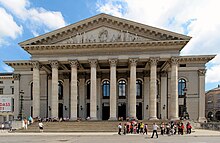
|
| Munich | Prinzregententheater | The Prinzregententheater is a free-standing theater building on Prinzregentenplatz in the Bogenhausen district in the east of Munich and was named after Prince Regent Luitpold . The building, erected from 1900 to 1901, was designed by the architect Max Littmann , who was extremely successful at the time . In his plans, this was based in particular on the Richard Wagner Festival Hall in Bayreuth and took over the amphitheatrical auditorium , for example . The theater, which was initially only reopened as a small solution in 1988, has had its big stage again since 1996. | Website |

|
| Munich | State Theater on Gärtnerplatz | The State Theater on Gärtnerplatz (in common parlance Gärtnerplatztheater ) was opened on November 4, 1865 in Munich's Isarvorstadt on the lively Gärtnerplatz as the "Actien-Volkstheater". Along with the Bavarian State Theater and the Bavarian State Opera, it is now one of three Bavarian state theaters and one of the five theater buildings, as well as the second opera house in the city alongside the Bavarian State Opera. In October 2017 the building was reopened after a general renovation. | Website |

|
| Miesbach | Free State Theater Bavaria | The Free State Theater of Bavaria is a theater company from Miesbach with several venues. | Website |
|
| Muenster | Theater Munster | The Münster Theater ( formerly: Städtische Bühnen Münster) is a five-part theater in Münster and offers performances by its own ensembles in the fields of music theater (opera / operetta / musical), drama, dance theater (ballet) and young theater. The Münster Symphony Orchestra also hosts the symphony concerts in the Münster Theater. The program is complemented by the productions of the Low German stage, numerous guest performances, readings, lectures and exhibitions. | Website |

|
| Naumburg (Saale) | Opera house in front of the Salztor | The opera house in front of the Salztor was a theater building opened in 1701 in Naumburg (Saale). The house was built on his behalf during the reign of Duke Moritz Wilhelm von Sachsen-Zeitz . It burned down in 1716 and was never rebuilt. In the 15 years of its existence, at least 14 different operas and one play were performed in the Naumburg Opera House. |
|
|
| Neuburg on the Danube | Neuburg Chamber Opera | The Neuburger Kammeroper e. V. is an institution that has been playing in the city theater of Neuburg an der Donau since 1969 and brings rarely performed works of music theater from the 18th and 19th centuries to the stage. | Website |

|
| Neustrelitz | Landestheater Neustrelitz | The Landestheater Neustrelitz (formerly Friedrich-Wolf-Theater and Landestheater Mecklenburg ) in Neustrelitz with 400 seats in the large house is the main venue of the Theater und Orchester GmbH Neubrandenburg / Neustrelitz .
Music theater and drama productions as well as philharmonic concerts and ballet evenings are presented here by the in-house ensembles. During the summer months, the neighboring castle garden forms the backdrop for the Neustrelitz Castle Garden Festival with open-air operetta and drama productions. |
Website |

|
| Nordhausen | Nordhausen Theater | The Theater Nordhausen / Loh-Orchester Sondershausen GmbH is a cultural institution in Thuringia that emerged from the merger of the Theater Nordhausen and the Loh-Orchester Sondershausen . | Website |

|
| Nuremberg | Pocket Opera Company | The Pocket Opera Company (POC) was founded in 1974 and is Germany's oldest independent music theater based in Nuremberg. | Website |
|
| Nuremberg | State Theater Nuremberg | The State Theater Nuremberg is one of the largest multi-branch theaters in Germany. As the fourth state theater in the Free State of Bavaria , it emerged on January 1, 2005 from the former Nuremberg Municipal Theaters . The most striking building is the Nuremberg Opera House, which can be seen from afar in the city skyline. Other venues are the Schauspielhaus Nürnberg with the Kammerspiele and the BlueBox as well as the Meistersingerhalle . There are concerts of the State Philharmonic Nuremberg , the orchestra of the State Theater. | Website |
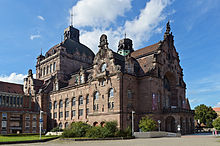
|
| Oldenburg (Oldb) | Oldenburg State Theater | The Oldenburg State Theater is the oldest theater in Oldenburg, Lower Saxony.
The publicly sponsored six-part theater offers performances by its own ensembles in the areas of music theater (opera / operetta / musical), drama, dance theater (ballet), concert, children's and youth theater and Low German drama in cooperation with the August Hinrichs stage , which exclusively Plays in Low German as well as numerous guest performances, readings, lectures and exhibitions. |
Website |

|
| Osnabrück | Osnabrück Theater | The Osnabrück Theater (originally Stadt-Theater ) is a four-branch theater in Osnabrück (Lower Saxony) operated by the Städtische Bühnen Osnabrück gGmbH .
The main venue is the Art Nouveau theater with 642 seats at the cathedral courtyard. There is also a studio theater in Weststadt (Osnabrück) , the emma-theater , with 96 seats. In addition to music , drama and dance, the municipal theaters offer theater for children and young people with Oskar, the young theater of the city and region of Osnabrück . |
Website |

|
| Passau | Lower Bavaria State Theater | The Landestheater Niederbayern , founded in 1952, is a two-branch theater (music theater and drama) in the Lower Bavaria region. Currently the Stadttheater Landshut and Passau, the Theater am Hagen in Straubing as well as other detour venues in the district of Lower Bavaria are used. The orchestra of the Landestheater is the Niederbayerische Philharmonie. | Website |

|
| Pforzheim | Pforzheim City Theater | The Stadttheater Pforzheim is the theater of the city of Pforzheim in Baden-Württemberg . The theater is located on Waisenhausplatz directly on the Enz . The theater, which was built in 1990 according to plans by the architect Bodo Fleischer, has two venues available: The large house with 511 seats and the podium , which can accommodate up to 193 spectators thanks to variable seating and a gallery. The Pforzheim City Theater is a three-division house. In addition to theater performances, operas, operettas, ballet, concerts and musicals take place here. In addition, the Badische Philharmonie Pforzheim (formerly the Pforzheim Municipal Orchestra) is housed under the roof of the theater. | Website |
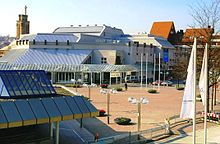
|
| Plauen | Plauen-Zwickau Theater | The Plauen-Zwickau theater is a theater operated jointly by the cities of Plauen and Zwickau in the German state of Saxony . It unites the musical theater, drama, ballet and orchestra divisions. | Website |

|
| Potsdam | Hans Otto Theater | The Hans Otto Theater ( HOT for short ), named after the actor Hans Otto , is the Potsdam city theater. It is managed in the legal form of a GmbH . Since September 2006 his ensemble has been playing in the Neues Theater , which is synonymous with the Hans Otto Theater as the seat of the house and is located on the Schiffbauergasse on the banks of the Tiefen See . Another venue of the theater is the neighboring historic riding hall. It also appears regularly in the palace theater in the New Palais . | Website |

|
| Potsdam | Potsdam Winter Opera | The Potsdam Winter Opera has been jointly organized by the Potsdam Chamber Academy and the Hans Otto Theater in Potsdam since 2005. Since 2013 they have been using the Friedenskirche as a performance venue. | Website |
|
| Putbus | Theater Western Pomerania | The Theater Vorpommern is a theater operated in the legal form of a GmbH. The partners are the cities of Stralsund, Greifswald and Putbus. The Vorpommern theater offers musical theater, drama, ballet and concerts. In addition to the performances in the main houses, there are also open-air performances every year. | Website |
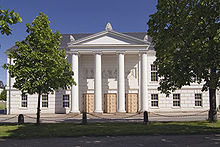
|
| Radebeul | State theaters of Saxony | The state theaters of Saxony are Germany's second largest travel theater with headquarters in Radebeul near Dresden. The parent company is located in the premises of the former Goldene Weintraube inn , at Meißner Straße 152. | Website |
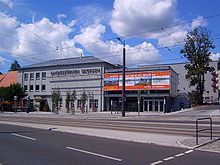
|
| regensburg | Regensburg Theater | The Regensburg Theater (city theater) at Bismarckplatz 7 is the city theater in Regensburg.
The Regensburg Theater is a 5-branch house. The theater's venues are the theater stage on Bismarckplatz including rehearsal stage, Neuhaussaal and Neuhaussaal foyer, the velodrome built by Simon Oberdorfer on Arnulfsplatz , the theater on Haidplatz and the open-air stage in Thon-Dittmer-Palais . Since February 2015, the Junge Theater in the former presidential palace on the upper Bismarckplatz has also had its own venue. |
Website |
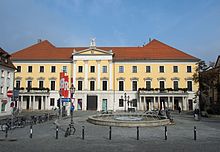
|
| Rostock | Volkstheater Rostock | The Volkstheater Rostock is the municipal theater of the Hanseatic City of Rostock. It has two venues, the Großes Haus and the Kleine Komödie in Warnemünde, and includes the areas of drama, music theater / opera, ballet and dance, the philharmonic orchestra and, from the 2014/15 season, also the puppet theater and the community stage. For younger target groups, there is a children's, a youth and a student theater club, as well as children's and youth theater performances. | Website |

|
| Saarbrücken | Saarland State Theater | The Saarland State Theater is a multi-discipline theater in Saarland with around 30 premieres and new productions, over 700 events and more than 200,000 visitors every year. A high- profile program with opera, drama, ballet, dance and concerts is shown in the Staatstheater, Alte Feuerwache, Congresshalle and sparte4 venues . | Website |

|
| Schwerin | Mecklenburg State Theater Schwerin | The Mecklenburg State Theater Schwerin is a state five-part theater in the state capital Schwerin. In addition to numerous new productions and a large repertoire, one of the annual highlights of the game operations are the Schwerin Castle Festival against the backdrop of the residential ensemble with Schwerin Castle , State Theater and State Museum . From 1919 to 1933, the State Theater also served as the first democratic parliament and state parliament of the Free State of Mecklenburg-Schwerin . | Website |

|
| Schwetzingen | Schwetzingen Palace Theater | The Early Classicist Schwetzingen Palace Theater is part of the Schwetzingen Palace . It is the oldest preserved ranked theater in the world and the oldest preserved theater in Baden-Württemberg . Other names are: court theater, court opera , or Comoedienhaus .
In addition to Baroque and Classical operas today during the be Schwetzingen Festival of SWR and contemporary operas in the theater. Since 1952, more than 35 opera compositions have been commissioned and premiered in the palace theater. |

|
|
| Stralsund | Theater Western Pomerania | The Theater Vorpommern is a theater operated in the legal form of a GmbH. The partners are the cities of Stralsund, Greifswald and Putbus. The Vorpommern theater offers musical theater, drama, ballet and concerts. In addition to the performances in the main houses, there are also open-air performances every year. | Website |

|
| Stuttgart | State Theater Stuttgart | The Staatstheater Stuttgart are a three-branch theater with the branches Opera Stuttgart, Stuttgart Ballet and Drama Stuttgart in the Baden-Württemberg state capital Stuttgart. The main venues are located in the palace gardens and were built by Max Littmann in 1909–1912 as a double theater with the opera house (formerly known as the Great House ) and a theater. After the destruction of the small house (for the theater) in the Second World War, it was replaced by a new building by Hans Volkart from 1959 to 1962. The large house was modernized in 1956 and returned to its original shape in 1983/84. In 2001 the name was changed: The big house is now called the opera house and the small house is called the theater, not to be confused with the old theater . | Website |
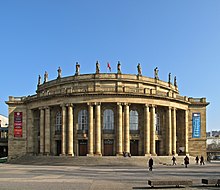
|
| trier | Theater Trier | The Trier Theater is a three-part house with 622 seats, which has its own theater ensemble as well as a ballet and music theater ensemble. The theater has existed since 1802. In June 2013, the theater was opened by the Deutsches Kulturrat e. V. put on the culture red list and classified as threatened with closure (category 1). | Website |

|
| Ulm | Ulm Theater | The Ulm Theater is the municipal theater in Ulm. It is the oldest municipal theater in Germany (founded in 1641) and is now operated as a three-part house with its own ensembles for opera / operetta, drama and ballet. Until 2006 the house was called Ulmer Theater .
Today's theater building at Herbert-von-Karajan-Platz 1 was built from 1966 to 1969 according to plans by the architect Fritz Schäfer and opened on October 3, 1969. |
Website |

|
| Weimar | German National Theater and State Orchestra Weimar | The German National Theater and the Staatskapelle Weimar ( DNT for short ) is the most important stage operator in Weimar. The institution combines the music theater and the speaking stage of the German National Theater as well as the Staatskapelle Weimar orchestra . A total of six stages will be used throughout the city. All branches of the theater and orchestra also give irregular guest performances and also have appearances in the electronic media. The Free State of Thuringia and the City of Weimar are shareholders of the German National Theater and Staatskapelle Weimar GmbH - State Theater Thuringia . | Website |
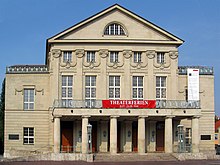
|
| Wiesbaden | Hessian State Theater | The Hessian State Theater Wiesbaden in the Hessian state capital Wiesbaden is a five-branch theater. The theater has four stages, Large House (1,041 seats), Small House (328 seats), Studio (89 seats) and the external Wartburg theater (154 seats, since 2003) on Schwalbacher Straße. | Website |
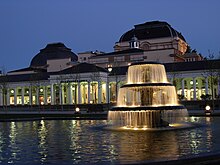
|
| Wittenberg | Elbe-Elster-Theater | The Elbe-Elster-Theater , from 1993 Central German State Theater , was a multi-branch theater in the Lutherstadt Wittenberg in Saxony-Anhalt . With 360 employees, the theater, founded in 1949 and finally closed again in 2002, was the largest guest theater in the GDR at the end of the 1980s . |
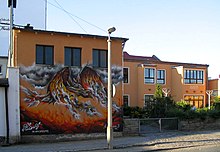
|
|
| Wuppertal | Wuppertal Opera House | The Wuppertal Opera House is a theater building originally built in 1905 as the Barmen City Theater, which today is the main venue for the Wuppertal Theaters and the Pina Bausch Dance Theater . As a building that was renovated in the style of the 1950s after the Second World War and originally committed to Art Nouveau , the building complex, which was expanded with additions in the 1970s and completely renovated from 2006 to 2009, is a listed building. | Website |

|
| Wurzburg | Mainfranken Theater Würzburg | The Mainfranken Theater Würzburg is a three-part house and the largest theater in Würzburg and Lower Franconia .
In addition to the large house with 739 seats, the theater also houses a small theater, the Kammerspiele, which can seat 92 spectators. |
Website |

|
| Zwickau | Plauen-Zwickau Theater | The Plauen-Zwickau theater is a theater operated jointly by the cities of Plauen and Zwickau in the German state of Saxony . It unites the musical theater, drama, ballet and orchestra divisions. | Website |
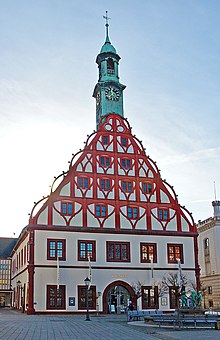
|
Estonia
| place | Opera house | Details | Official website | image |
|---|---|---|---|---|
| Tallinn | Estonia National Opera | The Estonia National Opera ( Estonian : Rahvusooper Estonia ) is one of the most important cultural institutions in Estonia . Its headquarters, the Estonia Opera and Concert Hall, is located in the center of the capital Tallinn.
The Finnish architects Armas Lindgren and Wivi Lönn planned the representative building in Art Nouveau style, which is still the headquarters of the National Opera today. The inauguration took place on August 24, 1913. |
Website |

|
| Tartu | Vanemuine | The Vanemuine is a theater in Tartu, Estonia. It is the oldest Estonian language theater and dates back to 1870.
The theater was originally located in a building on Jaama Street , but it was destroyed by fire in 1903. A new building designed by Armas Lindgren was opened in 1906 on Aia Street (now Vanemuise Street ), from which the professional theater business began. |
Website |

|
Finland
| place | Opera house | Details | Official website | image |
|---|---|---|---|---|
| Helsinki | Finnish National Opera | The Finnish National Opera ( Finnish : Suomen Kansallisooppera ) is the only professional opera company in Finland . The ensemble was founded in 1911. The building in which it is housed is located in the capital Helsinki on the shores of Töölönlahti Bay. It was completed in 1993 and has two auditoriums: the main theater has 1350 seats, the smaller one can accommodate 300 to 500 people depending on the seating. | Website |

|
| Jyväskylä | Jyväskylän Ooppera | The Jyväskylän Ooppera is an opera house in Jyväskylä, Finland. | Website / |
|
| Kokkola | Kokkola Ooppera | The Kokkola Ooppera is an opera house in Kokkola, Finland. | Website |
|
| Tampere | Tampereen Ooppera | The Tampereen Ooppera is an opera house in Tampere, Finland and was founded in 1946. | Website |
|
| Vaasa | Vaasan Ooppera | The Vaasan Ooppera is an opera house in Vaasa. It is the second oldest regional opera in Finland and was founded in 1956. | Website |
|
France
| place | Opera house | Details | Official website | image |
|---|---|---|---|---|
| Aix-en-Provence | Grand Théâtre de Provence | The Grand Théâtre de Provence is a theater in Aix-en-Provence in the new Sextius Mirabeau district . An Aix symbol was used to design the rooms: on the outside, stones of different colors recall their origins in the Montagne Sainte-Victoire . | Website |

|
| Angers | Angers-Nantes Opéra | The Angers-Nantes Opéra was founded in January 2003 through the merger of the opera houses in Angers and Nantes in order to give the opera new impetus throughout western France.
The company uses a variety of function rooms in the two cities and across the region, but the main venues are the Grand Théâtre d'Angers with 728 seats in Angers and the Théâtre Graslin with 784 seats in Nantes. |
Website |
|
| Angers | Grand Théâtre d'Angers | The Grand Théâtre d'Angers in Maine-et-Loire is a 19th-century theater located in the city center on Place du Ralliement. The theater house has 700 seats and is home to music, theater and opera. | Website |
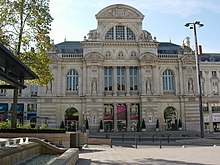
|
| Angers | Théâtre Graslin | The Théâtre Graslin is an opera house in Nantes. It was built towards the end of the 18th century by the architect Mathurin Crucy in the classicism style and named after Jean-Louis Graslin, the landowner. The opening took place on March 23, 1788. The theater burned down in 1796, but was rebuilt during the Napoleonic era. A comprehensive restoration took place in 2003. The house's capacity today is 784 seats. The opera is currently operated in cooperation with the "Grand Théâtre d'Angers". The famous Brasserie La Cigale is located opposite the Theaterplatz . | Website |

|
| Antibes | Anthea | The Anthea is a theater house in Antibes. | Website |
|
| Avignon | Opéra d'Avignon | The Opéra d'Avignon is an opera house in Avignon that has been in operation for nearly two centuries. The first opera house was built between 1824-1825 and opened on October 30, 1825. The original opera house was destroyed in a fire on January 26, 1846. The current opera house was built in the years 1846-1847 and designed by the architects Léon Feuchère and Théodore Charpentier. | Website |
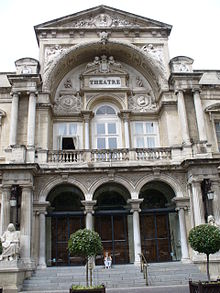
|
| Besançon | Théâtre de Besançon | The T héâtre de Besançon or T héâtre Ledoux in the old town of Besançon is used as a theater, an opera house and a concert venue. | Website |

|
| Bordeaux | Grand Théâtre de Bordeaux | The Grand Théâtre de Bordeaux or Grand Théâtre (Bordeaux) is a historic building in the south-west French city of Bordeaux.
The Grand Théâtre is the most important theater in the city and metropolitan region in southwest France and is the venue of the Opéra National de Bordeaux for opera / operetta, spoken theater, concerts, dance theater and events. The Grand Théâtre de Bordeaux with around 1,100 seats is located in the center of the city of Bordeaux about 300 meters west of the banks of the Garonne . |
Website |

|
| Caen | Théâtre de Caen | The Théâtre de Caen is a theater in Caen. | Website |
|
| Clermont-Ferrand | Opéra municipal de Clermont-Ferrand | The Opéra municipal de Clermont-Ferrand is an opera house in Clermont-Ferrand. | Website |
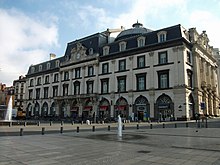
|
| Clermont-Ferrand | Center Lyrique Clermont-Auvergne | The Center Lyrique Clermont-Auvergne is a theater in Clermont-Ferrand. | Website |
|
| Compiègne | Théâtre Imperial de Compiègne | The Théâtre Impérial de Compiègne is a theater in Compiègne. | Website |
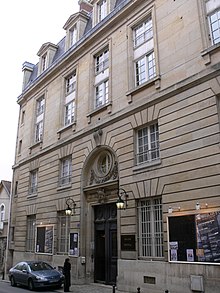
|
| Compiègne | Théâtre Français de la Musique | The Théâtre Français de la Musique is a theater in Compiègne. | Website |
|
| Colomiers | Opéra Éclaté | The Opéra Éclaté is a small opera company in Colomiers. It was founded in 1985 by Oliver Desbordes. From 1998–1999 the Opéra Éclaté was recognized by the Ministry of Culture as the “Compagnie nationale de Théâtre Lyrique et Musical”.
The Opéra Éclaté plays in a variety of venues and tries to reach those who don't normally go to the opera. |
Website |
|
| Dijon | Auditorium de Dijon | The Auditorium de Dijon is a theater theater with 1,611 seats that has existed since 1998. It is one of the venues of the Opéra de Dijon . | Website |

|
| Dijon | Grand Théâtre de Dijon | The Grand Théâtre de Dijon , one of the most beautiful in France, is a theater building in Dijon. It is one of two venues for the Opéra de Dijon . Initially, the Grand Théâtre had 1,000 seats. The renovation and restoration of the building reduced the number to 692 seats in 1969 in order to improve visual comfort. The interior of the building was restored again in 2005 and, with its exceptional acoustics, is the most important theater building in Burgundy. | Website |
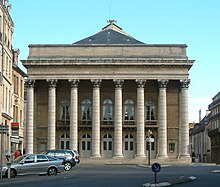
|
| Dijon | Opéra de Dijon | The Opéra de Dijon is an opera company based in Dijon. Its main venues are the Grand Théâtre de Dijon and the Auditorium de Dijon. In addition to operas, the organization also organizes ballets and classical music concerts. | Website |

|
| Lille | Opera de Lille | The Opéra de Lille is a traditional opera house in the French city of Lille. The building is since 31 December 1999 as inscribed monument historique historical monument.
The opera house was built between 1907 and 1914 by the architect Louis Marie Cordonnier as a magnificent building in the style of the historicism of the Belle Époque . The opening was prevented by the outbreak of the First World War in 1914. On February 2, 1919, the first French performance of George Bizet's incidental music L'Arlésienne took place. However, the theater had to be closed after a few performances for reasons of structural safety. It was not until 1923 that it was officially opened as the Grand Théâtre de Lille . |
Website |

|
| Limoges | Opéra de Limoges | The Opéra de Limoges , original name Grand théâtre de Limoges or Opéra-théâtre de Limoges is a theater in the city center of Limoges on Place Stalingrad. It is affiliated with the Limoges Regional Conservatory. Lyrical performances (operas, concerts, chamber music concerts, ballets) and other non-lyrical events (plays, contemporary music concerts, French chansons, comedy shows and festival events) take place in the opera house. The building erected on the site of the Cirque-Théâtre , which opened in 1919, was designed by Pierre Sonrel. | Website |

|
| Lyon | Opéra National de Lyon | The Opéra National de Lyon is a non-profit association that aims to promote music and dance in Lyon and the Rhône-Alpes region . The Opéra National de Lyon was founded in 1983 and has enjoyed the status of Opéra national since 1996 . The opera includes a choir, an orchestra and a ballet.
The Opera House of the Opéra National de Lyon is located on the Place de la Comédie in the 1st arrondissement of the city, directly opposite the City Hall. The opera house was redesigned between 1985 and 1993 by the renowned French architect Jean Nouvel and has been called Opéra Nouvel ever since . |
Website |
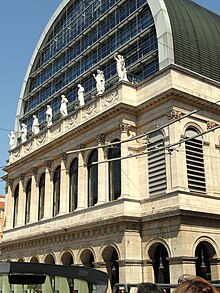
|
| Marseille | Opera de Marseille | The Opéra de Marseille , now also known as the Opéra Municipal , is an opera house based in Marseille. It was designed by the three architects Ebrard, Castel and Raymond, opened on December 4, 1924 and offers 1,800 seats. | Website |
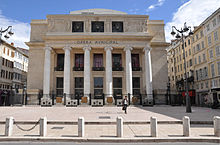
|
| Massy | Opéra de Massy | The Opéra de Massy is an opera house in the French commune of Massy, in the Essonne department and in the Île-de-France region . The Opéra de Massy is a member of the ROF (Réunion des opéras de France), the RESEO (Réseau européen pour la sensitization à l'opéra et à la danse) and the Opera Europa. | Website |

|
| Mérignac | Le Pin Galant | Le Pin Galant is a theater in Mérignac, France. | Website |
|
| Metz | Opéra-Théâtre de Metz Métropole | The Opéra-Théâtre de Metz Métropole is an opera house and theater with 750 seats on the island of Petit-Saulcy in Metz, capital of the Moselle department . It is the oldest opera house in France and one of the oldest in Europe. | Website |
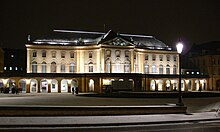
|
| Montpellier | Opéra National de Montpellier | The Opéra National de Montpellier Languedoc-Roussillon (usually called Opéra Comédie ) is an opera house in Montpellier, France.
The opera company was founded in 1755, but was only granted national opera status in 2002 by the French Ministry of Culture . The institution's headquarters are at the Opéra Comédie on Place de la Comédie in Montpellier. The building opened in 1888. In addition to the large house with 1200 seats, it houses the Salle Molière concert hall with 350 seats. Since 1990 performances have also been presented at the Berlioz Opéra in the Le Corum Culture and Congress Center , which has 2000 seats. The Orchester National de Montpellier Languedoc-Roussillon acts as the opera orchestra . |
Website |
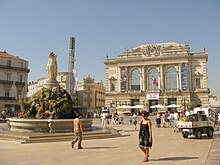
|
| Nancy | Opéra national de Lorraine | The Opéra national de Lorraine is located in Nancy and is the most important opera house in north-eastern France. The house has had its current name since January 2006, previously it was called Opéra de Nancy et de Lorraine . | Website |

|
| Nantes | Théâtre Graslin | The Théâtre Graslin is an opera house in Nantes. It was built towards the end of the 18th century by the architect Mathurin Crucy in the classicism style and named after Jean-Louis Graslin, the landowner. The opening took place on March 23, 1788. The theater burned down in 1796, but was rebuilt during the Napoleonic era. A comprehensive restoration took place in 2003. The house's capacity today is 784 seats. The opera is currently operated in cooperation with the Grand Théâtre d'Angers . | Website |

|
| Nice | Nice Opera | The Opéra de Nice is an opera house in the heart of the old town of Nice with a total of 1195 seats. In addition to opera, the ballet and concert sectors are also served there. The house is the seat of the Orchester Philharmonique de Nice and has its own choir and ballet. | Website |

|
| Paris | Cité de la musique | The Cité de la musique is a collection of institutions dedicated to music and is part of the Parc de la Villette - located in the La Villette district , in the 19th arrondissement of Paris . Built by architect Christian de Portzamparc and inaugurated in 1995 .
The Cité de la Musique includes:
The Cité de la musique also operates the traditional Salle Pleyel in the 8th arrondissement of Paris. |
Website |

|
| Paris | Opera Bastille | The Opéra Bastille (Bastille Opera House) is one of the two Parisian opera houses that are subordinate to the state institution of the Opéra National de Paris . This opera by Carlos Ott , which opened in 1989, was intended to relieve the opera house, the Opéra Garnier , also known as the “Palais Garnier” , which was the central opera house up to that point in time and which is now mainly used for ballet performances by the Ballet de l'Opéra de Paris , but also continues to be used for classical operas performs. | Website |
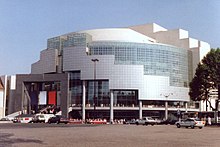
|
| Paris | Opera Garnier | The Opéra Garnier , also known as the Palais Garnier , is one of the two Parisian opera houses that are subordinate to the state institution Opéra National de Paris . The Opéra Garnier opened in 1875 and is located on the right bank of the Seine in the 9th arrondissement . It owes its name to its builder Charles Garnier . Since the opening of the Opéra Bastille in 1989, the Opéra Garnier has mainly been used for ballet performances by the in-house ballet company Ballet de l'Opéra de Paris , but continues to perform classical operas as well. | Website |

|
| Paris | Opéra National de Paris | The Opéra National de Paris and its predecessor institutes play an important role in operatic history with their style-defining premieres. The institution of the Opéra has always been viewed as independent of its changing venues. Before the French Revolution (since 1669) it was called the Académie Royale de musique and was incorporated into the Académie Royale . | Website |
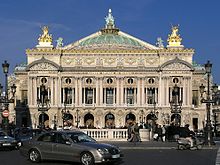
|
| Paris | Opéra-Comique | The Opéra-Comique is a theater in Paris. It stands on Place Boieldieu , near the Boulevard des Italiens in the 2nd arrondissement, and is also known as Salle Favart . | Website |

|
| Paris | Théâtre de l'Athénée-Louis-Jouvet | The Théâtre de l'Athénée-Louis-Jouvet is a theater located at 7 rue Boudreau, in the 9th arrondissement of Paris. It was renovated in 1996 and placed under monument protection. | Website |

|
| Paris | Théâtre des Bouffes du Nord | The Théâtre des Bouffes du Nord is a theater in Paris that is located next to the Gare du Nord . It was founded in 1876 by the German Emperor Wilhelm II . In the first ten years it had at least fifteen artistic directors, the most notable of which was Olga Léaud, who took over the theater after a production was canceled. The theater was revived as a ballet theater for a short time in 1885, but this orientation was given up again in 1886. Then it was directed by two actors, Emmanuel Clot and G. Dublay. In 1904 it was completely restored, repainted and electrified. It was renamed Théâtre Molière and Arthur Bernède and Gaston Leroux began writing pieces for it. Like many other Parisian theaters, it closed in August 1914.
By 1974 the theater was used by many different companies, but none was able to renovate it and bring it up to date with more recent safety standards. The British director Peter Brook took over the management in 1974 and settled his theater group there. After 34 years, Brook gave his theater to younger hands. |
Website |

|
| Paris | Théâtre des Champs-Elysées | The Théâtre des Champs-Élysées is a theater in Paris. It is not on the Champs-Élysées , but on 15 avenue Montaigne , and caused a sensation at the beginning of the 20th century with its architecture and, above all, its scandal-ridden performances. Today it is still a venue for musical theater and one of the most famous concert halls in the city. Auguste Perret built the theater originally designed by Henry van de Velde from 1911 to 1913 . Inside there are three halls one above the other: the Grand Théâtre with 2,000 seats, above La Comédie with 655 seats and Le Studio (257 seats), which opened in 1923.
The Théâtre des Champs-Élysées is now dedicated to classical music and is home to the Orchester National de France and the Orchester Lamoureux as well as the base of the Vienna Philharmonic in France. |
Website |

|
| Paris | Théâtre du Châtelet | The Théâtre du Châtelet is a Parisian theater. It is located in the 1st arrondissement , 2 rue Edouard Colonne, and opened in 1862. Today, the Théâtre du Châtelet mainly performs operas and classical concerts. | Website |
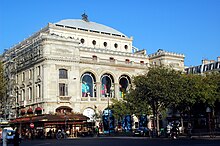
|
| Reims | Opéra de Reims | The Opéra de Reims is an opera house in Reims. It was built by the architect Alphonse Gosset in collaboration with Narcisse Brunette and Ernest Leclère and inaugurated in 1873. | Website |

|
| Rennes | Opéra de Rennes | The Opéra de Rennes is an opera house in Rennes. It was designed by Charles Millardet and built by Pierre Louise. | Website |

|
| Rouen | Opéra de Rouen Normandy | The Opéra de Rouen Normandie or Opéra de Rouen Normandie - Théâtre des arts is a French opera house in Rouen, Normandy. It is the home of the Rouen Philharmonic Orchestra.
The opera house has several concert halls including the headquarters known as the Théâtre des arts and the Chapelle Corneille . |
Website |
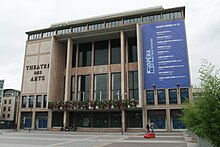
|
| Saint-Etienne | Opéra de Saint-Etienne | The Opéra de Saint-Etienne is located in the heart of the Jardin des Plantes in Saint-Etienne. It is a modern theater with the main areas: opera, classical music and dance. The opera house is a member of the ROF (Réunion des opéras de France). | Website |

|
| Strasbourg | Opera national du Rhin | The Opéra national du Rhin ( "National Rhein - opera is"), the opera ensemble (soloists and chorus) the cities of Strasbourg, Mulhouse and Colmar in Alsace . He is also responsible for the ballet company Ballet du Rhin, the young talent forge Jeunes voix du Rhin and the school for mask education École des arts de la transformation. Permanent orchestras are the Strasbourg Philharmonic and the Mülhausen Symphony Orchestra. | Website |

|
| Toulon | Opera de Toulon | The Opéra de Toulon is an opera house in Toulon. It was inaugurated on October 1, 1862 and is the second largest opera house in France after the Palais Garnier in Paris.
It is currently the home of the Toulon Provence Méditerranée Opera. The opera company plays around eight operas per season in the opera houses of Toulon, Avignon, Nice and Marseille. The house offers space for 1,797 people on five levels. |
Website |

|
| Toulouse | Théâtre du Capitole Toulouse | The Theater du Capitole Toulouse (German: Theater des Kapitols) is an opera house in the Capitol of the French city of Toulouse in the Haute-Garonne department .
The theater was built in the early 19th century and opened on October 1, 1818. It has 1150 seats. The Theater du Capitole employs more than 260 people in the choir, the Orchester Nationale and the ballet. In addition to operas, concerts are also performed. |
Website |

|
| Tours | Opera de Tours | The Grand Théâtre de Tours is a listed municipal building on Rue de la Scellerie in Tours. With more than nine hundred seats, it is the seat of the Opera of Tours , which has a permanent choir. It is also home to the Center-Val de Loire-Tours region symphony orchestra . | Website |

|
| Versailles | Royal Opera | The Royal Opera ( French : Opéra royal du château de Versailles ) of the Palace of Versailles in France was under Ange-Jacques Gabriel in 1770 in the reign of Louis XV. accomplished. The construction of today's opera house was one of the last major construction projects of the Ancien Régimes in Versailles. It has remained largely unchanged to the present day and is still regularly used today. | Website |
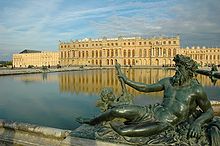
|
| Vichy | Opéra de Vichy | The Opéra de Vichy is an opera house in Vichy in the Allier department. It can accommodate more than 1,450 people. | Website |

|
Georgia
| place | Opera house | Details | Official website | image |
|---|---|---|---|---|
| Tbilisi | State Sakaria Paliashvili Theater for Opera and Ballet | The State Sakaria Paliashvili Opera and Ballet Theater ( Georgian ზაქარია ფალიაშვილის სახელობის თბილისის ოპერისა და ბალეტის პროფესიული სახელმწიფო თეატრი) is an opera house founded in 1851 in Rustavelis Gamsiri in Tbilisi. Since 1896 the theater has resided in a building with oriental architecture , which was built by Viktor Schröter . The opera house is one of the cultural centers of the city and was once the place of activity of the Georgian national composer Sakaria Paliashvili , after whom the house has been named since 1937. The theater is also the seat of the country's state ballet. National celebrations and the inauguration of the Georgian President are also celebrated here. | Website |

|
Greece
| place | Opera house | Details | Official website | image |
|---|---|---|---|---|
| Athens | Greek National Opera | The Greek National Opera (Greek: Εθνική Λυρική Σκηνή) is the country's state opera company and is located in the cultural center Stavros Niarchos Foundation in the southern suburb of Athens, Palaio Faliro. It is a public corporation under the supervision of the Greek Ministry of Culture and under the direction of a board of trustees and its artistic director.
The organization is responsible for a variety of activities including opera performances, ballet and musical theater, symphony concerts, special screenings of opera and ballet performances for children, and an opera and ballet studio. |
Website |
|
| Athens | Megaro Mousikis | The Megaro Mousikis ( Greek Mέγαρο Mουσικής "Music Palace", after the ancient term mostly Megaron ) is the concert building of the non-profit "Society of Friends of Music" (Eταιρία των Φίλων της Mουσικής) on the Leoforos Vasilissis Sofas in Athens. | Website |

|
| Ermoupolis | Apollon Theater (Syros) | The Apollon Theater , also known as the Municipal Theater Apollo , is a theater in Ermoupolis, Syros . The theater was built between 1862 and 1864 according to the designs of the Italian architect Pietro Sampò and opened on April 20, 1864. | Website |

|
| Thessaloniki | National Theater of Northern Greece | The National Theater of Northern Greece (NTNG) in Thessaloniki was founded in 1961 by Sokratis Karantinos, its first director. A drama school and a dance theater are part of the national theater. With four indoor and two open-air theaters, the NTNG is one of the largest theater organizations in Greece and Europe. | Website |

|
| Thessaloniki | Thessaloniki Concert Hall | The Thessaloniki Concert Hall (Greek: Μέγαρο Μουσικής Θεσσαλονίκης) is a center for performing arts in Thessaloniki. It was opened in 2000 and consists of two main buildings: M1 with an auditorium with 1,400 seats and M2 in the contemporary style of the Japanese architect Arata Isozaki with a number of smaller performance rooms. | Website |

|
| Corfu | Corfu City Theater | The Corfu City Theater (Greek: Δημοτικό Θέατρο Κέρκυρας) was the main theater and opera house in Corfu from 1902 to 1943. The theater was the successor to the Nobile Teatro di San Giacomo di Corfù , which became the Corfu Town Hall. It was destroyed during an air raid by the Luftwaffe in 1943. In its 41-year history it has been one of the leading theaters and opera houses in Europe with contributions to the art and history of the Balkans. | Website |
|
Ireland
| place | Opera house | Details | Official website | image | |
|---|---|---|---|---|---|
| Cork | Cork Opera House | The Cork Opera House is a theater and opera house in Cork. It was originally built in 1855 and is based on a template the architect used for the Irish Industrial Exhibition building. Since then, it survived the burning of much of Cork by British forces in 1920 and burned down in 1955. The opera house was completely rebuilt and reopened in 1963. | Website |

|
|
| Dublin | Drawing Room Opera Company | The Drawing Room Opera Company is a Dublin-based opera company. | Website |
|
|
| Dublin | Gaiety Theater | The Gaiety Theater is a theater in the Irish capital, Dublin. It was opened on South King Street in November 1871 after seven months of construction according to plans by architect Charles J. Phipps . The Victorian theater has a parquet floor and two tiers in the auditorium. | Website |
|
|
| Dublin | Opera Ireland | Opera Ireland was Ireland's first national opera company. Although their roots under the name Dublin Grand Opera Society dating back to 1941, the company was founded in 1985 in its final form as the Dublin Grand Opera Society Ltd. founded. From 1996 until its end in 2010, it was known as Opera Ireland . During its existence it played at Dublin's Gaiety Theater . |
|
||
| Dublin | Opera Theater Company | The Opera Theater Company is a Dublin-based opera company. | Website |
|
|
| Dublin | Wide Open Opera | The Wide Open Opera is a Dublin-based opera company. | Website |
|
|
| Wexford | Theater Royal (Wexford) | The Theater Royal was an opera house and venue in Wexford that opened in 1832 and closed in 2005. It was home to the annual Wexford Festival Opera and has been replaced by the National Opera House . |

|
||
| Wexford | National Opera House | The National Opera House , formerly Wexford Opera House , is a theater house in Wexford. It was officially opened on September 5, 2008.
The theater house was built on the site of the former Theater Royal , which was previously demolished. It consists of the O'Reilly Theater with 771 seats and the smaller Jerome Hynes Theater with 176 seats. |
Website |
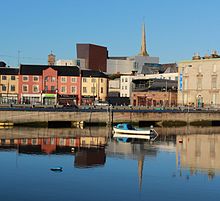
|
Iceland
| place | Opera house | Details | Official website | image |
|---|---|---|---|---|
| Reykjavík | Íslenska óperan | The Íslenska óperan is an opera company from Reykjavík. | Website |
|
| Reykjavík | Harpa concert hall | Harpa - the concert and conference house in Reykjavík (Icelandic: Harpa - Tónlistar- og ráðstefnuhúsið í Reykjavík) is the opera and concert hall in the capital Reykjavík, which opened in 2011. The building houses both the Icelandic Symphony Orchestra and the Icelandic Opera and, with the facade designed by the artist Olafur Eliasson , is an architectural attraction and a new symbol of the capital. | Website |

|
Italy
| place | Opera house | Details | Official website | image |
|---|---|---|---|---|
| Alessandria | Teatro Comunale (Alessandria) | The Teatro Comunale is a theater in Alessandria. | Website |
|
| Ancona | Teatro delle Muse | The Teatro delle Muse is a theater in Ancona. It is in the city center, near the port. Opera and ballet performances, symphony concerts and a jazz festival are organized. The neoclassical building was inaugurated in 1827 and is the work of the architect Pietro Ghinelli. | Website |
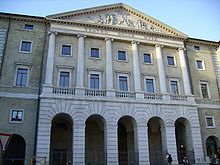
|
| Asti | Teatro Vittorio Alfieri (Asti) | The Teatro Alfieri is a theater in Asti. Founded in 1860 by private shareholders, it has been owned by the city since 1940 and is used for theater, music and poetry performances. The Teatro Alfieri is located in the historical part of the city, in the immediate vicinity of the town hall. Extensive renovations have been carried out since 1979 and were completed in 2002. |
|
|
| Bari | Petruzzelli Theater | The Teatro Petruzzelli is an Italian opera house in Bari with a capacity of 1482 seats that was built in 1903. | Website |

|
| Bergamo | Bergamo Donizetti Theater | The Teatro Donizetti is an opera house in Bergamo. The theater was built in the 1780s to a design by the architect Giovanni Francesco Lucchini and was originally called the Teatro Nuovo or Teatro di Fiera .
The official opening of the house under the name Teatro Riccardi took place on August 24, 1791. In 1797 the original theater was destroyed by fire, possibly arson. Lucchini was commissioned again to create a new opera house. The new house opened on June 30, 1800. In 1897 the name of the theater was changed to Teatro Gaetano Donizetti (Teatro Donizetti for short) on the occasion of the composer's 100th birthday. Donizetti was born in Bergamo's Borgo Canale district and his first opera, Il Pigmalione (composed in 1816), premiered in the theater on October 13, 1960. |
Website |

|
| Bologna | Teatro Comunale di Bologna | The Teatro Comunale of Bologna is the opera house of the city of Bologna and at the same time one of the most important opera houses in Italy.
First performances of operas took place in Bologna in the seventeenth century. The current building was built by Antonio Galli da Bibiena and opened on May 14, 1763 with Il trionfo di Clelia , a work composed by Christoph Willibald Gluck for the occasion. From the nineteenth century onwards there were numerous premieres and premieres, including works by Rossini , Bellini , Giuseppe Verdi and the Italian premieres of Lohengrin and Rienzi by Richard Wagner . The horseshoe-shaped hall can seat 1084 spectators. |
Website |

|
| Bolzano | Bolzano City Theater | The City Theater Bozen (Italian Teatro comunale di Bolzano ) is a theater building in the South Tyrolean capital Bozen. In particular, it serves as a venue for productions of spoken and music theater. It is played primarily by the United Theaters of Bozen , the Teatro Stabile di Bolzano and the Haydn Orchestra .
The multi-purpose building is the work of the architect Marco Zanuso and was inaugurated in 1999. Its administration was entrusted to the Bolzano City Theater and Concert Hall Foundation . In the house there is a large hall with 802 seats as well as various rooms for smaller events and rehearsals. |
Website |

|
| Brescia | Teatro Grande di Brescia | The Teatro Grande di Brescia is a theater in Brescia. The theater house was built in the first half of the eighteenth century and has been modernized several times since then.
The name " Grande" is derived from the former name of the theater "Il Grande" in honor of Napoleon Bonaparte . The Teatro Grande di Brescia gives operas, ballets and concerts of classical and modern contemporary music. |
Website |

|
| Busseto | Teatro Giuseppe Verdi | The Teatro Giuseppe Verdi is an opera house named after Giuseppe Verdi in Busseto in Emilia-Romagna .
The theater house has 300 seats and is located within the Rocca Pallavicino , an old castle on the Piazza Giuseppe Verdi . Although Verdi was against the construction of the opera house and never entered it, he donated 10,000 lire to build it. Construction began in 1856 and the opening of the house took place on August 15, 1868 with a performance of the Verdi operas Rigoletto and Un ballo in maschera . In 1913 Arturo Toscanini conducted his piece Falstaff here in honor of Verdi . |
Website / |

|
| Cagliari | Teatro Lirico di Cagliari | The Teatro Lirico di Cagliari is an opera house in Cagliari that opened in 1993. The building replaces the Teatro Civico, which was destroyed during the Second World War. The architecture competition was won by the Bergamese architects Luciano Galmozzi, Pierfrancesco Ginoulhiac and Teresa Ginoulhiac Arslan. The house has a capacity for 1628 visitors. | Website |

|
| Catania | Teatro Massimo Bellini | The Teatro Massimo Bellini is an opera house in Catania. The opera house in Vincenzo Bellini's birth town opened on May 31, 1890 with the Norma opera .
The house holds 1200 spectators and was designed by the architect Andrea Scala and modified and built by his colleague Carlo Sada. The facade is inspired by the Biblioteca Marciana in Venice by Jacopo Sansovino , but the rest of the building is different and takes on the typical form of a theater. During its existence, the opera house showed almost all of Bellini's works. Many of his operas have been performed by famous opera singers. In 1951 , on Bellini's 150th birthday, Maria Callas sang the role of Norma . |
Website |
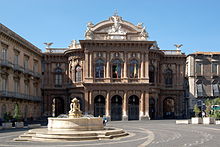
|
| Cesena | Teatro Comunale Alessandro Bonci | The Teatro Comunale Alessandro Bonci is an opera house in Cesena.
The opera house was built on the site of the old Spada Theater from August 1843 according to a design by the architect Vincenzo Ghinelli and opened on August 15, 1846. |
Website |

|
| Chieti | Marrucino Theater | The Teatro Marrucino is a theater building in Chieti. It was completed in 1817 and the opening ceremony took place on January 11, 1818. Originally the theater was dedicated to King Ferdinando I, but was renamed in June 1861 after the unification of Italy in honor of the Marrucini people, who originally came from pre-Roman Abruzzo. | Website |

|
| Como | Teatro Sociale di Como | The Teatro Sociale di Como is a theater building in Como, designed by the architect Giuseppe Cusi. The theater opened in August 1813 with a performance of Marco Antonio Portogallo's opera Adriano in Siria . | Website |
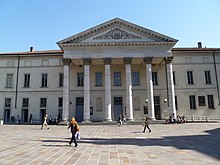
|
| Cosenza | Teatro di tradizione Alfonso Rendano | The Teatro di tradizione Alfonso Rendano is a theater in the heart of the historical center of Cosenza. It is dedicated to the pianist Alfonso Rendano. | Website |

|
| Cremona | Ponchielli Theater | The Teatro Ponchielli in Cremona is an opera house built in 1806 by the architect Luigi Canonica on the ruins of the Teatro della Società, which had previously been destroyed by fire.
It was named after Amilcare Ponchielli in 1907 on the occasion of its centenary. |
Website |
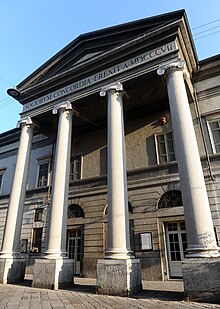
|
| Ferrara | Claudio Abbado Theater | The Teatro Claudio Abbado emerged from the former Teatro Comunale and is an opera house in Ferrara.
The building was designed by architects Cosimo Morelli and Antonio Foschini and built between 1786 and 1797. The Teatro Comunale opened on September 2, 1798 with a performance of Domenico Cimarosa's opera Gli Orazi ei Curiazi and has 990 seats. The premiere of Ciro in Babilonia , an early work by Gioachino Rossini , took place here in March 1812 . Claudio Abbado chose the theater for performances by his Mahler Chamber Orchestra . After his death in the spring of 2014 it was renamed “Teatro Claudio Abbado”. |
Website |
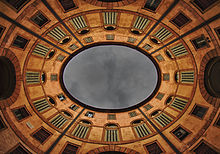
|
| Florence | Opera di Firenze | The Opera di Firenze (also Teatro del Maggio Musicale Fiorentino ) is an opera house opened in 2014 in the Tuscan capital, Florence. It is used for opera, concert and ballet performances and is the seat of the Maggio Musicale Fiorentino opera festival . | Website |

|
| Florence | Teatro Alfieri di Firenze | The Teatro Alfieri di Firenze was a theater in Florence, located between Via Pietrapiana and Via dell'Ulivo. The theater house was founded in 1740 by the Accademia dei Risoluti and was originally called Teatro Santa Maria . It was expanded and renewed several times, with the architects Luigi Sgrilli (1789), Vittorio Bellini (1815 and 1828, with reconstruction in the masonry) and finally Felice Francolini (1882) working. In honor of Vittorio Alfieri , the theater was renamed Teatro Alfieri di Firenze in 1828 . In 1928 the theater was demolished and built on the site of the Palazzo delle Poste e Telegrafi. |

|
|
| Florence | Teatro Comunale di Firenze | The Teatro Comunale di Firenze is an opera house in Florence.
The former amphitheater Politeama Fiorentino Vittorio Emanuele with 6,000 seats was opened on May 17, 1862 with a performance of the opera Lucia di Lammermoor by Gaetano Donizetti and formed the center of cultural creation in Florence. After a fire it was reopened in April 1864. The theater was roofed over in 1882 and renamed the Teatro Comunale after it was taken over by the municipality in 1930 . In 1958 the opera house was closed for 3 years and, after modernization, reopened in May 1961 with a performance of the opera Don Carlos by Giuseppe Verdi . The Teatro Comunale di Firenze has 2,000 seats. Because of the annual Maggio Musicale Fiorentino that takes place there , it is also called Teatro del Maggio Musicale Fiorentino . |
Website |

|
| Florence | Teatro della Pergola | The Teatro della Pergola on Via della Pergola in the center of Florence is (as an institution) one of the oldest opera houses in Italy.
The first building was built in 1656 by the architect Ferdinando Tacca as a wooden structure and opened during the Carnival in 1657 with the opera buffa Il podestà di Colognole by Giovanni Andrea Moneglia. It was the first box theater in Italy in the shape of a horseshoe with three column-supported tiers and a gallery above. The hall has around 1000 seats. Around 1750 the building was provided with stone walls and modernized in the 19th century with a ticket hall with granite columns in neoclassical style. The auditorium floor can be raised to stage level to transform the theater into a full-length ballroom. In 1925 the theater was declared a national monument. Initially only used as a court theater, it was also opened for public events after 1718. Among other things, Mozart's operas were played here for the first time in Italy around 1800 , Donizetti's Parisina and Rosamunde d'Inghilterra, Verdi's Macbeth (first version 1847), Mascagnis I Rantzau and Luigi Dallapiccola's Volo di notte were premiered here. |
Website |

|
| Foggia | Teatro Comunale Umberto Giordano | The Teatro Comunale Umberto Giordano is a theater in Foggia, built by Luigi Oberty and inaugurated in 1828. It is Foggia's main theater. | Website |
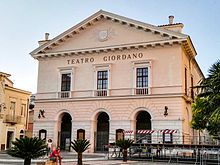
|
| Genoa | Carlo Felice Theater | The Teatro Carlo Felice is the main opera house in the Italian city of Genoa. The house is known at national level and, with its program, which includes operas, ballets, symphonies, but also lectures and other events, is one of the best in Italy.
The theater is located in the central Piazza De Ferrari , and thus in the center of the city itself. In front of the pillars of the main entrance is the equestrian monument of the Italian general and national hero Giuseppe Garibaldi . |
Website |
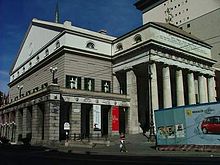
|
| Jesi | Teatro Pergolesi | The Teatro Comunale Pergolesi is an opera house in Jesi that bears the name of the Jesi-born composer Giovanni Battista Pergolesi . The planning and construction of the opera house began in 1790 and the opening took place at Carnival 1798 with the opera Lo spazzacamino principe by Marcos António Portugal .
The opera house was originally called Teatro della Concordia as long as there was still the Teatro del Leone , built in 1732, in the city . The latter was in operation until 1791 and was destroyed by fire in 1892. The Teatro Comunale Pergolesi is still in operation today, "one of the few opera houses in Italy from the late 18th century that was never destroyed by fire or bombs". It was completely renovated in 1995 and is currently managed by the Pergolesi Spontini Foundation. |
Website |

|
| Lecce | Politeama Greco Theater | The Teatro Politeama Greco is a theater building in Lecce. It is located on Via XXV Luglio, next to Castello Carlo V. | Website |
|
| Livorno | Carlo Goldoni Theater | The Teatro Carlo Goldoni is the main theater in Livorno and the only major city theater to survive the bombings of World War II and post-war speculation.
In the theater there is an exhibition dedicated to Pietro Mascagni , which houses some of the composer's relics from his time in Livorno. |
Website |

|
| Livorno | Teatro della Gran Guardia | The Teatro della Gran Guardia was one of the most important theater and film buildings in Livorno from the post-war period to the beginning of the 21st century. It is located on Via Grande, not far from the Piazza Grande.
The name of the theater derives from the military station of the "Gran Guardia", which in ancient times was located at the entrance of the same street. |
Website |

|
| Lucca | Teatro del Giglio | The Teatro del Giglio is the historic city theater and opera house at Piazza del Giglio No. 13 and No. 15 in the center of Lucca. | Website |

|
| Lugo | Teatro Rossini di Lugo | The Teatro Rossini di Lugo is the city theater of Lugo. It is the oldest municipal theater in Emilia-Romagna . The theater house mainly produces opera performances and hosts the Lugo Opera Festival. | Website |

|
| Messina | Teatro Vittorio Emanuele II | The Teatro Vittorio Emanuele II ( Victor Emanuel II Theater ) is a municipal theater with around 1,000 seats in the Sicilian city of Messina. | Website |

|
| Milan | Teatro alla Scala | The Teatro alla Scala in Milan, also known as Scala for short , is one of the most famous and important opera houses in the world. It is located on the Piazza della Scala , after which the opera house was named. The square takes its name from the church of Santa Maria della Scala , which was built here in 1381 and which was named after the founder Beatrice Regina della Scala, the wife of Bernabò Visconti . The Scala has space for 2,030 spectators. | Website |
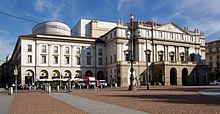
|
| Milan | Carcano Theater | The Teatro Carcano is an opera house in Milan designed by Luigi Canonica . The house was opened on September 3, 1803 with the opera Zaira by Vincenzo Federici with the participation of Giacomo David and Luigi Pacini.
Today nothing can be seen of the original building and its facade, as the theater was rebuilt around 1913 by Nazzareno Moretti in eclectic forms and a floral style and later built over by a frontal building. |
Website |
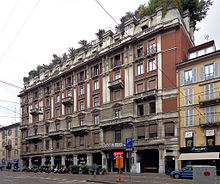
|
| Milan | Teatro degli Arcimboldi | The Teatro degli Arcimboldi (also known as Teatro della Bicocca degli Arcimboldi or with the abbreviation TAM ) is a theater in Milan that was built between 1997 and 2002 on the initiative of the municipal authorities of Milan and Pirelli . It is the work of the famous Milanese architect Vittorio Gregotti. | Website |
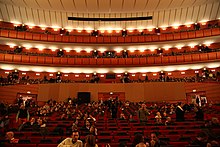
|
| Milan | Teatro Lirico di Milano | The Teatro Lirico di Milano ( known as Teatro alla Canobbiana until 1894 ) is a theater in Milan. Notable opera performances took place here in the 19th and early 20th centuries, including the world premieres of the operas L'elisir d'amore by Gaetano Donizetti and Fedora by Umberto Giordano . The theater on Via Rastrelli was closed in 1998. In April 2007 a restoration project was started with the aim of reopening the theater as Teatro Lirico Giorgio Gaber . |
|
|
| Milan | Teatro Regio Ducale | The Teatro Regio Ducale (often referred to as the Regio Ducal Teatro ) was a theater located in Milan from 1717 to 1776.
The first Teatro Regio Ducale was built in 1598 to celebrate the transit of Margaret of Austria through Milan, who was the promise made by the King of Portugal and Spain, Philip III . It went up in flames in 1699 but was not completely destroyed and underwent some changes and renovations until it was finally destroyed by another fire in 1708. The second Teatro Regio Ducale was only built in 1717 from the ruins of the previous Teatro Ducale. It was recreated - with some developments - based on the first draft of the Teatro Ducale, which was already in place in 1598. The royal-ducal theater was inaugurated on December 26th, 1717 with the performance of the play Costantino by Francesco Gasparini . On February 25, 1776, the Teatro Regio Ducale went up in flames for the third and last time. |
|
|
| Mantua | Teatro Sociale di Mantova | The Teatro Sociale di Mantova is the largest historical theater in Mantua. It is located in the historic center of the city and is owned by the Società dei Palchettisti. It was realized between 1817 and 1822 by the famous Ticino architect Luigi Canonica . | Website |
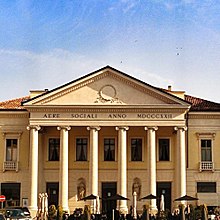
|
| Modena | Teatro Comunale di Modena | The Teatro Comunale di Modena (renamed Teatro Comunale Luciano Pavarotti in October 2007 ) is an opera house in Modena in the province of Emilia-Romagna. The idea to create today's opera house arose in 1838 when it became clear that the then existing Teatro Comunale di via Emilia was no longer suitable for staging operas. So far, all works by Gaetano Donizetti , Vincenzo Bellini and Gioachino Rossini have been presented in this house . The new opera house was designed and built by Francesco Vandelli and it opened on October 2, 1841 with a performance of Gandini's Adelaide di Borgogna al Castello di Canossa, an opera specially commissioned for the occasion. | Website |
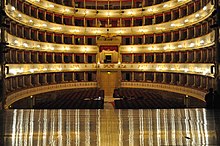
|
| Naples | San Bartolomeo Theater | The Teatro San Bartolomeo was an important theater and opera house in Naples, whose heyday was in the late 17th and early 18th centuries. Located on Via San Bartolomeo, it was the main opera house in the city before the Teatro San Carlo opened .
With the opening of the Teatro San Carlo in 1737, however, the Teatro San Bartolomeo lost its leading role, it stopped its productions and was converted into a church: the Chiesa della Graziella (Santa Maria delle Grazie) in rua Catalana. The church was badly damaged in the 1980 earthquake and was closed to the public for decades; After the necessary restoration work, it was reopened in December 2014 and is the seat of the Centro di musica da camera CERSIM (Center for Chamber Music). |
|
|
| Naples | Mercadante Theater | The Teatro Mercadante is a theater in Naples that was initially known as the Teatro del Fondo . It is located on Piazza del Municipio No. 1, and its front is opposite the west side of Castel Nuovo and near the Siglio dock. Together with the Teatro San Carlo , it was one of the two royal opera houses of the 18th and 19th centuries. | Website |
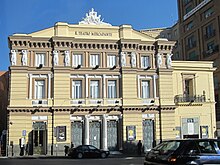
|
| Naples | San Carlo Theater | The Teatro San Carlo is the largest opera house in Naples. The Teatro San Carlo was designed and built in 1735 by the architects Giovanni Antonio Medrano and Angelo Carasale for the Bourbon king Charles VII of Naples . The Teatro di San Carlo was for years the largest opera house with 3,300 seats and, even before the La Scala in Milan , the most prestigious house in Europe and the world and was admired for its architecture and rich furnishings alone. The Teatro San Carlo was also popular with the audience thanks to the numerous world premieres by Vincenzo Bellini , Gaetano Donizetti , Gioachino Rossini and many others .
The theater opened on November 4, 1737 - the king's name day - with the performance of Domenico Sarros Achille in Sciro , who himself conducted his work on the occasion. |
Website |

|
| Novara | Coccia Theater | The Teatro Coccia is the most important opera house in Novara (as well as one of the most important theaters of Italian tradition) and also the most important "historical" theater in Piedmont. The opera house is on Via Fratelli Rosselli and is bordered by Piazza Martiri della Liberty to the west and Piazza Giacomo Puccini to the east. | Website |
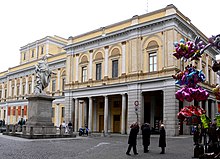
|
| Padua | Teatro Giuseppe Verdi (Padua) | The Teatro Giuseppe Verdi or Teatro Stabile del Veneto is the main theater of Padua. The building, commissioned by a noble Paduan company, was built by the Paduan architect Giovanni Gloria.
The theater was inaugurated in 1751 as Teatro Nuovo e della Nobiltà with a melodrama by Metastasio. |
Website |
|
| Palermo | Teatro Massimo (Palermo) | The Teatro Massimo is Palermo's opera house.
It was built in the historicism style on the Piazza Verdi at the former west gate of the old town of Palermo. The architect was Giovanni Battista Filippo Basile , who began construction in 1875. After his death, the building was completed in 1897 by his son Ernesto Basile . On May 16, 1897, the Teatro Massimo opened with Verdi's opera Falstaff . After a "temporary closure" in 1974 due to structural defects, the Teatro Massimo remained closed for over 20 years due to corrupt, mafia-like building policies. It was only in 1997, thanks to the efforts of Leoluca Orlando, to mark its centenary with Verdi's opera Nabucco under Claudio Abbado . Today the Teatro Massimo symbolizes Palermo's struggle for his “political and cultural resurrection” - against the Mafia. |
Website |

|
| Palermo | Politeama Theater (Palermo) | The Teatro Politeama or Teatro Politeama Garibaldi is a theater building in Palermo. It was built from 1867 to 1874 by Giuseppe Damiani Almeyda in the neoclassical style. Almeyda was inspired by buildings from Pompeii .
Columns are in front of the circular facade, with Doric columns on the ground floor and Ionic columns on the upper floor . The entrance is designed as a triumphal arch and is crowned by a quadriga by Mario Rutelli . |
Website |
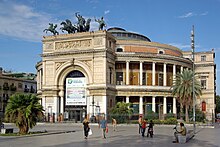
|
| Parma | Teatro Regio di Parma | The Teatro Regio di Parma is an opera and theater house in Parma.
The Teatro Regio was commissioned by Marie-Louise of Austria in 1821 . It was based on a design by the architect Nicola Bettoli on the site of the former St. Alexander monastery in Parma . The facade of the theater is in the style of neoclassicism. The opening was in 1829 with a work by Vincenzo Bellini ( Zaira ). The original name was initially Teatro Ducale , after the death of Marie-Louise of Austria it was renamed Teatro Reale in 1849 and was finally named Teatro Regio in 1860 . The theater is known for performances of the works of Giuseppe Verdi , so the Verdi Festival has been held annually since 2004 . |
Website |

|
| Pavia | Teatro Fraschini | The Teatro Fraschini is a theater building in Pavia. It was opened in 1773 and is used for theater and opera performances. | Website |
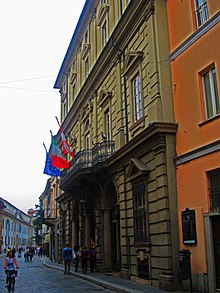
|
| Perugia | Morlacchi Theater | The Teatro Morlacchi , formerly Teatro del Verzaro , is the largest theater in Perugia. It is named after the musician Francesco Morlacchi . | Website |
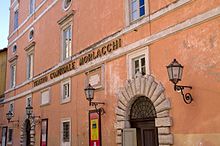
|
| Pesaro | Teatro Rossini (Pesaro) | The Teatro Rossini is an opera house in Pesaro that hosts the Rossini Opera Festival . The opera house was built as the Teatro Nuovo (on the site of the original Teatro del Sole from 1637). The inauguration took place on June 10, 1818 with a performance of Gioacchino Rossini's La gazza ladra , which the composer conducted in his native city. The theater seats 860 people and was given its current name in honor of the composer in 1854. | Website |

|
| Piacenza | Teatro Municipale di Piacenza | The Teatro Municipale di Piacenza is a theater in Piacenza that is used for opera, drama, ballet and concerts. The theater was inaugurated in 1804 with a performance of the opera Zamori ossia L'eroe dell'Indie by Giovanni Simone Mayr | Website |

|
| Pisa | Teatro Verdi (Pisa) | The Teatro Verdi (formerly Regio Teatro Nuovo ) is the main theater building in Pisa. It was built between 1865 and 1867 by the architect Andrea Scala and is a medium-sized theater with 900 seats. The theater was inaugurated on November 12, 1867 with the opera Guglielmo Tell by Gioachino Rossini . | Website |

|
| Prato | Metastasio Theater | The Teatro Metastasio is a theater in Prato in Tuscany . The construction of the theater goes back to an initiative by Benedetto Cecconi in 1820 for the construction of a new theater house. which should replace the old Teatro dei Semplicigiudicato . The construction of the theater was started by the Florentine architect Luigi De Cambray Digny in 1829 and inaugurated on October 8, 1830 with the opera Aureliano in Palmira by Gioachino Rossini . | Website |

|
| Ravenna | Teatro di tradizione Dante Alighieri | The Teatro di tradizione Dante Alighieri is the main theater in Ravenna. It is located in the historical center at Via Mariani 2. The inauguration of the theater took place on May 15, 1852 with Robert le diable by Giacomo Meyerbeer under the direction of Giovanni Nostini. | Website |

|
| Reggio Calabria | Teatro Francesco Cilea | The Teatro Francesco Cilea in Reggio Calabria takes its name in memory of the Calabrian composer Francesco Cilea . With a capacity of 1,500 it is the largest theater in Calabria. | Website |

|
| Reggio Emilia | Teatro Municipale (Reggio Emilia) | The Teatro Municipale ( also called Teatro Municipale Valli in honor of the actor Romolo Valli since the 1980s ) is a theater in Reggio Emilia.
After the Teatro Cittadella was destroyed in April 1851, the new theater was designed by the architect Cesare Costa and built between 1852 and 1857 in the neoclassical style. Its opening took place on April 21, 1857. |
Website |
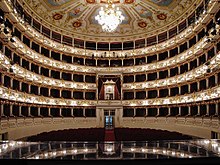
|
| Rome | Argentina Theater | The Teatro Argentina in Rome is located on Largo di Torre Argentina and is one of the most important theaters in the Italian capital.
The Teatro Argentina, one of the oldest theaters in Rome, was inaugurated on January 31, 1732 with the opera Berenice by Domenico Sarro . On February 20, 1816, the premiere of the Barber of Seville by Rossini took place here. Several operas by Saverio Mercadante and Giuseppe Verdi's operas I due Foscari and La battaglia di Legnano were also premiered here. Today the Teatro Argentina serves as a spoken theater as well as for the performance of operas and symphonies. The interior of the house houses a theater museum ( Museo Storico del Teatro ) with an archive of images and documents. |
Website |

|
| Rome | Teatro Capranica | The Teatro Capranica is a theater building located at 101 Piazza Capranica in the Colonna district of Rome. Originally built by the Capranica family in 1679 and housed in the early Renaissance Palazzo Capranica, it was the second public theater to open in Rome. Numerous world premieres of baroque operas have taken place here, including Antonio Caldara's Tito e Berenice , Alessandro Scarlatti's Griselda and Antonio Vivaldi's Ercole su'l Termodonte . The Teatro Capranica has not been used as a full theater and opera house since 1881 and was converted into a cinema in 1922. After the cinema was closed in 2000, it functions as a conference and performance venue on a rental basis. | Website |

|
| Rome | Teatro dell'Opera di Roma | The Teatro dell'Opera di Roma is an opera house on the Viminal in Rome. The house opened in November 1880 under the name Teatro Costanzi and is located at Piazza Beniamino Gigli 1.
The building, steeped in history, was commissioned by the financier Domenico Costanzi (1810–1898) and designed by the architect Achille Sfondrini (1836–1900). The Teatro dell'Opera di Roma was built in a construction period of 18 months and received its first name, Teatro Costanzi , after the client. The opening took place on November 27, 1880 with a performance of the Opera seria Semiramide by Gioachino Rossini . In the Opera Roma , which has 2,200 seats, numerous premieres took place, such as the operas Cavalleria rusticana (May 17, 1890) by Pietro Mascagni or Giacomo Puccini's Tosca (January 14, 1900). |
Website |

|
| Rovigo | Teatro Sociale di Rovigo | The Teatro Sociale di Rovigo is a theater in Rovigo. The neoclassical theater was built by the architect Rovigo Sante Baseggio and completed in 1819. The official inauguration took place on April 16, 1819. | Website |
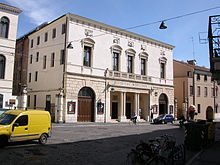
|
| Salerno | Teatro Verdi (Salerno) | The Teatro Municipale Giuseppe Verdi is a theater building in Salerno. It was built from 1863 and inaugurated on April 15, 1872 with Giuseppe Verdi's Rigoletto . | Website |

|
| Sassari | Teatro Civico (Sassari) | The Teatro Civico is a theater in Sassari. It is located in the heart of the city on Corso Vittorio Emanuele II. It was built according to plans by the then city architect Giuseppe Cominotti. | Website |

|
| Savona | Teatro dell'Opera Giocosa | The Teatro dell'Opera Giocosa is an opera house in Savona. | Website |
|
| Savona | Gabriello Chiabrera Theater | The Teatro Gabriello Chiabrera is a theater building in Savona. It is the main theater in the city and is named after the poet and playwright Gabriello Chiabrera. It defines itself as the most beautiful historical theater in Liguria that is in operation. | Website |

|
| Spoleto | Teatro Lirico Sperimentale | The Teatro Lirico Sperimentale in Spoleto was founded in 1947 by Adriano Belli, lawyer and musicologist, with the aim of preparing young singers who have not yet made their debut for an artistic career.
<< More information available >> |
Website |

|
| Spoleto | Teatro Nuovo Gian Carlo Menotti | The Teatro Nuovo Gian Carlo Menotti ( Teatro Nuovo until 2010 ) is a theater building in Spoleto in the province of Perugia. It is also the largest Italian theater in Umbria with 800 seats. | Website |

|
| Tortona | Teatro Civico Tortona | The Teatro Civico Tortona is a theater building in Tortona. | Website |
|
| Treviso | Teatro Comunale Mario Del Monaco | Il Teatro Comunale Mario Del Monaco is a theater building in Treviso. Located in the historical center, it is the main theater in the city. It was named in 2011 after the famous tenor Mario Del Monaco . | Website |

|
| Trieste | Teatro Giuseppe Verdi | The Teatro Lirico Giuseppe Verdi is the largest opera house in the northern Italian city of Trieste and the only house in Italy that hosts an annual operetta festival. The opera house was built between 1798 and 1801 by the architects Gian Antonio Selva , who had already designed the Venetian Teatro La Fenice , and Matteo Pertsch . At the opening of the house on April 21, 1801, the opera Ginevra di Scozia by the Bavarian composer Johann Simon Mayr was performed. | Website |
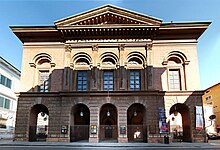
|
| Turin | Carignano Theater | The Teatro Carignano is a theater in Turin and one of the oldest theaters in Italy. It was designed by Benedetto Alfieri and is opposite the Palazzo Carignano . Construction began in 1752 and the theater was inaugurated the following year with a performance of Baldassare Galuppi's opera Calamità de 'cuori . Much of the theater was destroyed in a fire in 1786, but it was rebuilt in a few months according to Alfieri's original plans. Since then it has been renovated several times. Although it is mainly used for theatrical performances today, it used to be an important opera house. The theater is owned by the City of Turin, but managed by the Teatro Stabile di Torino theater company and is one of the ensemble's main venues. | Website |
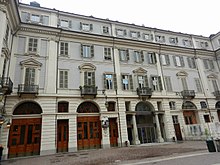
|
| Turin | Teatro Regio di Torino | The Teatro Regio di Torino is an opera and theater house in Turin. It was built by the builder Benedetto Alfieri according to plans by the architect Filippo Juvarra in the Piazza Castello in the city center. The opening took place in 1740 with the performance of a work by Francesco Feo . By royal order, the theater was closed in 1792 and the building was used as a warehouse. During the French occupation of Turin under Napoleon Bonaparte , the theater was reopened and renamed the Teatro Nazionale . After the French left, the theater remained open, but was renamed the Teatro Imperiale again. After times of financial uncertainty, the house was taken over by the city of Turin in 1870. One of the heyday of the house were the years 1895–1898 under the direction of Arturo Toscanini with numerous premieres of Richard Wagner's works . Giacomo Puccini's La Bohème also premiered on February 1, 1896 . | Website |

|
| Turin | Teatro Vittorio Alfieri (Turin) | The T eatro Vittorio Alfieri is a theater building in Turin. Located in Piazza Solferino, it now regularly hosts theatrical performances. | Website |

|
| Venice | La Fenice Theater | The Teatro La Fenice (full name Gran Teatro La Fenice di Venezia ) is the largest and most famous opera house in Venice.
In 1774 the most important opera house in Venice, the Teatro San Benedetto , fell victim to a fire. After the reconstruction, a legal dispute broke out in 1786 between the owners, a consortium of lodge owners, and the Venier patrician family, who owned the property. The theater was renamed Teatro Venier and the old operators decided to build their own house. Construction began in April 1790 under the direction of the architect Gian Antonio Selva . The opera was opened on May 16, 1792 and named "La Fenice" (Italian for phoenix ) in allusion to the fire disaster . The stage quickly became one of the most important in Italy and Europe and saw numerous world premieres. |
Website |

|
| Venice | Malibran Theater | The Teatro Malibran , formerly the Teatro San Giovanni Grisostomo (today mostly: Crisostomo ) is an opera house in the Cannaregio district of Venice, which is located about fifty meters east of the church of San Giovanni Crisostomo . It is known for its extraordinary importance for opera in the 17th and 18th centuries. The theater was designed by Tommaso Bezzi for the Grimani family and inaugurated during Carnival in 1678 with a performance of Vespasiano by Carlo Pallavicino . | Website |
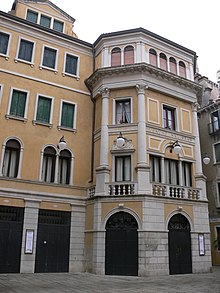
|
| Venice | San Benedetto Theater | The Teatro San Benedetto was a theater in Venice, parts of which still exist today. The small theater was built by Michele Grimani of the Grimani family on land owned by the Venier and Tiepolo families and was intended to serve as a smaller theater to replace the family's San Giovanni Crisostomo . It was inaugurated on December 26, 1755 with a performance of Gioacchino Cocchi's opera Zoe . |
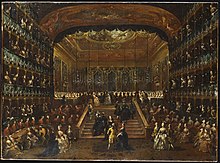
|
|
| Venice | San Cassiano Theater | The Teatro San Cassiano or Teatro di San Cassiano in the San Polo district of Venice was the world's first public opera house. It was opened in 1637.
The theater got its name after the neighboring parish church of San Cassiano near the Rialto . It was housed in a stone building owned by the Venetian Tron family. It can be considered a “public” theater because it was run by an impresario and the public had access and paid for entry, while other theaters outside of Venice were only open to aristocrats during this period. The Teatro San Cassiano premiered some of the earliest operas, including various operas by Francesco Cavalli (such as L'Ormindo and Giasone ). The last performance in the opera house took place in 1807. In 1812 the house was demolished after several fires. |
|
|
| Venice | Teatro San Moisè | The Teatro San Moisè was an opera house in Venice that lasted from 1640 to 1818. It was in an outstanding location near the Palazzo Giustiniani and the Church of San Moisè at the beginning of the Grand Canal . The theater was built by the San Bernaba branch of the Giustiniani family. The first production was the now-lost opera L'Arianna by Claudio Monteverdi in 1640 . The San Moisè was finally closed in 1818 after the presentation of a series of farsens by Gioachino Rossini , whose second opera La cambiale di matrimonio premiered here in 1810. It was first used as a puppet theater and then converted into the Teatro Minerva. Until the end of the 20th century, the building complex was partly used for commercial purposes and partly as a residential building. On July 19, 1896, the Lumière brothers' first public film screening in Venice took place here. |

|
|
| Venice | San Samuele Theater | The Teatro San Samuele was one of seven theaters that operated in Venice during the 18th century . It was built in 1656 by order of the Grimani family (who also built other theaters in Venice, including the Teatro San Giovanni Grisostomo ) and was originally intended for drama. It was not until the following century that operas (especially opera buffa ) and ballets were performed more frequently . The theater was demolished in 1894. |

|
|
| Venice | Teatro Sant'Angelo | The Teatro Sant'Angelo (sometimes erroneously: Teatro San Angelo ) was a theater and opera house in Venice that opened in 1677 (architect Francesco Santurini) and existed until 1803. Many of the operas by Antonio Vivaldi were premiered here, who also directed it musically and temporarily as impresario . It was located on the Grand Canal near the Rialto Bridge. It was run by the Marcello and Capello families, who previously had town houses there. |

|
|
| Verona | Arena di Verona | The Arena di Verona is a well-preserved Roman amphitheater in Verona.
The theater was built around 30 AD and was then outside the Roman city wall of Verona. In Roman times, the arena held over 30,000 spectators and was used for gladiatorial fights and competitions. After an earthquake in 1117 that destroyed most of the outer ring, the arena served as a quarry for the growing medieval city. In 1278 the arena was the site of the last great Cathar execution. In the Renaissance there were efforts to use the building as a theater again. But this has only been happening regularly since 1913. On August 10, 1913, on the occasion of Giuseppe Verdi's 100th birthday, the opera Aida was performed. Thanks to the excellent acoustics , the arena quickly established itself as a concert venue. Today, opera performances and rock concerts take place mainly in June, July and August. |
Website |
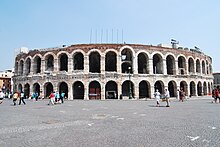
|
| Vicenza | Teatro Olimpico (Vicenza) | The Teatro Olimpico in Vicenza is the first free-standing autonomous theater building built in Europe since the end of antiquity . The architect of the theater is Andrea Palladio . | Website |
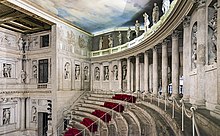
|
Croatia
| place | Opera house | Details | Official website | image |
|---|---|---|---|---|
| Osijek | Croatian National Theater in Osijek | The Croatian National Theater in Osijek ( Croatian : Hrvatsko narodno kazalište u Osijeku ) is a theater building in Osijek, the capital of the Croatian region of Slavonia .
The building was opened in 1866 and expanded in 1907 according to the plans of the architect Karlo Klausner and completed in 1907. The theater building was damaged by the JNA in the 1990s during the Croatian War of Independence, extensively restored and officially reopened in December 1994 by the then Croatian President Franjo Tuđman . |
Website |

|
| Rijeka | Croatian National Theater in Rijeka | The Croatian National Theater in Rijeka "Ivan Zajc" (Croatian: Hrvatsko narodno kazalište Ivana pl. Zajca u Rijeci ) is a multi-branch theater in the Croatian port city of Rijeka. It is named after the Rijeka-born composer and conductor Ivan Zajc . | Website |

|
| Split | Croatian National Theater in Split | The Croatian National Theater in Split (Croatian: Hrvatsko Narodno Kazalište - HNK u Splitu ) is a theater building in Split. It was founded in 1893.
The theater is located on Trg Gaje Bulata (Gaje Bulat Square) in Split. The theater has been a member of the European Theater Convention since 1999. |
Website |
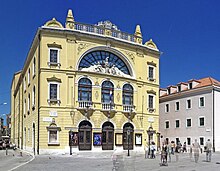
|
| Zagreb | Koncertna dvorana Vatroslava Lisinskog | The Koncertna dvorana Vatroslava Lisinskog (German: Concert Hall Vatroslav Lisinski ) or in short: Lisinski is a concert and congress hall in the Croatian capital Zagreb.
The hall was built according to plans by the architect Marijan Haberle and opened in December 1973. There is a large hall with 1,841 seats and a small one with 305 seats. In addition to international specialist conferences, classical music, theater and ballet are performed. In 1990 the Eurovision Song Contest took place here. |
Website |

|
| Zagreb | Croatian National Theater in Zagreb | The Croatian National Theater in Zagreb (Croatian Hrvatsko Narodno Kazalište , HNK ) is located in the Croatian capital Zagreb.
It was founded in 1840 and sponsored by government agencies together with other Croatian national theaters. In 1870 a national opera company was founded. In 1895, the theater moved into the building that has been used to this day. The Austro-Hungarian Emperor Franz Joseph I (Austria-Hungary) also took part in the inauguration of the new magnificent building. The building was designed by the Viennese architects Ferdinand Fellner and Hermann Helmer (see Fellner & Helmer office ), who were responsible for numerous theaters throughout Europe. The Zagreb theater is largely identical to the Zurich Opera House (1891) and the Court Theater in Wiesbaden, built in 1892/94, today the Hessisches Staatstheater Wiesbaden . |
Website |

|
| Varaždin | Croatian National Theater in Varaždin | The Croatian National Theater in Varaždin is a theater building in the Croatian city of Varaždin. | Website |
|
Latvia
| place | Opera house | Details | Official website | image |
|---|---|---|---|---|
| Riga | Latvian National Opera | The Latvian National Opera ( Latvian : Latvijas Nacionālā opera ) is an opera house in the Latvian capital Riga. The building, built in the neoclassical style , was built between 1860 and 1863 based on designs by Ludwig Bohnstedt (1822–1885). The building was initially designed as a "German Theater".
The building burned down on June 16, 1882 and was rebuilt under the direction of the architect Reinhold Schmaeling (1840–1917). The Latvian National Opera has been located in this building since 1919. |
Website |

|
Liechtenstein
| place | Opera house | Details | Official website | image |
|---|---|---|---|---|
| Vaduz | Vaduz Opera Association | The Vaduz Opera Association is an opera association in Vaduz. It was founded in 1997 as a registered association. The association stages an opera of classical music literature every two years and also performs in concert. | Website |
|
Lithuania
| place | Opera house | Details | Official website | image |
|---|---|---|---|---|
| Kaunus | Kaunas Music Theater | The Kaunas Music Theater ( Lithuanian : Kauno muzikinis teatras ) is an opera house in Kaunas.
The theater building was built in 1890–91 according to the plans of the architect Ustin Golinewitsch. |
Website |
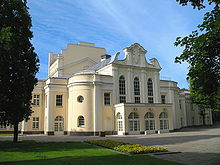
|
| Klaipeda | Klaipėda Music Theater | The Klaipėda Music Theater (Lithuanian: Klaipėdos valstybinis muzikinis teatras ) is an opera house in the Lithuanian port city of Klaipėda.
The theater was founded in 1987. The Klaipėda Folk Opera Theater (1956–1986) formed the core of the theater. The theater opened on April 23, 1988 with Audronė Žigaitytė's opera Mažvydas based on a drama by Justinas Marcinkevičius . The Symphony Orchestra of Lithuania Minor has been playing in the Klaipėda Music Theater since 1993 . |
Website |

|
| Vilnius | Lithuanian National Opera and Ballet Theater | The Lithuanian National Opera and Ballet Theater (Lithuanian: Lietuvos nacionalinis operos ir baleto teatras ) is a state opera house and theater in the Lithuanian capital, Vilnius. The theater was founded by the Ministry of Culture of Lithuania . It is located in the old town of Vilnius . | Website |

|
| Vilnius | Vilnius City Opera | The Vilnius City Opera is an opera house in Vilnius created for the performance of operas and musicals. | Website |
|
Luxembourg
| place | Opera house | Details | Official website | image |
|---|---|---|---|---|
| Luxembourg | Grand Théâtre de la Ville de Luxembourg | The Grand Théâtre de la Ville de Luxembourg is a theater, opera and ballet venue in Luxembourg. The theater was opened in 1964 after four years of construction. The large hall ("Grande Salle") has 934 seats, the small hall ("Studio") 400 seats.
At the inauguration, the theater was called Nouveau théâtre de Luxembourg , then for a long time Théâtre municipal Luxembourg and since 2003 Grand théâtre de la ville de Luxembourg . The architect of the building is the French Alain Bourbonnais. The Concours Eurovision de la Chanson in 1973 and 1984 took place in the theater . |
Website |

|
Malta
| place | Opera house | Details | Official website | image |
|---|---|---|---|---|
| Victoria , Gozo | Teatru Valley-Opra Aurora | The Teatru Tal-Opra Aurora is a theater building in Gozo. | Website |
|
| Victoria, Gozo | Teatru Astra | The Teatru Astra is a theater building in Gozo. | Website |
|
| Valletta | Royal Opera House (Valletta) | The Royal Opera House ( Maltese It-Teatru Rjal ) is a former opera house in the Maltese capital Valletta. The building, erected in 1866, was largely destroyed in World War II and is now used as an open-air theater .
The opera house was inaugurated on October 9, 1866 after five years of construction with a performance of the opera I puritani by Vincenzo Bellini . It had 1095 seats and 200 standing places, a good double that of the Teatru Manoel, also located in Valletta . |
Website |

|
| Valletta | Teatru Manoel | The Teatru Manoel is a Valletta theater that has been performing since 1732. Malta's National Theater is one of Europe's oldest theaters. It is considered to be the third oldest recorded theater in the world and the oldest in the Commonwealth .
The tragedy Merope by Scipione Maffei was first performed on January 9, 1732. |
Website |
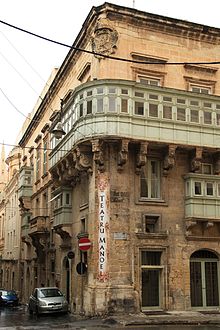
|
Macedonia
| place | Opera house | Details | Official website | image |
|---|---|---|---|---|
| Skopje | Macedonian National Theater | The Macedonian National Theater is a theater building in Skopje. The new theater building is located on the left bank of the Vardar River and was built on the foundations of the old theater that was destroyed in the 1963 Skopje earthquake. | Website |
|
| Skopje | Macedonian Opera and Ballet | The Macedonian Opera and Ballet is a state cultural institution and the oldest of its kind in Macedonia. | Website |
|
Moldova
| place | Opera house | Details | Official website | image |
|---|---|---|---|---|
| Chișinău | National Opera and Ballet Theater of Moldova | The National Opera and Ballet Theater of Moldova is a theater building in Chişinău and one of the leading opera and ballet theaters in Eastern Europe. In 2012 it was named after the famous opera singer Maria Bieșu. | Website |

|
Monaco
| place | Opera house | Details | Official website | image |
|---|---|---|---|---|
| Monte Carlo | Opéra de Monaco | The Opéra de Monaco (also Opéra de Monte Carlo or Grand Théâtre de Monte Carlo ) is the opera house in the Principality of Monaco . It is a neo-manian building by Charles Garnier . The opening took place on January 25, 1879. At this event, Sarah Bernhardt appeared as a nymph . The first opera was the premiere of Robert Planquette's Le Chevalier Gaston on February 8, 1879. | Website |
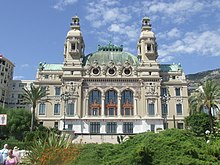
|
Netherlands
| place | Opera house | Details | Official website | image |
|---|---|---|---|---|
| Amsterdam | Concertgebouw |
Koninklijk Concertgebouw ( Dutch for Royal Concert Hall) is the name of a famous concert hall in the Oud-Zuid district of Amsterdam in the Amsterdam Zuid district .
The concert hall was opened on April 11, 1888 with 120 musicians, 500 choir singers and works by Wagner, Handel, Bach and Beethoven. There are four halls. The large hall has 1,962 seats, the small hall 437 , which was restored in 2004 , and there is also the choir hall and the hall of mirrors. The building and orchestra were connected to one another until 1952; since then there have been separate organizations. For its 125th anniversary in 2013, Queen Beatrix awarded the Concertgebouw the title of Koninklijk ('Royal'). |
Website |

|
| Amsterdam | De Nationale Opera |
De Nationale Opera , formerly: De Nederlandse Opera (German: Dutch Opera ), short: DNO, is a Dutch opera company based in Amsterdam.
De Nederlandse Opera was founded shortly after the end of the Second World War as a repertoire company with a permanent ensemble. At that time the company had its headquarters in the Stadsschouwburg Amsterdam , a theater des fin de siècle on Leidseplein in Amsterdam, but also regularly showed its productions in The Hague, Rotterdam, Utrecht and other Dutch cities. In 1964, the switch to the Stagionesystem and the renaming in De Nederlandse Operastichting (German: Dutch Opera Foundation ) took place. Since then, a separate ensemble of guests has been put together for each production. Since 1986 the main venue of the DNO has been in the Muziektheater , a modern building designed by the architect Cees Dam. |
Website |
|
| Amsterdam | Het Muziektheater |
Het Muziektheater is a theater building in Amsterdam that was specially built for the performances of operas, ballets, but also other genres of musical theater. The opera and drama companies used to play together in the Stadsschouwburg Amsterdam .
The building was designed by the architects Wilhelm Holzbauer and Cees Dam. Het Muziektheater was officially opened on September 23, 1986. Since then it has been the home of De Nederlandse Opera and Het Nationale Ballet. In addition, other theater companies also appear in Het Muziektheater. The building complex of today's music theater is popularly called Stopera because it is also used by the city administration. The name is a combination of St adthaus and Opera ( St adhuis s opera is). |
Website |

|
| Amsterdam | Stadsschouwburg Amsterdam | The Stadsschouwburg Amsterdam (City Theater Amsterdam) is a traditional theater on Leidseplein in Amsterdam. In 1894 the theater was inaugurated in its present form. Since baroque opera, ballet and dance performances are also shown, it is a much frequented place to visit even with tourists. | Website |

|
| Enschede | Nederlandse Reisopera | The Nederlandse Reisopera (formerly Nationale Reisopera ), known abroad as the Dutch Touring Opera , is an opera company based in Enschede that travels across the country with large and small opera productions. The company is part of the Nationaal Muziekkwartier in Enschede and produces at least three large productions in the major Dutch theaters every year.
The Nederlandse Reisopera has its own talent program, which includes the Zangersensemble with national and international young talent. |
Website |
|
| Maastricht | Opera Zuid | The Opera Zuid is a Dutch opera company, founded in 1991, based in Maastricht. | Website |

|
Norway
| place | Opera house | Details | Official website | image |
|---|---|---|---|---|
| Mountains | Bergen Nasjonale Opera | The mountains Nasjonale Opera in Bergen, Norway, originally Den Nye Opera called (the new opera) is a foundation that 2005 National from the Bergen Philharmonic Orchestra, The Scene, Grieg Hall and the Bergen International Festival was founded. In 2007 Opera Vest became part of the foundation, which is to serve as the regional opera house for Western Norway. | Website |
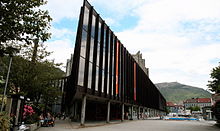
|
| Mountains | Opera mountains | The Opera Bergen is an independent opera company based in Bergen, which was founded in 1982 by Anne Randine Øverby and Tone Kvam Thorsen. | Website |
|
| Heaps | Opera Østfold | The Opera Østfold is an opera company based in Halden. | Website |
|
| Kristiansand | Opera Sør (Kristiansand) | The Opera Sør is an opera company based in Kristiansand. | Website |
|
| Kristiansund | Operaen i Kristiansund | The Operaen i Kristiansund is an opera company based in Kristiansund. | Website |
|
| Nordfjordeid | Nordfjordeid Opera House | The Opera House Nordfjordeid is an opera house based in Nordfjordeid in Norwegian municipality city . | Website |

|
| Oslo | Den Norske Opera & Ballet |
Den Norske Opera & Ballett ( Norwegian Opera & Ballet ), based in Oslo, is Norway's largest music theater and the only Norwegian institution of its kind that exclusively employs professional artists.
The opera is organized as a public limited company , 90% owned by the Norwegian State and 10% by the Norwegian Opera Fund . The activities of the stock corporation are divided into seven program areas:
A new opera house was opened on April 12, 2008 at the Oslo harbor, see Oslo Opera House . |
Website |

|
| Oslo | Oslo Opera House | The Oslo Opera House in Oslo has been the venue for the Norwegian Opera since April 2008 .
The new opera is considered to be the largest Norwegian cultural project of the post-war period. The building, modeled on a floating iceberg, was designed by the Norwegian architecture firm Snøhetta (“Snow Cap”), which had already designed the new library in Alexandria in Egypt . The opera house is 110 meters wide, 207 meters long and has more than 1,100 interior rooms on an area of 38,500 square meters. Of the three playing areas, the main stage is the largest with 1,358 seats for the audience. The new opera was opened on April 12, 2008. 20 vocal soloists and 60 dancers took part in the opening gala; Excerpts from Richard Wagner's opera Der Fliegende Holländer were performed . |
Website |

|
| Tromso | Nordnorsk Opera | The Nordnorsk Opera og Symphony Orchestra is an opera company and orchestra with firm based in Bodø and Tromsø, which covers the entire northern Norway. Nordnorsk Opera og Symfoniorkester AS was founded on June 18, 2009 and is one of the largest cultural institutions in Northern Norway. The owners are the municipalities of Tromsø and Bodø, who each own 50 percent. | Website |
|
Austria
| place | Opera house | Details | Official website | image |
|---|---|---|---|---|
| Baden near Vienna | Baden City Theater | The Stadttheater Baden is one of the theaters in Baden in Lower Austria and is organizationally part of the Baden stage . Operas, operettas, musicals and drama / spoken theater are given on the stage. | Website |

|
| Bregenz | Vorarlberg State Theater | The Vorarlberger Landestheater is a theater with a permanent cast and numerous guests in Bregenz. It offers fixed games for the city of Bregenz and the state of Vorarlberg from September to June. | Website |

|
| Graz | Graz Opera House | The Graz Opera House is a neo-baroque theater building located on the Opernring, in the center of the Austrian city of Graz. The free-standing building, which is still used as an opera house, was built in 1899 as a rank box theater according to plans by the Viennese architectural duo Fellner & Helmer and is the second largest opera house in Austria after the Vienna State Opera .
The high standard of the house is articulated by the monumental design language of the building and the opulent auditorium, which is furnished in the Baroque and Rococo style and has almost 1,400 seats .The Graz Opera House is a multi-branch house and, in addition to ballet, musicals and operettas, maintains thematically in its performances the examination of tradition and the present. |
Website |

|
| innsbruck | Tyrolean State Theater | The Tyrolean State Theater is in Innsbruck. The big house has about 800 seats. The Kammerspiele as the second venue were completely demolished in 2015/16. A hall in the exhibition grounds will be used as a temporary solution until the new Kammerspiele are completed. The program includes drama, opera, operettas, musicals and dance theater; the Tyrolean Symphony Orchestra is responsible for the music . | Website |

|
| Klagenfurt | City Theater Klagenfurt | The Stadttheater Klagenfurt is a municipal theater of the city of Klagenfurt in Austria. | Website |

|
| Linz | State Theater Linz | The Linz State Theater is the largest theater in Upper Austria . It operates the venues Playhouse (formerly Big House) and intimate theater on the promenade and the Music Theater am Volksgarten. Until 2016/17 there was also the u \ hof: (later: Young Theater) in the Upper Austrian Kulturquartier. | Website |

|
| Linz | Linz Music Theater | The Musiktheater Linz is a venue of the State Theater Linz . The building planned by Terry Pawson was constructed between 2008 and 2013 and serves as the theater and opera house of the city of Linz. The official commissioning of the music theater, opened by Heinz Fischer on April 11, 2013 , took place on April 12, 2013 with the world premiere of the opera Traces of the Lost by Philip Glass based on the play of the same name by Peter Handke . | Website |

|
| Salzburg | Salzburg State Theater | The Salzburger Landestheater is a theater in Salzburg, Austria, with its own ensembles for drama, ballet and musical theater (opera, operetta, musical). The house's repertoire consists of contemporary and classical works with 400 performances per season. A total of 340 people from 35 different countries work at the Salzburg State Theater. The building with 707 seats is also used by the Salzburg Festival for drama performances in summer . The house is a listed building and is part of the UNESCO World Heritage Historic Center of the City of Salzburg . | Website |
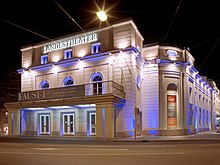
|
| Vienna | Art Nouveau Theater Vienna | The Art Nouveau theater in Vienna was originally designed as a society house, later used for theater performances, concerts and events, and has been empty for years. |

|
|
| Vienna | New Opera Vienna | The Neue Oper Wien is a free opera company without its own venue, which was founded in 1990 in Vienna by the French director Olivier Tambosi . | Website |
|
| Vienna | Schönbrunn Palace Theater | The Schönbrunn Palace Theater or Music Theater Schönbrunn is a stage in the Schönbrunn Palace in the Austrian capital Vienna. As a baroque theater, it is one of the most atmospheric rooms at the University of Music and Performing Arts Vienna . | Website |
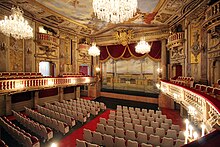
|
| Vienna | Siren Opera Theater | The Sirene Operntheater (spelling: sirene Operntheater) emerged from the collaboration between Kristine Tornquist and Jury Everhartz in Vienna in 1998 and has been producing operas and music theater in different venues since 2002, under this name since 2002. | Website |
|
| Vienna | Theater at the Kärntnertor | The Theater am Kärntnertor , also Kärntnertortheater or in the old spelling Kärnthnerthor-Theater , was a theater in Vienna intended for opera, ballet and drama. Together with the Burgtheater on Michaelerplatz, it can be seen as the forerunner of the Vienna State Opera . |

|
|
| Vienna | Theater an der Wien | The Theater an der Wien is a traditional theater on Linke Wienzeile , in Vienna's 6th district of Mariahilf , which is operated as part of the United Theater in Vienna . Since January 2006 it has been nicknamed The New Opera House . The theater currently has 1,129 seats and 50 standing places . | Website |

|
| Vienna | Volksoper Vienna | The Volksoper Wien is the second largest opera house in Vienna. The program includes operettas, operas, musicals and ballet. The opera house opened on December 14, 1898. | Website |

|
| Vienna | Vienna Chamber Opera | The Vienna Chamber Opera is an opera house on the northern edge of Vienna's inner city , which is played in the stagione system. The Chamber Opera has been sponsored by the Theater an der Wien since autumn 2012 . | Website |

|
| Vienna | Vienna State Opera | The Vienna State Opera , the "First House on the Ring ", is one of the most famous opera houses in the world and is located in Vienna's 1st district, Inner City . It opened on May 25, 1869 with a premiere of Don Giovanni by Mozart . The Vienna Philharmonic , among others, is recruited from the members of the State Opera Orchestra . The Vienna State Opera Choir performs externally as the Vienna State Opera Choir Concert Association . | Website |

|
| Vienna | Viennese pocket opera | The Wiener Taschenoper is an Austrian opera company based in Vienna. | Website |
|
Poland
| place | Opera house | Details | Official website | image |
|---|---|---|---|---|
| Białystok | Podlaskie Opera and Philharmonic | The Podlaskie Opera and Philharmonic - European Center of Art ( Polish Opera i Filharmonia Podlaska - Europejskie Centrum Sztuki ) is the most important cultural institution of Podlaskie , the north-eastern part of Poland. The center opened on September 28, 2012. | Website |

|
| Wroclaw | Wroclaw Opera | The Breslau Opera (Polish: Opera Wrocławska ) is an institution that plays operas in the former Wroclaw City Theater. The opera house is located in the Stare Miasto district of Wroclaw near the Dorotheenkirche . | Website |

|
| Bromberg | Opera Nova w Bydgoszczy | The Opera Nova w Bydgoszczy is an opera house in Bydgoszcz that has existed since 1956. It is one of 10 opera houses in Poland and the only one of its size in the Kuyavian-Pomeranian Voivodeship . | Website |

|
| Bytom | Silesian Opera | The Silesian Opera (Polish: Opera Śląska ) is an opera company in Bytom, which was founded in 1945 in the former municipal theater of Bytom in Upper Silesia . | Website |
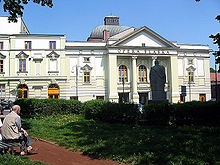
|
| Danzig | Opera Bałtycka | The Opera Bałtycka is an opera company based in Gdansk. The forerunner was the music and drama studio established in February 1949 (Polish: Studio Muzyczno-Dramatyczne). In the autumn of 1949 the opera studio (in Polish: Studio Operowe) of the Baltic Philharmonic was founded. In 1953 they were united under the name of the Baltic State Opera and Philharmonic. After the division of the institution, the Opera Bałtycka was created in 1993. | Website |
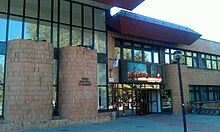
|
| Krakow | Opera Krakowska | The Opera Krakowska is an opera house that was founded in 1954 in Krakow. Krakow's operatic tradition dates back to 1628 when the first full Polish libretto was published by a local publisher, followed by the city's first full opera performance in March 1782.
The Kraków Opera House hosts 200 performances each year, including ballet, operettas and musicals for young people. The Kraków Opera repertoire includes both international and Polish opera classics and reaffirms its status as one of the leading opera houses in the country. |
Website |
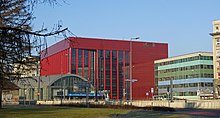
|
| Łódź | Teatr Wielki (Łódź) | The Teatr Wielki (German: Great Theater ) is the largest theater in the Polish city of Łódź.
The theater was opened on January 19, 1967, is now one of the most important opera venues in Poland and is known for its operas, operettas and ballet performances. The theater building on Dąbrowski Square is one of the largest opera houses in Poland and can accommodate 1,070 spectators. The entire cubage of the building amounts to approx. 195,000 m³. The main stage is 26 meters wide and 39.5 meters deep (including the rear stage) and is equipped with 6 large lowering platforms that can be moved vertically in any configuration. The theater also hosts the Łódzkie Spotkania Baletowe ballet festival, and the Camerimage film festival was held here from 2000–2009 . |
Website |

|
| Lublin | Teatr Muzyczny w Lublinie | The Teatr Muzyczny w Lublinie is a theater house based in Lublin, which emerged from the Prywatnego Teatru Muzycznego in 1947 . | Website |

|
| Poses | Teatr Wielki (Poznan) | The Teatr Wielki , also known as Poznan Opera is the largest musical theater in Poznan and since 1949 named after the Polish composer Stanislaw Moniuszko . The opera building was built between 1908 and 1910 by the Munich architect Max Littmann and inaugurated in 1910 with Mozart's Die Zauberflöte . | Website |

|
| Sopot | Opera Leśna | The Opera Leśna (German "Forest Opera ") is an open-air theater in the Polish city of Sopot. The Forest Opera was launched on August 11, 1909 with a performance of Conradin Kreutzer's opera Das Nachtlager in Granada . | Website |
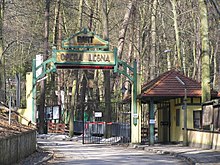
|
| Szczecin | Opera na Zamku | The Opera na Zamku is an opera house in Szczecin. It has been in operation since 1956. | Website |

|
| Warsaw | Teatr Wielki | The Teatr Wielki (German Great Theater ) is the largest theater in Warsaw. It houses the National Opera (Opera Narodowa) and the National Theater (Teatr Narodowy) of Poland.
The Teatr Wielki was built in the years 1825–1833 according to plans by the Italian architect Antonio Corazzi . The house was inaugurated on February 24, 1833 with a performance of Rossini's Il barbiere di Siviglia . |
Website |

|
| Warsaw | Warszawska Opera Kameralna | The Warszawska Opera Kameralna (German: Warschauer Kammeroper) or WOK for short is a Polish opera company that was founded in 1961 by Stefan Sutkowski, who was also the managing director and artistic director until 2012.
The repertoire of the Warsaw Chamber Opera encompasses a multitude of different musical styles and forms: from medieval crime plays to operas from the early and late baroque periods, to classical pantomime of the 18th century, operas by Rossini to Donizetti, to works by contemporary composers. The Warsaw Chamber Opera is known for its Mozart Festival, which has been held every year since 1991. It also organizes a festival for Gioacchino Rossini and Claudio Monteverdi and the Festival of Old Polish Opera. |
Website |
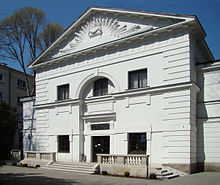
|
Portugal
| place | Opera house | Details | Official website | image |
|---|---|---|---|---|
| Lisbon | Ópera do Tejo | The Opera on the Tejo , in Portuguese Ópera do Tejo or Real Casa da Ópera ( Royal Opera House ), was the opera built under Joseph I in the historic city center of Lisbon on Paço da Ribeira on the banks of the Tagus / Tejo, which was affected by the severe earthquake on 1 November 1755 was destroyed. It was opened on March 31, 1755 of the same year. The building was designed by the Italian architect Giovanni Carlo Galli-Bibiena (1717–1760). |

|
|
| Lisbon | Teatro Nacional de Sao Carlos | The Teatro Nacional de São Carlos (also Oper de São Carlos ) is Lisbon's opera house. It is located in the southern part of the Portuguese capital, more precisely in the old town district of Chiado in Rua Serpa Pinto No. 9.
The building was completed on July 30, 1793. The architect was José da Costa e Silva . |
Website |
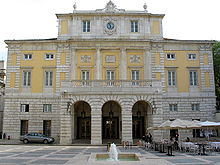
|
| Ponte de Lima | Teatro Diogo Bernardes | The Teatro Diogo Bernardes is a theater in Ponte de Lima. | Website |
|
| postage | Casa da Música | The Casa da Música (German: House of Music) is the municipal concert hall in the northern Portuguese city of Porto, designed by the architects Rem Koolhaas and Ellen Van Loon from OMA (Rotterdam). It was inaugurated in April 2005 and houses the cultural institution of the same name with its three orchestras “Orquestra Sinfonica do Porto”, “Orquestra Barroca” and “Remix Ensemble”. | Website |
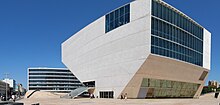
|
Romania
| place | Opera house | Details | Official website | image |
|---|---|---|---|---|
| Brașov | Opera Brasov | The Opera Brașov was founded in 1953 as a music theater in Brașov. | Website |

|
| Bucharest | Opera Națională Bucureşti | The Opera Națională Bucureşti is an opera house in Bucharest. It is the largest of the four Romanian state operas. It was founded in 1919 and has been housed in a new building since 1953. Today it is a repertoire company for opera and ballet, whose current repertoire consists of over 150 opera and ballet performances. | Website |

|
| Bucharest | Teatrul Național de Operetă "Ion Dacian" | The Teatrul Național de Operetă "Ion Dacian" Bucureşti is a public cultural institution financed by the Ministry of Culture and Religious Affairs.
It is located in the center of the capital, next to the Ion Luca National Theater. |
Website |
|
| Cluj-Napoca | Opera Naţională Română | The Opera Naţională Română in Cluj-Napoca is one of the national opera and ballet companies in Romania. | Website |

|
| Constanța | National Opera and Ballet Theater Oleg Danovski | The National Opera and Ballet Theater Oleg Danovski is an opera house in Constanța. | Website |
|
| Craiova | Opera Română Craiova | The Opera Română Craiova is an opera house in Craiova. | Website |
|
| Galați | Teatrul Muzical Nae Leonard | The Teatrul Muzical Nae Leonard is a theater house in Galați. | Website |
|
| Iași | Opera Națională Română Iași | The Opera Națională Română Iași is an opera house in Iași. It was founded on January 1, 1956. Since July 8, 2003 it has received the status of a national institution and has become the Romanian National Opera in Iasi. It is subordinate to the Ministry of Culture and Religion and is located in the building of the National Theater, which was built in 1896 according to a design by the Austrian architects Fellner and Helmer. The hall has 740 seats. | Website |

|
| Timișoara | Opera Națională Română din Timișoara | The Opera Națională Română din Timișoara is an opera company. It is one of the national opera companies in Romania. She shares the building with the Mihai Eminescu National Theater in Timișoara. The premiere in the opera house took place on April 27, 1875. Was given Aida by Giuseppe Verdi . | Website |

|
Russia
Only opera houses in the European part of Russia are listed. For opera houses in the Asian part of Russia see: List of Opera Houses / Asia .
| place | Opera house | Details | Official website | image |
|---|---|---|---|---|
| Astrakhan | Astrakhan State Theater of Opera and Ballet | The Astrakhan State Opera and Ballet Theater is an opera house in Astrakhan. | Website |
|
| Izhevsk | Izhevsk State Opera and Ballet Theater | The Izhevsk State Opera and Ballet Theater is an opera house in Izhevsk. | Website |
|
| Yoshkar-Ola | Yoshkar-Ola State Opera and Ballet Theater | The Yoshkar-Ola State Theater for Opera and Ballet is an opera house in Yoshkar-Ola. | Website |
|
| Kazan | Tatarstan State Opera | The Tatarstan State Opera is an opera house in Kazan. | Website |
|
| Magnitogorsk | Magnitogorsk Opera and Ballet Theater | The Magnitogorsk Opera and Ballet Theater is an opera house in Magnitogorsk. | Website |
|
| Moscow | Bolshoi Theater | The Bolshoi Theater (Russian: Большой театр "Great Theater") in Moscow is the most famous and important theater for opera and ballet in Russia. It forms a pair with the Maly Theater ("Small Theater") in the immediate vicinity . | Website |
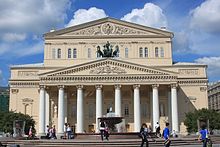
|
| Moscow | Galina Vishnevskaya Opera Center | The Galina Vishnevskaya Opera Center is an opera house in Moscow. | Website |
|
| Moscow | Helikon Opera | The Helikon-Opera (Russian Геликон-Опера, Gelikon-Opera ) is an opera company operating in Moscow, Russian Federation , which has existed since April 1990. It was founded by Dmitri Bertman and has so far focused on unconventional productions. | Website |
|
| Moscow | Moscow Chamber Opera | The Moscow Chamber Opera ( Russian : Московский государственный академический Камерный музыкальный театр имени Б. А. Поговский) is a theater and opera house in Moscow. The theater was founded in 1971 and bears the name of its founder Boris Alexandrovich Pokrovsky. The theater troupe based in the theater is also known as the Pokrovsky opera . | Website |

|
| Moscow | Moscow State Musical Theater of Children's Music Natalya Sats | The Moscow State Music Theater for Children Music Natalya Sats is a theater building in Moscow, which has specialized in opera, ballet and theater performances for children. The world's first professional theater for children is internationally known as the birthplace of the musical fairy tale Peter and the Wolf by Sergei Prokofiev . | Website |
|
| Moscow | Stanislavsky and Nemirovich Danchenko musical theater | The Stanislavsky and Nemirovich Danchenko Music Theater is an opera house in Moscow. The house was founded by the directors Konstantin Stanislavski and Vladimir Nemirowitsch-Danchenko . It has existed in its current form since 1941, after two opera ensembles were merged. The theater was considered a laboratory for creating new opera and ballet performances. After Stanislavski's death (1938), Vladimir Nemirowitsch-Danchenko took over the management of the theater, which soon received its current name.
In October – December 1941 this house was the only theater in Moscow that did not cease work, although some of the productions had to be canceled due to air alarms. |
Website |
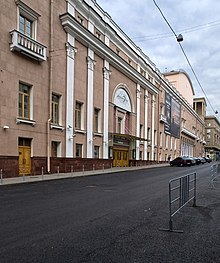
|
| Moscow | New Opera (Moscow) | The New Opera ( Russian Новая Опера) in Moscow is an opera house with a permanent ensemble. The New Opera was founded in 1991 by Russian conductor Yevgeny Kolobov with the support of Moscow Mayor Yuri Luzhkov . Until his death in 2003, Kolobow was chief conductor and artistic director of the New Opera, one of the most popular operas in Moscow.
The Neue Oper has its own orchestra and a permanent opera choir. In contrast to the other major opera houses in Russia, which at the time permanently hired their soloists , Kolobov introduced a system of temporary engagement right from the start , which enabled him to hire promising talents and experiments. The New Opera building was erected in 1997 in the Hermitage Park and offers more than 700 seats. |
Website |

|
| Nizhny Novgorod | Nizhny Novgorod State Academic Opera and Ballet Theater | The Nizhny Novgorod State Academic Opera and Ballet Theater is an opera house in Nizhny Novgorod. | Website |
|
| Perm | Perm State Opera and Ballet Theater | The Perm State Opera and Ballet Theater or Pyotr Ilyich Tchaikovsky Perm State Opera and Ballet Theater is an opera house in the city of Perm, Russia. It is one of the oldest theaters in the country and has remained a major musical center throughout its history, where many major art events have taken place. His ballet troupe is one of the most popular in Russia. | Website |

|
| Petrozavodsk | Music theater of the Republic of Karelia | The Music Theater of the Republic of Karelia is a theater house in Petrozavodsk, the capital of the Republic of Karelia in Russia. | Website |
|
| Rostov | Rostov State Music Theater | The Rostov State Music Theater is a theater in Rostov in the Yaroslavl Oblast in Russia. | Website |

|
| Samara | Samara Academic Opera and Ballet Theater | The Samara Academic Opera and Ballet Theater is an opera house in Samara, the capital of Samara Oblast . | Website |
|
| St. Petersburg | Mariinsky Theater | The Mariinsky Theater (Russian: Мариинский театр) is one of the most famous opera and ballet houses in the world. The building is located on St. Petersburg's Theater Square; many important Russian operas and ballets were premiered here. It is the home of the Kirov Ballet , which is still popular when it appears abroad . The ballet now bears the official name of the Ballet Company of the Mariinsky Theater . | Website |

|
| St. Petersburg | Mikhailovsky Theater | The State Academic Opera and Ballet Theater St. Petersburg MP Mussorgsky - Mikhailovsky Theater (Russian: Михайловский театр) in Saint Petersburg, in the 19th century also "Théâtre Michel", in the 20th century " Maly Theater " ("Small Opera House") ), is next to the Mariinsky Theater the most important opera house in the city. Built in 1833, in the 19th century it was mainly used by French drama and opera ensembles, was an important experimental site for Soviet music theater in the 1920s and has had its own ballet company since 1933. | Website |

|
| St. Petersburg | St. Petersburg Chamber Opera | The St. Petersburg Chamber Opera is an opera house in Saint Petersburg. | Website |
|
| Saratov | Saratov Opera and Ballet Theater | The Saratov Opera and Ballet Theater is a theater in Saratov in Saratov Oblast in Russia. | Website |
|
| Cheboksary | Chuvash State Theater for Opera and Ballet | The Chuvash State Theater of Opera and Ballet ( tschuwaschich : Чăваш патшалăх оперăпа балет театрĕ; Russian: Чувашский государственный театр оперы и балета ) is an opera house in Cheboksary , the capital of the Russian Federation Republic of Chuvashia on the Volga Federal District . Originally known as the Chuvash Music Theater , it was given its current name in 1993. | Website |
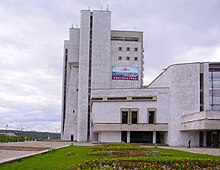
|
| Chelyabinsk | State Academic Theater of Opera and Ballet Chelyabinsk | The Chelyabinsk State Academic Opera and Ballet Theater is an opera house in Chelyabinsk, a city in Chelyabinsk Oblast in Russia. | Website |

|
| Ufa | Bashkir State Opera and Ballet Theater | The Bashkir State Opera and Ballet Theater is an opera house in Ufa, the capital of the Republic of Bashkortostan in Russia. | Website |
|
| Volgograd | Tsaritsynskaya Opera | The Tsaritsynskaya Opera is an opera house in Volgograd. | Website |
|
| Voronezh | Voronezh State Opera and Ballet Theater | The Voronezh State Opera and Ballet Theater is an opera house in Voronezh, the capital of Voronezh Oblast in Russia. | Website |
|
Sweden
| place | Opera house | Details | Official website | image |
|---|---|---|---|---|
| Drottningholm | Drottningholm Palace Theater | The Drottningholm Palace Theater ( Swedish : Drottningholms Slottsteater ) is a theater in Drottningholm Palace near Stockholm in Sweden .
In summer, the Drottningholm Palace Theater Festival primarily stages operas from the 18th century (by Handel , Gluck , Haydn and Mozart ) with a focus on historically informed performance practice. In addition to the Baroque style 1664–1703 by the architect Nicodemus Tessin the Elder. Ä. (and his son of the same name ), the theater building was built by Carl Fredrik Adelcrantz and inaugurated in 1766. Today it holds about 400 visitors. The stage machinery of the Italian Donato Stopani (with wave machine and wind machine ) is used unchanged to this day. |
Website |
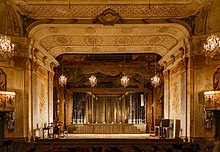
|
| Gothenburg | Gothenburgsoperan | The Gothenburg Opera (Swedish: Göteborgsoperan ) is an opera house in Gothenburg. The building is located near the city center, in Lilla Bommen , on the banks of the Göta älv river . It was designed by Jan Izikovitz and has an area of 28,700 square meters with a height of 32 meters. The opera has two concert halls. Its main auditorium measures 500 square meters and seats 1,300. The building was awarded the 1994 piece Aniara of Harry Martinson inaugurated. In addition to operas, ballets, musicals and shows are performed. | Website |

|
| Karlstad | Wermland Opera | The Wermland Opera , formerly Värmlandsoperan , has been the name of the former music theater in Värmland, which was founded in 1975, since 2003. | Website |

|
| Lidköping | Läckö Slottsopera | The Läckö Slottsopera is an opera company that has performed an opera every summer since 1997. In the courtyard of the baroque Läckö Castle, 25 km from the Swedish city of Lidköping, performances usually take place for three weeks from mid-July. | Website |

|
| Malmo | Malmö Live | The Malmö Live is an event center opened in August 2015 in Malmö with a concert hall, conference facilities, a hotel, offices and apartments. The Malmö Live concert hall is home to the Malmö Symphony Orchestra . | Website |

|
| Malmo | Malmö Music Theater | The Malmö Music Theater (Swedish: Malmö opera och musikteater ) is a music and opera house in Malmö and is one of the largest opera houses in Scandinavia. The building is located in central Malmö at Östra Rönneholmsvägen 20 . | Website |
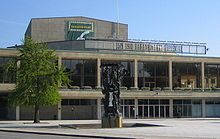
|
| Malmo | Opera factories | The Opera factories is an independent opera company and a non-profit association based in Malmo. The company was founded in 2010 by Leena Malkki, a freelance opera singer (soprano) and producer. The debut opera in 2011 was Don Giovanni by Wolfgang Amadeus Mozart . | Website |
|
| Södertälje | Södertäljeoperan | The Södertäljeoperan is an opera company in Södertälje. | Website |
|
| Solna | Ulriksdals Slottsteater | The Ulriksdals Slottsteater or Confidencen is a theater in the park of Ulriksdal Castle in Solna, just outside the Swedish capital Stockholm. It was built in the 1750s and restored in the late 20th century. It is the oldest Rococo theater in Sweden. | Website |

|
| Stockholm | Folkoperan | The Folkoperan is an opera house in Stockholm, which was founded in 1976 as a counterpart to the Royal Opera there in order to make the opera accessible to a wider public.
The opera house has been located at Hornsgatan number 72 in a former cinema since 1984. |
Website |

|
| Stockholm | Kungliga Operan | The Kungliga Operan (German: Royal Opera ) is the Swedish state opera. In order to distinguish them from other royal opera houses, it is often in German-speaking Royal Swedish national opera called, in English usage (in international treaties artists of the Opera) Royal Swedish Opera .
It is located in the central district of Norrmalm of the capital Stockholm in a historical architectural ensemble on Gustav Adolfs Torg ( Gustav-Adolf-Platz ), directly opposite the Erbfürstenpalais ( Arvfurstens palats , today's Foreign Ministry ) on the north bank of the Norrström . |
Website |

|
| Umeå | NorrlandsOperan | The NorrlandsOperan or NOP is a Swedish opera company based in Umeå, in Norrland, Sweden. NOP ownership is split between Umeå Municipality (40%) and Västerbotten County Council (60%).
NOP was founded in 1974 as a regional opera company. The first artistic director of the NOP was Arnold Östman from 1974 to 1979. NOP now has its own symphony orchestra and facilities for opera, dance, music and art as well as workshops and studios. |
Website |
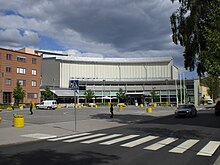
|
| Vaxjo | SmålandsOperan | The SmålandsOperan is an opera company in Vaxjo . | Website |
|
Switzerland
| place | Opera house | Details | Official website | image |
|---|---|---|---|---|
| Basel | Theater Basel | The Theater Basel is the municipal theater of the Swiss city of Basel. It is a three-part house. From September to June, around 600 performances of over 40 new productions per season are staged on the three stages of the theater (large stage, small stage and theater). Around 400 people are employed in front of, on and behind the stages. The Basel Theater offers opera, drama and ballet. | Website |

|
| Bern | City Theater Bern | The Stadttheater Bern at Kornhausplatz 20 in Bern houses a three-part stage for opera, drama and ballet.
Today's house has existed since 1903. At the opening, Tannhäuser was performed by Richard Wagner , introduced by a ceremony by Joseph Victor Widmann , in which Mrs. Berna appeared as an allegorical figure alongside Apollo and the Muses . Since 2012, the Bern City Theater has been part of the new institution «Konzert Theater Bern», which includes the Bern Symphony Orchestra as well as the City Theater. In this form, it is a unique organizational model and four-branch house for Switzerland. |
Website |

|
| Biel / Solothurn | Theater Orchestra Biel Solothurn | The Theater Orchester Biel Solothurn is a federal theater of the cities of Biel / Bienne and Solothurn. The two city theaters were merged to form the federal city theater in 1927. The Biel Solothurn Theater Orchestra today consists of the musical theater, concert, drama and dance branches. There are also various offers in the field of children's and youth theater. | Website |

|
| Friborg | Équilibre (Friborg) | The Equilibre is a theater in Friborg in which one or two productions are performed per season. It is located in the heart of the city of Friborg in Switzerland. The capacity of the room is 681 seats | Website |

|
| Friborg | Nouvel Opéra Friborg | The Nouvel Opéra Friborg or NOF in Friborg emerged from the merger of the Opéra de Friborg and the opera company Opera Louise and offers opera and music theater creations. | Website |
|
| Friborg | Opéra de Friborg | The Opéra de Friborg , founded in May 1986, is an association dedicated to theater production. Its legal purpose is to promote opera and fine arts in Friborg and the canton of the same name. Since January 2012 the Opéra de Friborg has been located in the Équilibre Theater in Friborg. | Website |
|
| Geneva | Grand Théâtre de Genève | The Grand Théâtre de Genève is an opera house in Geneva.
The Grand Théâtre (often referred to as Opéra de Genève or Geneva Opera ) is run and subsidized by the City of Geneva through a foundation. It has its own ballet troupe and its own choir. The music has been played by the Orchester de la Suisse Romande since 1962 . Eight operas (mostly in-house productions), two to three ballets, and a few other pieces of music are usually performed each season. |
Website |

|
| Geneva | Opera de Chambre de Genève | The Opéra de Chambre de Genève is an opera house in Geneva. | Website |
|
| Lausanne | Lausanne Opera House | The Opéra de Lausanne is a municipal opera house in Lausanne in the Swiss canton of Vaud . In addition to opera performances, the Opéra de Lausanne also presents ballet evenings and philharmonic concerts. The Casino-Théâtre de Lausanne (also Théâtre de Georgette ), built from 1869 to 1871 according to plans by Jules Verrey for the Société du Casino-Théâtre , opened on May 10, 1871. | Website |

|
| Lucerne | Lucerne Theater | The Lucerne Theater (also colloquially known as the Lucerne City Theater ) is the only professional theater in Central Switzerland . It is a typical "three-branch house" with a music theater ensemble, a drama ensemble and the "Tanz Luzerner Theater". In addition, a puppet theater is attached to the Lucerne theater - but without its own ensemble. The Lucerne Symphony Orchestra (LSO) is an important artistic partner for music theater. | Website |

|
| St. Gallen | Theater St. Gallen | The St. Gallen Theater (formerly Stadttheater St. Gallen ) is a three-part theater with opera, operetta, musical, drama, children's theater and dance in St. Gallen. It is considered to be the oldest professional theater in Switzerland. | Website |
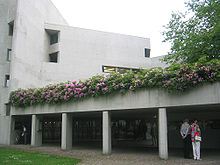
|
| Zurich | Zurich Opera House | The Zurich Opera House is located in the center of the city of Zurich at Sechseläutenplatz . Until 1964 the building was called the City Theater , since then the Opera House; it was opened on October 1, 1891 and can accommodate 1,100 people.
According to plans by the Viennese architects Fellner & Helmer , which is experienced in theater construction, today's building, which was originally planned for Krakow and was already ready for construction, was erected in a short time. It is largely identical to the Croatian National Theater in Zagreb (1894) and the Court Theater in Wiesbaden, built in 1892/1894, today the Hessian State Theater in Wiesbaden . It was inaugurated on September 30, 1891 and opened the following day with a performance of Wagner's Lohengrin . In the early days it served as a music and spoken theater, but after the construction of the theater in 1926 it concentrated on opera, operetta and ballet. |
Website |

|
Serbia
| place | Opera house | Details | Official website | image |
|---|---|---|---|---|
| Belgrade | Madlenianum | The Madlenianum is the first privately owned opera and theater company in Serbia and Southeastern Europe. It is located in Belgrade and was founded on January 26th 1999 by Madlena Zepter, wife of the Serbian businessman Philip Zepter. | Website |
|
| Belgrade | National Theater Belgrade | The National Theater in Belgrade ( Serbian : Народно позориште у Београду / Narodno Pozorište u Beogradu ) was founded in the second half of the 19th century and is located on Republic Square in Belgrade. With the construction of this object and the implementation of Јosimović's regulatory plan from 1867 for the city in the moat, the conditions for the formation of today's most important Belgrade Square, the Trg republike, were created. Today three art ensembles work under its roof - opera, drama and ballet. | Website |

|
| Novi Sad | Serbian National Theater | The Serbian National Theater (Serbian: Српско народно позориште or Srpsko narodno pozorište ) is a theater in Novi Sad. It was founded in 1861. The current building of the theater opened in March 1981. | Website |

|
Slovakia
| place | Opera house | Details | Official website | image |
|---|---|---|---|---|
| Banská Bystrica | Štátna opera v Banskej Bystrici | The State Opera in Banská Bystrica (Slovak: Štátna opera v Banskej Bystrici) is one of the most important Slovak theater companies. She stages operas, operettas, musicals, ballet and concerts at home and abroad. The beginning of the ensemble goes back to 1959. | Website |

|
| Bratislava | Slovak National Theater | The Slovak National Theater ( Slovenské národné divadlo in Slovak ) in Bratislava (German Pressburg, Hungarian Pozsony) is the oldest theater in Slovakia . It was founded in 1920 after the independence of what was then Czechoslovakia . Its predecessor was the Municipal Theater of Pressburg. | Website |

|
| Košice | Košice State Theater | The State Theater Košice (Slovak: Štátne divadlo Košice ) is located in the center of Košice in Slovakia. The representative building of the State Theater was built in the years 1879–1899 according to plans by Adolf Lang in the neo-baroque style. | Website |

|
Slovenia
| place | Opera house | Details | Official website | image |
|---|---|---|---|---|
| Ljubljana | Ljubljana Opera House | The Ljubljana Opera House ( Slovenian : Ljubljanska opera ) is part of the Slovenian National Theater for Opera and Ballet , the national opera and ballet company of Slovenia .
The ensemble plays in the house of the Slovenian National Opera. In the theater, built in 1892, performances were performed in both Slovene and German until 1918. Since 1918 the opera has been expanded to include its own orchestra and ballet. |
Website |

|
| Maribor | Slovenian National Theater Maribor | The Slovenian National Theater Maribor (Slovenian: Slovensko narodno gledališče Maribor or SNG Maribor ) is a theater in Maribor, in north-eastern Slovenia, which offers drama, opera and ballet performances. | Website |
|
Spain
| place | Opera house | Details | Official website | image |
|---|---|---|---|---|
| A Coruña | Palacio de la Ópera (La Coruña) | The Palacio de la Ópera in A Coruña is an opera house in the Glorieta de América. It can accommodate 1729 people. | Website |

|
| Barcelona | Gran Teatre del Liceu | The Gran Teatre del Liceu is the largest opera house in the Catalan capital of Barcelona and is located on the Rambles in the center of the city.
The opera and concert hall was opened on April 4, 1847 and reopened in 1999 after a fire on January 31, 1994. |
Website |
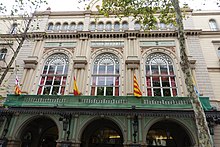
|
| Barcelona | Teatre Principal (Barcelona) | The Teatre Principal (in Catalan or in Spanish Teatro Principal ), is built the oldest theater in Barcelona, founded in 1579 from 1597 to 1603 and was rebuilt several times, mainly in 1788 and again in 1848. The theater was originally called Teatro de la Santa Cruz on Spanish (or Teatre de la Santa Creu in Catalan). It is on the famous La Rambla avenue. It was the site of the Spanish premieres of many plays and operas (there has been a regular opera season since 1750) and the premieres of Spanish works, including operas by Fernando Sor , Vicenç Cuyàs and Ramon Carnicer . | Website |
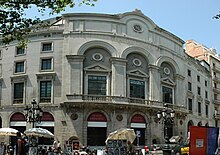
|
| Bilbao | Asociación Bilbaína de Amigos de la Ópera (ABAO) | The Asociación Bilbaína de Amigos de la Ópera (ABAO) is an opera association in Bilbao. | Website |
|
| Bilbao | Palacio Euskalduna | The Palacio Euskalduna (Spanish, Basque Euskalduna Jauregia ) is a multipurpose building for congress and music events in Bilbao in the Spanish Basque Country . The building is located directly on the Ría de Bilbao , where the former Euskalduna shipyard was located.
The Congress Palace was inaugurated in February 1999 and today, along with the Guggenheim Museum , is one of the city's major architectural sights. The building has a usable area of 53,000 m². It houses a main hall with 2,200 seats and a stage area of 1,700 m² and several smaller halls for performances and conferences, as well as a restaurant and a cafeteria. The Palacio Euskalduna is the venue for the opera performances produced by the Asociación Bilbaina de Amigos de la Ópera (ABAO) . |
Website |

|
| Bilbao | Arriaga Theater | The Teatro Arriaga (Spanish, Basque Arriaga antzokia) is an opera house in Bilbao. It was built in 1890 in neo-baroque style by the architect Joaquín Rucoba, who was also the architect of the town hall. It is named after Juan Crisóstomo de Arriaga , who was known as the "Spanish Mozart" in his day. | Website |
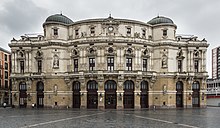
|
| Jerez de la Frontera | Teatro Villamarta | The Teatro Villamarta in Jerez de la Frontera is a theater house designed by Teodoro Anasagasti in the Andalusian regional style and built in 1926. | Website |

|
| Las Palmas de Gran Canaria | Teatro Pérez Galdós | The Teatro Pérez Galdós is the most important theater in the city of Las Palmas de Gran Canaria, seat of the city's opera festival and, together with the Teatro Guimerá of Santa Cruz de Tenerife , the music festival of the Canary Islands.
The theater is located in the southwest of the Triana district , near the sea. After the general renovation in 2007 it is one of the most modern theaters in Spain. |
Website |

|
| Madrid | Teatro de la Zarzuela | The Teatro de la Zarzuela is a musical theater in the Spanish capital, Madrid. It is mainly used to perform the classic Zarzuela , a typically Spanish genre of musical theater that is similar to the operetta . | Website |

|
| Madrid | Teatros del Canal | The Teatros del Canal is a performing arts center that opened in 2009 and is located in the Chamberí district of Madrid. | Website |

|
| Madrid | Teatro Real | The Teatro Real (German: Royal Theater) is an opera house in Madrid.
The story goes back to 1818. The new building near the Palacio Real was opened on November 19, 1850 in the presence of Queen Isabella II on the site of the former De los Caños del Peral opera house . In the decades that followed, the house was one of the most important opera theaters in Europe, but had to be closed in 1925 due to dilapidation. After decades of slumber, the Teatro Real was reopened in 1966, but initially as a pure concert hall without stage technology. |
Website |
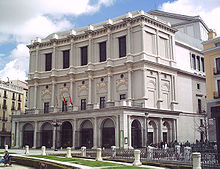
|
| Málaga | Teatro Cervantes de Málaga | The Teatro Cervantes de Málaga is one of the oldest theater buildings in Málaga , the capital of the province of Málaga . It dates from 1870 and has one thousand two hundred seats. It is the main venue for the Festival de Málaga. | Website |

|
| Maó | Teatre Principal de Maó | The Teatre Principal de Maó (Catalan, Spanish: Teatro Principal de Mahón ) is an opera house in the Spanish city of Mahón, the capital of the island of Menorca. The Principal , as it is known colloquially, is one of the oldest opera houses in Spain. It was built in 1829 according to a design by Giovanni Palagi and opened on December 15, 1829. | Website |
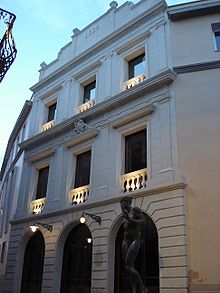
|
| Navarre | Ópera de Cámara de Navarra | The Ópera de Cámara de Navarra is an opera house in Navarre. | Website |
|
| Oviedo | Campoamor Theater | The Teatro Campoamor is the Oviedo Opera House, founded in 1892 and known, among other things, as the place where the Princess of Asturias Prizes are awarded. It was inaugurated on September 17, 1892 with a performance of the Huguenots by Giacomo Meyerbeer . | Website |
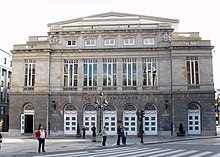
|
| Palma de Mallorca | Teatro Principal (Palma de Mallorca) | The Teatro Principal in Palma de Mallorca (Catalan: Teatre Principal ) is a center for dramatic art in the capital of the Balearic Islands. It was inaugurated in 1857. | Website |

|
| Pamplona | Asociación Gayarre Amigos de la Ópera | The Asociación Gayarre Amigos de la Ópera is an opera society in Pamplona. | Website |
|
| Pamplona | Baluarte Congress Center and Auditorium of Navarre | The Baluarte Congress Center and Auditorium of Navarre , also known simply as the Baluarte , is a building completed in 2003 whose mission is to contribute to the cultural development of Pamplona and Navarre in general .
It is a large center that can host all kinds of cultural and commercial events. With a total area of 63,000 m², including the two underground garages, this is one of the largest areas of its kind in Spain. |
Website |

|
| Sabadell | La Faràndula Theater | The Teatre La Faràndula is a theater building on Calle de la República, 33 by Sabadell, which opened on December 30, 1956 with a capacity of 1060 seats. | Website |

|
| Santa Cruz de Tenerife | Auditorio de Tenerife | The Auditorio de Tenerife (since 2011 officially Auditorio de Tenerife "Adán Martín" , German Auditorium of Tenerife ) is a congress and concert hall in Santa Cruz de Tenerife. The building was designed by the Spanish architect Santiago Calatrava . It is partly regarded as the symbol of the capital of the island of Tenerife . | Website |

|
| San Lorenzo de El Escorial | Teatro Auditorio San Lorenzo de El Escorial | The Teatro Auditorio San Lorenzo de El Escorial is a theater house in San Lorenzo de El Escorial | Website |
|
| San Sebastian | Victoria Eugenia Theater | The Teatro Victoria Eugenia (in Euskera : Victoria Eugenia Antzokia ) is a theater in the city of San Sebastián. The work of the architect Francisco de Urcola was inaugurated in 1912. | Website |

|
| San Sebastian | Palacio de Congresos y Auditorio Kursaal | The Kursaal building complex (Spanish: Palacio de Congresos y Auditorio Kursaal ) in San Sebastián in the Spanish Basque Country is a conference and cultural center. The architectural complex with several large halls and other event rooms was designed by Rafael Moneo . It opened in 1999 and has been the seat of the San Sebastian Film Festival since then . The largest hall, known as the Auditorio , has a capacity of over 1,800 seats; the Sala de Cámara has more than 600 seats. | Website |
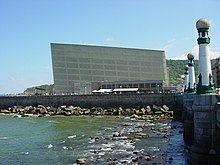
|
| Seville | Teatro de la Maestranza | The Teatro de la Maestranza is an opera house in Seville. The theater was conceived as one of the main cultural venues of the Seville Expo '92. The world premiere took place in 1991, shortly before the opening of the international exhibition. Although the Teatro de la Maestranza is mainly dedicated to opera, there are also performances of zarzuela , flamenco and other musical performances. | Website |

|
| Valencia | Palau de les Arts Reina Sofía | The Palau de les Arts Reina Sofía (German: Queen Sofia Palace of the Arts) is an opera and culture house in Valencia. The structure was opened on October 8, 2005. The first performance took place on October 25 of the same year with the opera Fidelio by Ludwig van Beethoven . The Palau de les Arts Reina Sofía is part of the Ciudad de las Artes y de las Ciencias and was designed by the Spanish architect Santiago Calatrava . | Website |
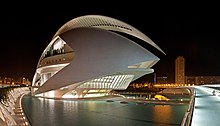
|
| Valladolid | Teatro Calderon de la Barca | The Teatro Calderón de la Barca is a theater in Valladolid. It is named after the playwright Pedro Calderón de la Barca . Jerónimo de la Gándara was the architect of the building. As one of the largest theaters in Spain, the facade has an eclectic neoclassical style. The theater opened in 1864. | Website |

|
| Valladolid | Centro Cultural Miguel Delibes | The Centro Cultural Miguel Delibes is a cultural center in Valladolid. It was designed by the architect Ricardo Bofill Levi and inaugurated in March 2007 with a concert by the Orquesta Sinfónica de Castilla y León under the direction of the Colombian-Spanish conductor Alejandro Posada. The cultural center is named after Miguel Delibes, writer from Valladolid. It is the seat of the Orquesta Sinfónica de Castilla y León , the city's music conservatory, the chamber music hall, the auditorium and the Escuela Superior de Arte Dramático y de la Escuela Profesional de Danza y Teatro Experimental. | Website |

|
Czech Republic
| place | Opera house | Details | Official website | image |
|---|---|---|---|---|
| Brno | Janáček Theater | The Janáček Theater ( Czech : Janáčkovo divadlo ) in Brno is a house mainly dedicated to opera and ballet, named after the composer Leoš Janáček , which opened in 1965.
The building of the theater was the product of a lengthy decision-making process that had lasted since 1881. Between 1913 and 1956 there were seven architectural competitions with a total of around 150 participants. The range of designs ranged from the - initially preferred - historicist variants to projects in the spirit of minimalist modernism, functionalism and organic architecture. Numerous well-known Czech architects were involved, including Jan Kotěra , Bohuslav Fuchs and Jan Víšek . The end product is an opera theater in the functionalist-classical style. It has 1,383 seats and is designed as a representative box theater. The well-known Café Zeman by Bohuslav Fuchs had to give way to the new theater building, but was reconstructed at a nearby location in the mid-1990s. The former German city theater of Brno, previously known as the Janáček Theater, was renamed the Mahen Theater in 1965 . |
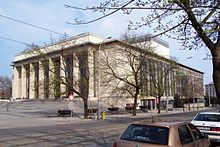
|
|
| Brno | Mahen Theater | The Mahen Theater (Czech: Mahenovo divadlo ) in Brno is a historicist-style theater building designed by the architects Fellner and Helmer .
The house, which was initially built as the German City Theater , was built in the wake of the deconsolidation of Brno carried out in 1861–1863 and the establishment of a ring road (based on the Viennese model) on the fruit market (today: Malinovsky Square ). Until 1918 and during the Protectorate it had the function of playing in German for the German-speaking population, while the theater on Eichhorngasse served as the Czech National Theater at that time . Subsequently, this representative house took over the function of the Czech National Theater and was initially called Theater on the Schanzen (1918–1945), then Janáček Opera (1945–1946), Janáček Theater (1946–1965) and today (since 1965) to Jiří Mahen . |
??? |
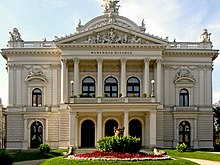
|
| Brno | Národní divadlo Brno | The Národní divadlo Brno (German: National Theater Brno ) is an institution that offers musical theater and drama in several houses in Brno.
The following houses have been and will be played:
|
Website | |
| Brno | Theater on Veveří Street | The Theater on Veveří Street (Czech: Divadlo na Veveří - Národní divadlo Brno ) was the Brno Czech National Theater before this function was transferred to the Mahen Theater and other houses such as the Janáček Theater (Janáčkovo divadlo). |

|
|
| Brno | Reduta Theater | The Reduta Theater on the Krautmarkt in Brno is one of the oldest theater venues in Europe that is still in use today.
In 1605 the new urban tavern in Renaissance style was built here. Regular performances were given from the 1660s onwards. In the 1730s, the Reduta was rebuilt and expanded for theatrical performances and dance events. Mainly German and Italian pieces were played. In 1767, eleven-year-old Wolfgang Amadeus Mozart gave a concert here with his sister Nanerl . |
Website |

|
| Ceske Budejovice | South Bohemian Theater | The South Bohemian Theater (Czech: Jihočeské divadlo ) is a theater in Budweis. It offers productions in the fields of drama, opera, ballet and puppet theater. | Website |
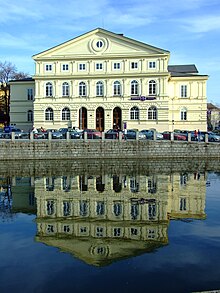
|
| Liberec | FX Šalda Theater | The FXŠalda Theater (Czech: Divadlo Františka Xavera Šaldy or Divadlo FXŠaldy ) is a theater in Liberec in the Czech Republic. Plays, operas and ballets are performed at the theater. The theater consists of the main building and the small theater . | Website |
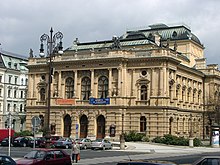
|
| Olomouc | Moravian Theater Olomouc | The Moravian Theater Olomouc (Czech: Moravské divadlo Olomouc ) is a theater on the Upper Square in Olomouc. It has existed since 1920. | Website |
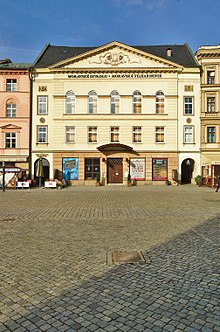
|
| Opava | Silesian Theater | The Silesian Theater (Czech: Slezské divadlo ) is a theater building in Opava. The theater consists of two ensembles - drama and opera, but also offers ballet and concert performances. | Website |

|
| Ostrava | Antonín Dvořák Theater | The Antonín Dvořák Theater (Czech: Divadlo Antonína Dvořáka ) in Ostrava is an opera house in the Czech Republic that opened on September 28, 1907. It is part of the Moravian-Silesian National Theater, founded in 1918. | Website |

|
| Pilsen | Divadlo Josefa Kajetána Tyla | The Josef Kajetán Tyl Theater (Czech: Divadlo Josefa Kajetána Tyla ) is the main theater in Pilsen. The theater was built between 1899 and 1902 in neo-renaissance style with some Art Nouveau elements based on a design by Antonin Balsanek . The theater stages around 18 world premieres of dramas, operas, operettas, ballets and musicals every year. | Website |

|
| Prague | Národní divadlo | The Národní divadlo (German: National Theater ) is the most important theater and opera house in the Czech capital, Prague. The building in the New Town , located on the Vltava and opened in 1881, was built with the help of donations from the Bohemian countries in the neo-renaissance style and is considered a national symbol. | Website |
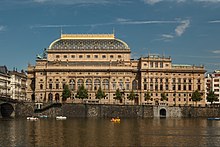
|
| Prague | Estates theater | The Estates Theater (Czech: Stavovské divadlo ) is a theater in Prague. It is located at Ovocný trh (Fruit Market) in Prague's Old Town . Originally the theater was named Gräflich Nostitzsches National Theater in honor of its builder (Czech: Národní divadlo hraběte Nostice , Nosticovo divadlo for short ).
The theater went down in musical history with the world premiere of two operas by Wolfgang Amadeus Mozart ( Don Giovanni , 1787 and La clemenza di Tito , 1791). |
Website |
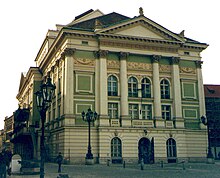
|
| Prague | Prague State Opera | The Prague State Opera (Czech: Státní opera Praha ) is an opera house in the Czech capital, Prague. The stage was founded as the Neues Deutsches Theater (1888-1938) and was subsequently called Divadlo 5. května (Theater of May 5, 1945-1948) and Smetanovo divadlo (Smetana Theater, 1949-1992). | Website |

|
| Ústí nad Labem | North Bohemian Opera and Ballet Theater | The North Bohemian Opera and Ballet Theater (Czech: Severočeské divadlo opery a baletu ) is a theater in Ústí nad Labem. Since its inauguration in 1909, it has been housed in a neo-baroque building with Art Nouveau elements on Lidické Square, a cultural monument of the city. The capacity is 800 people. | Website |

|
Turkey
Only opera houses in the European part of Turkey are listed. For opera houses in the Asian part of Turkey see: List of Opera Houses / Asia .
| place | Opera house | Details | Official website | image |
|---|---|---|---|---|
| Istanbul | Ataturk Cultural Center | The Ataturk Cultural Center (Turkish: Ataturk Kültür Merkezi , abbreviation AKM ) is a multi-purpose cultural center and opera house on Taksim Square in Istanbul. It is named after the state founder Mustafa Kemal Ataturk . In the summer, the Ataturk Cultural Center hosts the Istanbul Art and Culture Festival. | Website |

|
Ukraine
| place | Opera house | Details | Official website | image |
|---|---|---|---|---|
| Kharkiv | Kharkov National Academic Theater of Opera and Ballet Mykola Lysenko | The Kharkov National Academic Theater of Opera and Ballet Mykola Lysenko is an opera house in Kharkiv . It is named after the Ukrainian composer, pianist and musicologist Mykola Lysenko . | Website |
|
| Chernivtsi | Chernivtsi Opera House | The Chernivtsi Opera House is an opera house in Chernivtsi , the capital of Chernivtsi Oblast and the traditional capital of Bucovina . |
|
|
| Dnipro | Dnipropetrovsk Academic State Theater of Opera and Ballet | The Dnipropetrovsk State Academic Opera and Ballet Theater is an opera house in Dnipro, the center of the Dnipropetrovsk Oblast and Dnipro Raion . | Website |
|
| Donetsk | Donetsk Opera House | The Donetsk Opera House (also Donetsk Staatlichek Academic Opera and Ballet Theater A. Solovyanenko or Donbass Opera ) opened in Donetsk in 1932. The first season began on September 1, 1932 with the opera Fürst Igor, composed by Alexander Porfirjewitsch Borodin . On December 9, 1999, by resolution of the Cabinet of Ministers of Ukraine, the theater was named after the Ukrainian Soviet opera singer A. Solovyanenko. | Website |

|
| Kiev | October Palace | The former October Palace of Culture ( Ukrainian Жовтневий палац культури) today called International Center of Culture and Art ( Ukrainian Міжнародний центр культури і мистецтв) and is a cultural building near the Maidan Nezalezhnosti in Ukrainian capital Kiev.
The building in the style of late classicism , which among other things houses a theater and a library with over 70,000 volumes of books, was built according to plans by the architect Vincent Beretti between 1838 and 1842. The building also has rooms for, for example, exhibitions, conferences, symposiums and seminars. |
Website |
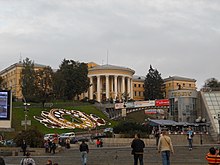
|
| Kiev | Taras Shevchenko Opera House | The Taras Shevchenko Opera House ( Ukrainian Національна опера України імені Тараса Шевченка Nazionalna opera Ukrajiny imeni Tarassa Shevchenka ) is an opera house in Kiev. In 1992 the house received the status of a national opera.
As early as 1867, operas and ballets had been performed regularly in the Kiev City Theater, and the year 1867 is still considered the founding year of Kiev Opera. After the old theater building burned down in 1896, a new city theater was built in the styles of rationalism , baroque and neo-Romanesque from 1898 to 1901 . The facade was richly decorated in the neo-renaissance style. The builder was Viktor Schröter . The house was inaugurated in September 1901 with the opera A Life for the Tsar by Michail Glinka . At the time of the inauguration, the house was considered the Russian theater with the largest and most modern stage. In addition to local pieces, works by foreign authors and composers were always played. |
Website |

|
| Lviv | Lviv National Opera | The Lviv National Opera (also Lviv National Academic Opera and Ballet Theater named after Salome Kruschelnytska ) is one of the main attractions of the western Ukrainian city of Lviv. The current building is the result of an architectural competition held in 1895, which was won by the Polish architect Zygmunt Gorgolewski (1845-1903). The foundation stone was laid on June 5, 1896; the actual construction phase lasted just over three years (according to the inscription in the foyer, 1897 to 1900). The historicist building was based on the models of the architecture of the Renaissance and Baroque, but in concrete terms apparently on that of the Vienna Court Opera . The auditorium holds 1070 visitors and is designed in the traditional form of a box theater. |
Website |

|
| Odessa | Odessa Opera House | The Odessa Opera House ( Ukrainian : Одеський національний академічний театр опери та балету / Odesskyj nazionalnyj akademitschnyj teatr opery ta balety - about "Academic National Theater of Opera and Ballet Odessa") is one of the landmarks of the Ukrainian Black Sea port of Odessa. An international competition was announced for the construction of today's opera house, which was won by the Viennese firm Fellner & Helmer . It was built on from 1883. It was opened in the fall of 1887. The design of the building is based on historicism . In terms of urban planning , the opera house represents the crown of the city of Odessa. In 1926 it received the honorary title of Academic Theater . | Website |
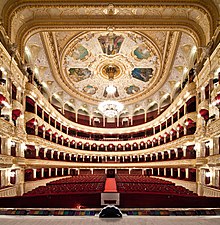
|
Hungary
| place | Opera house | Details | Official website | image |
|---|---|---|---|---|
| Budapest | Erkel Theater | The Erkel Theater ( Hungarian: Erkel Színház ) is a theater building in Budapest. The current name of the theater refers to the Hungarian composer Ferenc Erkel .
The building was built over a period of nine months according to plans by Dezső Jakab, Marcell Komor and Géza Márkus and was equipped with the latest technical achievements, as well as an organ. On December 7, 1911, the house opened as a Volksoper with Quo vadis by Jean Nouguès (1875–1932). |
Website |

|
| Budapest | Király Színház | The Király Színház (King's Theater) was a theater in the Hungarian capital Budapest that existed until 1936. It opened on November 6, 1903 at 71 Király Street and until 1925 it was the most popular and successful operetta theater in Budapest. |

|
|
| Budapest | Moltopera | The Moltopera is a Hungarian independent opera company from Budapest. | Website |
|
| Budapest | Müpa Budapest |
Müpa Budapest (the former Palace of Arts , Hungarian: Művészetek Palotája - MÜPA ) is a cultural institution in Budapest.
The building offers space for three types of art: music, visual arts and theater. The exhibition rooms, the concert hall and the theater hall function independently of each other. |
Website |
|
| Budapest | Budapest Operetta Theater | The Budapest Operetta Theater (Hungarian: Budapesti Operettszínház ) is a music theater institution in the Hungarian capital Budapest , in the Terézváros district | Website |

|
| Budapest | Hungarian State Opera | The building of the Hungarian State Opera (Hungarian: Magyar Állami Operaház ) is one of the most magnificent examples of neo-Renaissance architecture in the Pest district of the Hungarian capital Budapest. It can be found in VI. District (Terézváros) at Andrássy út 22.
The opera house was built between 1875 and 1884 and financed by the city of Budapest and Emperor Franz Joseph I. The Hungarian Royal Opera House , as it was then called, was ceremoniously opened on September 27, 1884. The Budapest Opera is considered to be one of the masterpieces by Miklós Ybl and one of the most beautiful opera houses in the world. The second venue of the Hungarian State Opera is the Erkel Theater . |
Website |

|
| Debrecen | Csokonai Theater | The Csokonai Theater is the oldest and largest theater in Debrecen. Designed by Antal Szkalnitzky in the Moorish style, the theater opened in 1865 with a performance of Joseph Katona's play Bank Bán . | Website |
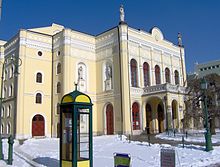
|
| Győr | Győr National Theater | The National Theater Győr (Hungarian: Győri Nemzeti Színház) is a theater in Győr, Hungary. It was opened on November 2, 1978 and is the main theater of the Győr-Moson-Sopron region. Until January 1st, 1992 it was called Kisfaludy Károly Theater . | Website |

|
| Miskolc | Miskolc National Theater | The Miskolc National Theater (Hungarian: Miskolci Nemzeti Színház) is the main theater in Miskolc and the oldest theater company in Hungary. The current neo-classical and neo-baroque building, built between 1847 and 1857, is located in the city center on Széchenyi Street and hosts not only theatrical performances but also events such as the Miskolc International Opera Festival. | Website |

|
| Pécs | National Theater Pécs | The National Theater Pécs (Hungarian: Pécsi Nemzeti Színház) is a theater building in Pécs, Hungary. | Website |
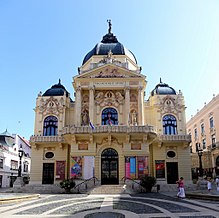
|
| Szeged | National Theater Szeged | The National Theater Szeged (Hungarian: Szegedi Nemzeti Színház) is the main theater in Szeged, Hungary. It was built in 1883 by the famous Fellner and Helmer company in the eclectic and neo-baroque style. | Website |

|
United Kingdom
| place | Opera house | Details | Official website | image |
|---|---|---|---|---|
| Bampton | Bampton Classical Opera | Bampton Classical Opera is a Bampton, Oxfordshire based opera company specializing in the production of lesser-known classical operas. Performances are always sung in English. | Website |

|
| Belfast | Grand Opera House | The Grand Opera House is a theater in Belfast, Northern Ireland. It was designed by Frank Matcham and opened on December 23, 1895. According to the Theater Trust, the building is arguably the best preserved example of the incorporation of oriental elements into theater architecture in the United Kingdom. | Website |

|
| Birmingham | Birmingham Opera Company | The Birmingham Opera Company is a professional opera company based in Birmingham , England , which specializes in innovative and avant-garde productions of the opera repertoire and often plays in unusual locations. | Website |

|
| Cambridge | Cambridge Handel Opera Company | The Cambridge Handel Opera Company is an opera company in Cambridge, England, which specializes in the performance of baroque operas, in particular by George Frideric Handel . | Website |
|
| Cardiff | Welsh National Opera | The Welsh National Opera (WNO) ( Welsh : Opera Cenedlaethol Cymru ) is an opera company founded in Cardiff in 1946. It consists of an orchestra (The Orchestra of Welsh National Opera) and a professional choir (The Chorus of Welsh National Opera).
The company gives 120 performances of eight operas annually and tours the UK. The company has been based at the Wales Millennium Center in Cardiff since 2004 and uses the building for its performances. |
Website |

|
| Cardiff | Wales Millennium Center | The Wales Millennium Center (Welsh: Canolfan Mileniwm Cymru ) is an arts center in Cardiff, Welsh. The site covers a total area of 1.9 hectares. Phase 1 of the building was opened on the weekend of November 26th to 28th, 2004 and phase 2 on January 22nd, 2009 with an opening concert. The center hosts performances of opera, ballet, dance, theatrical comedy and musicals. | Website |
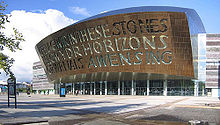
|
| Croydon (Cambridgeshire) | Surrey Opera | The Surrey Opera is a semi-professional English opera company based in Croydon with opera performances in Surrey , Sussex and Kent . The company provides opportunities for aspiring professional opera singers who have the opportunity to work with professional directors, musicians, designers and the Surrey Opera Chorus. | Website |
|
| Edinburgh | Edinburgh Grand Opera | The Edinburgh Grand Opera is Scotland's oldest opera company based in Edinburgh. His soloists are a mix of amateur, semi-professional and professional singers from Scotland and abroad, many of whom are students or graduates of the Royal Conservatoire of Scotland (formerly the Royal Scottish Academy of Music and Drama ). It was the first amateur company to appear at the Edinburgh Festival Theater . | Website |

|
| Farnham | Bury Court Opera | The Bury Court Opera is an opera company based in Farnham, a town in the English county of Surrey . | Website |
|
| Glasgow | Opera on a Shoestring | The Opera on a Shoestring is a small, independent opera company based in Glasgow. | Website |
|
| Glasgow | Theater Royal (Glasgow) | The Theater Royal , originally Royal Colloseum , is a theater in the Scottish city of Glasgow. In 1977 the building was included in the Scottish monument lists in the highest monument category A. The theater was built in 1867 for James Baylis as the Royal Colloseum. The architecture firm Clarke & Bell provided the design . | Website |

|
| Haslemere (Surrey) | Opera South (United Kingdom) | Opera South is the name of a semi-professional British opera company based in Haslemere, Surrey. The company specializing in the production of less well-known operas was founded in 1984 as Opera Omnibus . In the early years of the 21st century, the company was renamed Opera South. In 2005 the Guildford Philharmonic Orchestra joined the company. | Website |
|
| Kirkcaldy | Fife Opera | Fife Opera is a semi-professional opera company from 1975 based in Kirkcaldy, Scotland. It has produced over 40 large-scale productions since its inception. | Website |
|
| Leeds | Grand Theater (Leeds) | The Grand Theater , also known as Leeds Grand Theater and Leeds Grand Theater and Opera House , is a theater and opera house in the center of Leeds in West Yorkshire in England. It was designed by James Robinson Watson, chief assistant in the office of the architect of Leeds, George Corson, and opened on November 18, 1878. The theater is a listed building. It offers space for around 1,500 people.
The theater is home to Opera North and is regularly performed by the Northern Ballet . |
Website |
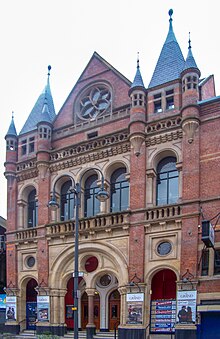
|
| Leeds | Leeds Youth Opera | The Leeds Youth Opera is a renowned opera house for 12 to 25 year olds in Leeds, West Yorkshire, England. | Website |
|
| Leeds | Opera North | The Opera North is an English opera orchestra in Leeds . Its venue is the local Grand Theater. As an opera orchestra, it also covers the cities of Nottingham , Salford , Newcastle upon Tyne and other municipalities in Northern England. | Website |

|
| London | Blackheath Halls | Blackheath Halls is a 600-seat concert venue on Lee Road in the London borough of Blackheath that was completed in 1896. The concert hall is the venue for the Blackheath Halls Opera . | Website |

|
| London | British Youth Opera | The British Youth Opera (BYO) is an opera company based in London. The aim is to give young singers, instrumentalists, conductors, directors and production employees experience through the annual performances in September as well as through a series of workshops and master classes. | Website |
|
| London | Classical Opera | Classical Opera is an opera company based in London. It was founded in 1997 by the conductor Ian Page. The company performs regularly at major UK venues including Wigmore Hall, Barbican, Southbank Center and Birmingham Town Hall. It is also touring in Italy, Germany, Austria and France. | Website |
|
| London | Early Opera Company | The Early Opera Company is a British ensemble based in London that is dedicated to the performance of baroque operas with period instruments. It was founded in 1994 by Christian Curnyn. | Website |
|
| London | English National Opera | The English National Opera (ENO) is one of the two major opera houses in London. In contrast to the Royal Opera House (Covent Garden), the ENO presents all performances in English and is known for lower admission prices.
The ENO goes back to Lilian Baylis (1874-1937), who showed drama, opera and ballet productions at the Old Vic Theater . After acquiring the Sadler's Wells Theater in the Islington district, she established a permanent opera company there in the 1930s, the Sadler's Wells Opera Company . In 1945, the opera was there Peter Grimes by Benjamin Britten premiered. In 1968 Sadler's Wells Opera moved to the largest theater in London's West End, the London Coliseum on St. Martin's Lane near Trafalgar Square . ENO has had its current name since 1974. The subsidiary ENO North in Leeds , founded in 1977, has been operated independently as Opera North since 1981 . |
Website |
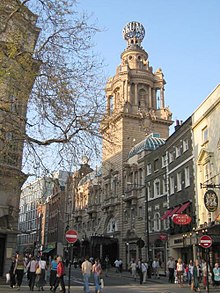
|
| London | English Pocket Opera Company | The English Pocket Opera Company is a London-based opera company founded in 1993. | Website |
|
| London | English Touring Opera | The English Touring Opera (ETO) is an English opera company founded in 1949 by the Arts Council of Great Britain under the name Opera for All . In 1979 the result was Opera 80 , and in 1992 the company was given its current name. | Website |

|
| London | Hampstead Garden Opera | The Hampstead Garden Opera (HGO) is an opera company based in London. It was founded in 1990 by Dr. Roy Budden founded. | Website |
|
| London | Imperial Productions | Imperial Productions ( known as Imperial Opera until 2007 ) is a theater company based in London. It was founded in 1979 by members of the Imperial College Union Opera Association, from which it is completely independent. The company specializes in rare and unusual opera and musical theater pieces. | Website |
|
| London | London Coliseum | The London Coliseum (also Coliseum Theater ) is a theater building in London. It is located on St. Martin's Lane in London's West End . The building, made of Swedish marble , was opened in 1904 by order of the impresario Oswald Stoll according to plans by the architect Frank Matcham , who also designed the London Palladium . Since 1968 it has served as the venue for the English National Opera . The London Coliseum is the largest theater in London's West End with 2558 seats. | Website |

|
| London | London Palladium | The London Palladium is a West End theater on Argyll Street in London.
In the 1880s, what is now the London Palladium was home to Hengler's Circus . The theater of today was built in 1910 and has been known for its wide range ever since. It was not until 1934 that the theater, which was previously only called The Palladium, was named The London Palladium . From 1955 to 1967, the theater achieved great popularity through the broadcast of the weekly television program Sunday Night at The London Palladium , hosted by Tommy Trinder (later Bruce Forsyth). Since the 1980s, the London Palladium has been mainly used for its musical productions, such as Oliver! , The King and I or Singin 'in the rain famous. |
Website |

|
| London | Midsummer Opera | The Midsummer Opera is an opera company based in London. | Website |
|
| London | Old Vic Theater | The Old Vic Theater is a theater on The Cut in London.
The theater was founded in 1818 by William Barrymore as the Royal Coburg Theater , in 1833 it was named the Royal Victorian Theater , in 1880 The Royal Victoria Hall And Coffee Tavern . Even then, it was known by the nickname Old Vic . From 1912 Lilian Baylis showed plays, opera and ballet with her own ensembles at low prices in the Old Vic. From these ensembles, after a move to the Sadler's Wells Theater in the 1930s, the Sadler's Wells Opera Company (now English National Opera ) and the Sadler's Wells Ballet (now the Royal Ballet ) emerged. The acting company, known as the Old Vic Company since 1929 , stayed at the Old Vic and became known for high-class Shakespeare performances under the direction of John Gielgud . The theater building was destroyed in the Second World War , but operations were resumed as early as 1944. In 1963 the company was renamed the Royal National Theater and in 1976 it moved to its own new building directly on the Thames . |
Website |

|
| London | Opera a la carte | Opera a la Carte is a UK-based opera company based in London. It was founded in 1993 by Nicholas Heath, who was a member of the Royal Opera Choir from 1993 to 2006. | Website |
|
| London | Opera Integra | Opera Integra is a British opera company based in London. | Website |
|
| London | Pegasus Opera Company | The Pegasus Opera Company is a British opera company based in London. | Website |
|
| London | Royal Opera House | The Royal Opera House in Covent Garden , London, is Britain's premier opera house. It is home to the Royal Opera, the Royal Ballet, and the Orchestra of the Royal Opera House, sometimes called the Covent Garden Orchestra .
The first theater building at this point, the then Theater Royal (see Patent Theater ) was designed by Edward Shepherd. It opened on December 7, 1732 with a performance of William Congreve's The Way of the World . Although operas, for example by Handel , were performed as early as 1735 , the house remained mainly a theater. It burned down on September 20, 1808. After the building was destroyed, the architect Robert Smirke was commissioned to rebuild it immediately. A year later, on September 18, 1809, the theater reopened with a performance of Macbeth . In the period that followed, opera and ballet were shown in addition to plays. On March 5, 1856, the building was completely destroyed again by a fire. Reconstruction was delayed by difficulties in financing. The reopening took place on May 15, 1858. In 1892 the house officially became the Royal Opera House . |
Website |
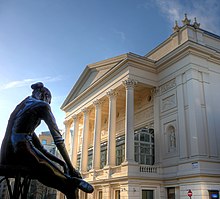
|
| London | Sadler's Wells | Sadler's Wells is a theater complex in Islington , London. After an eventful history, Sadler's Wells Theater became London's leading stage for ballet and modern dance theater in the 20th and 21st centuries . The theater's opera and ballet ensembles gave birth to the Royal Ballet and the English National Opera . | Website |

|
| London | Tête à tête | Tête à Tête is a British opera company based in London. | Website |
|
| London | University College Opera | University College Opera or UCOpera is University College London's student opera . The operas are staged by professional singers, directors and designers, with the orchestra and choir belonging to the student body. Founded in 1951, UCOpera is known for its productions of rarely performed operas, including 3 world premieres and 17 UK premieres. | Website |
|
| London | W11 Opera | W11 Opera is an independent opera company based in London producing operas for young people between the ages of 9 and 18. The name of W11 Opera, founded in 1971, goes back to the postal district W11 in West London (Notting Hill and parts of Holland Park consists), in which the opera company is based. | Website |
|
| Manchester | Manchester Opera House | The Manchester Opera House is a theater and opera house in Manchester in the north west of England.
It belongs together with the Palace Theater's most important cultural institutions in the city and is on the listed building , the monument list of the United Kingdom . The Manchester Opera House opened on Boxing Day 1912, and operas, ballet and musicals have been staged regularly ever since. The building has 1,920 seats and was the location of the European premiere of the musical West Side Story in 1958 . |
Website |
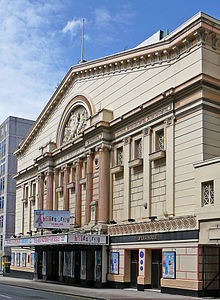
|
| Manchester | Royal Northern College of Music | The Royal Northern College of Music (RNCM) is a conservatory in Manchester , United Kingdom. It is on Oxford Road in downtown Manchester and on the western edge of the Manchester University campus . In addition to higher education, the RNCM offers concerts , operas, and other musical events.
The Conservatory's roots emerged in the late 19th century with Sir Charles Hallé's Royal Manchester College of Music. Today's RNCM was created through the merger of the Royal Manchester College of Music and the Northern School of Music in 1973. |
Website |

|
| Newcastle upon Tyne | Tyne Theater and Opera House | The Tyne Theater and Opera House is a theater in Newcastle upon Tyne, England. It is a Grade I listed building, rated "in the Top 4% Listed Buildings" by English Heritage and rated three stars by the Theaters Trust. It opened in 1867. | Website |

|
| Newtown | Mid Wales Opera | The Mid Wales Opera (MWO) is an opera company based in the Welsh Newtown. | Website |
|
| Oxford | New Chamber Opera | The New Chamber Opera (NCO) is a professional opera company based in Oxford, United Kingdom. It specializes in the areas of chamber opera and music theater and produces rarely performed works from the baroque period to the present day. She is a member of the Opera and Music Theater Forum . | Website |
|
| Oxford | Opera della Luna | Opera della Luna is a British touring theater company founded in 1994. | Website |
|
| Oxford | Opera Lyrica | Opera Lyrica is an opera company based in Oxford, England. It was founded in May 2012 by Paola Cuffolo (Artistic Director) and Nick Simpson (General Director). | Website |
|
| Powys | Adelina Patti Theater | The Adelina Patti Theater is a Grade I listed opera house. It was built as a private auditorium by AdelinaPatti and designed by Swansea architects Bucknall and Jennings. | Website |
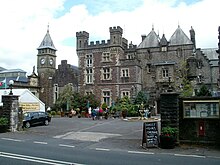
|
| Redhill | Harlequin Theater and Cinema | The Harlequin Theater and Cinema is a theater, cinema and conference center in Redhill, Surrey, England. | Website |
|
| Saint Helier | Jersey Opera House | The Jersey Opera House is a theater and opera house in La Vingtaine de la Ville, Saint Helier on the Channel Island of Jersey. | Website |
|
| Salford | The Lowry | The Lowry is a theater and gallery complex located at Pier 8 on Salford Quays in Salford, England. The complex was officially opened on October 12, 2000 by Queen Elizabeth II . | Website |
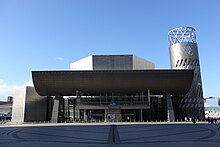
|
| St Andrews | Byre Opera | The Byre Opera is an opera company in the Scottish St Andrews in the county of Fife . The company was founded in 2008 by Michael Downes as St Andrews Opera . The company's singers are mostly from undergraduate and graduate students, but young professionals from across the UK, university staff and singers from the local community have also been involved. | Website |
|
| Sunningwell (Oxfordshire) | Opera Anywhere | The Opera Anywhere is an opera company based in Sunningwell (Oxfordshire). | Website |
|
| Swansea | Swansea City Opera | The Swansea City Opera is an opera company, which was founded in May 2004 in Swansea, Wales. | Website |
|
| Royal Tunbridge Wells | Opera House (Royal Tunbridge Wells) | The Opera House in Royal Tunbridge Wells is a former opera house and now a pub. | Website |

|
| Wakefield | Theater Royal Wakefield | The Theater Royal Wakefield is a theater from 1894 in Wakefield, England. The theater was originally known as the Theater Royal and Opera House and dates from the 1770s. The current theater was designed as the Wakefield Opera House by theater architect Frank Matcham in 1894 and built for £ 13,000. The Theater Royal Wakefield is Frank Matcham's smallest surviving theater building. | Website |
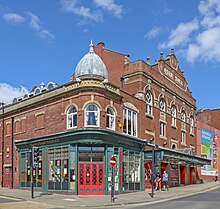
|
| Warwickshire | Armonico Consort | The Armonico Consort is a Warwickshire-based British company founded in 2001 by conductor and organist Christopher Monks that specializes in the production of performances of Renaissance and Baroque music. | Website |
|
| West Horsley Place | Grange Park Opera | The Grange Park Opera is a professional opera company based at West Horsley Place in Surrey, England. Founded in 1998 by Wasfi Kani, OBE and Michael Moody, the company hosts an annual opera festival in an award-winning 550-seat theater in The Grange, Hampshire. | Website |
|
| York | Grand Opera House (York) | The Grand Opera House is a theater in York, England. It operates as part of the Ambassador Theater Group . | Website |
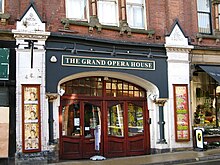
|
Belarus
| place | Opera house | Details | Official website | image |
|---|---|---|---|---|
| Minsk | National Academic Opera and Ballet Theaters of the Republic of Belarus | The National Academic Opera and Ballet Theater of the Republic of Belarus (Belarusian : Нацыянальны акадэмічны Вялікі тэатр оперы і балета) is an opera house in Minsk. The present theater building was opened in 1939. It was designed by the Belarusian architect from Leningrad, Iosif Langbard, whose original design was only partially implemented. | Website |
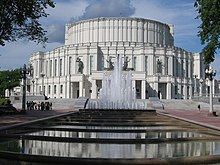
|
